

Marketing,







Marketing,







Sheng Long, your professional and trusted aquaculture partner. We are committed to supporting our valuable customers’ success by providing innovation programs with high-performance feeds, healthy shrimp larvae, aquatic probiotics & healthy products and new farming models & technology.

Add: Block A5, Duc Hoa 1 Industrial Park,Duc Hoa District, Long An Province
Tel: (84-272) 3761358 - 3779741 Fax: (84-272) 3761359
Email: thanglong@shenglongbt.com Website: www.shenglongbt.com
Add: Plot No. A-11/1, Part-A, SIPCOT Industrial Park, Thervoykandigai Village, Gummidipoondi Taluk, Thiruvallur District, Tamil Nadu 601202, India.
Tel: 91-44-6790 1001 Fax: 91-44-6790 1017
Email: info@shenglongindia.com Website: www.shenglongindia.com
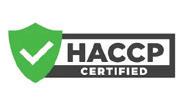




Marine Shrimp: Supply Dynamics & China


From the editor
2 Still lacking Disaster Risk Management
Industry News
4 TARS 2024: Steering Asia’s finfish aquaculture into focus
6 EAS honours Bjørn Myrseth for contributions to European and global aquaculture
Shrimp Aquaculture
8 Indonesia Shrimp Farmers Day
A need for a fresh marketing strategy and matching feeds to location and farm conditions
Feed Technology
Editor/Publisher
Zuridah Merican, PhD
Tel: +6012 205 3130
Email: zuridah@aquaasiapac.com
Editorial Coordination
Corporate Media Services P L
Tel: +65 6327 8825/6327 8824
Fax: +65 6223 7314
Email: irene@corpmediapl.com Web: www.corpmediapl.com
Design and Layout
Words Worth Media
Management Pte Ltd
Email: sales@wordsworth.com.sg Web: www.wordsworth.com.sg
AQUA Culture Asia Pacific is published bimonthly by

Aqua Research Pte Ltd
3 Pickering Street, #02-36 Nankin Row, Singapore 048660
Web: www.aquaasiapac.com Tel: +65 9151 2420
Printed in Singapore by Times Printers Private Limited 18 Tuas Avenue 5 Singapore 639342
Subscriptions
Subscribe via the website at www.aquaasiapac.com
Subscriptions can begin at any time. Subscriptions rate/year (6 issues): SGD 70, Email: subscribe@aquaasiapac.com Tel: +65 9151 2420
Fax: +65 6223 7314
Copyright © 2024 Aqua Research Pte Ltd.
All rights reserved. No part of this publication may be reproduced, stored in a retrieval system or transmitted, in any form or by any means, electronic, mechanical, photocopying or otherwise, without the prior permission of the copyright owners.
Aqua Culture Asia Pacific is a print and digital magazine.
View E-magazine & Download
PDF of past issues for free www.aquaasiapac.com
15 Health functionalities in shrimp feeds: Connecting science with field reality
By Jean-Benoît Darodes de Tailly and Thomas Denis
19 New circular economy venture in Vietnam with hydrolysates
Interview with Thomas Levallois on the commitment to upcycle seafood waste in a facility designed with sustainability at its core
22 Growth performance and digestibility in Nile tilapia fed plant diets supplemented with a new generation phytase
Growth performance of tilapia with increased phosphorus, calcium and ash accumulation levels in the whole body, bones, and scales. By Nguyen Van Nguyen, Le Hoang, Pham Duy Hai, Tran Van Khanh and David Bal
26 Understanding and mitigating the mycotoxin risks for aquaculture farmers in Asia-Pacific
Vivi Koletsi reviews occurrence of mycotoxins in feedstuffs for aquafeeds and effects on carp and whiteleg shrimp
30 Comparison between mineral-amino acid complexes and inorganic mineral supplementation on performance and health of pangasius catfish during the nursery phase
By Le Thanh Hung, Huynh Khanh Duy, Vo Thi Thanh Binh, Mihai Sun and Sutep Luengyotluechakul
Fish Aquaculture
34 Navigating the dynamics of finfish aquaculture in Asia
At TARS 2024, discussions on how the lower demand for frozen tilapia fillet affects producers in Asia and how consumers are influencing which marine fish is on the dining table
40 Marketing, branding, and sustainability of Asia’s farmed finfish
A global exchange by industry leaders at TARS Hard Talk 2024 on marketing the pangasius, tilapia and Asian seabass
Industry Review-Marine Shrimp
44 Vannamei shrimp supply outlook to May 2024
At Shrimp Summit 2024, Kontali estimated production to reach 5.7 million tonnes in 2024 and grow further to 6.1 million tonnes in 2025
46 A deep dive into China’s shrimp production
Focus on the strengths and weaknesses of the small greenhouse model at GSF 2024
Show Review
50 Asian Pacific Aquaculture 2024 in Surabaya, Indonesia
Company and Event
56 INVE Aquaculture celebrates 40 years of innovation and growth at larvi 2024
58 Customised research for alternative proteins in Wales and Singapore
60 Aqua seminar breaks down phytase and feed costs

Zuridah Merican
It is just pure coincidence that during the week of The Aquaculture Roundtable Series 2024 on Finfish Aquaculture – Steering an Industry into Focus, that the New York Times published on their front page ‘Wild West of Fish Farming’ in Chile. In 2023, farmed salmon was the second largest export of Chile generating US$6.5 billion in revenue. Chile’s National Fisheries Agency reported that 338 tonnes of antibiotics were used that year and that is detrimental to its image and to aquaculture in general.
My takeaway message from TARS 2024 was that we are still lacking a Disaster Risk Management (DRM) Protocol. We cannot speak for Chile, but we can certainly speak for AsiaPacific. The pangasius sector in Vietnam boomed in the early-2000s and there was negative publicity of pangasius fish farmed intensively in cages in the Mekong River deemed to be one of the most polluted. Tilapia gained prominence in the US market in the late 2000s and there was negative publicity that tilapia was described as an unhealthy fish
We strive to be the beacon for the regional aquaculture industry. We will be the window to the world for Asia-Pacific aquaculture producers and a door to the market for international suppliers. We strive to be the forum for the development of self-regulation in the Industry.
for human consumption. Nearly two decades later and we still hear this circulating in social media which hurts the growth and per capita consumption of both species. The problem is that this narrative has never been corrected on an unbiased and balanced scale. DRM involves prevention, preparedness, response, and recovery actions that address natural and man-made hazards.
Similarly, we do not sufficiently tell our success stories of finfish aquaculture in Asia. Leading the list for pangasius, tilapia and marine fish are Vinh Hoan, Regal Springs and Australis, respectively. Although culturing very different species, they share common traits contributing to their success. The first being that they are all integrated and control many segments of their value chain. Vinh Hoan started as a pangasius processor and exporter but today they have gone into hatchery, nursery, farming, and feed but they are also careful not to be 100% self-reliant. This allows them to benchmark against third parties to ensure there is no complacency. Vinh Hoan’s fish production only supplies 75% of their processing needs. They buy commercial feed and sell their own feed to optimise the equilibrium and ensure quality is maintained.
Regal Springs focuses on fish production to ensure cash is used in the right places. Integrating into feed production is always tempting but when there are feed companies willing to provide good quality feed with credit terms, it may be better to ‘stick to the knitting’ while only stepping into feed production for the juvenile phase. When the founder of Australis – Josh Goldman started barramundi aquaculture 15 years ago, he was adamant that he wanted to be integrated. Although, this meant a dilution of investment into the various segments of the value chain, it meant ‘keeping promises’ and allowed for control of quality all the way to the consumer, thus contributing to their tagline: ‘Better Fish, Better World’
Integration in all the above three companies allowed for traceability, transparency and sustainability which differentiated them from the competition. Freezing and processing are key to the export markets as it allows for long term storage and handling of the fish product. Francisco Murillo of Tropo Farms (ex-Regal Springs and Rain Forest) clearly stated that the tilapia took-off in the US market when it was packaged into a ready to cook, filleted and skinless product.
Nguyen Ngo Vi Tam, CEO of Vinh Hoan tells us that their current strategy is to maximise the fish value in the farmed fish complex i.e. skins for collagen, frames for fish meal and oil for the feed and biofuel industries. Efficiency is key to profitability so off-cuts are transformed, from byproducts into surimi co-products.
The call for sustainability came in the early 2000s and it started off as a ‘box to tick’ but when buyers and retailers used certifications to ensure sustainability criteria were met, Lukas Manomaitis, Aquaculture Lead at USSEC said that ‘they suddenly had teeth’ and the aquaculture value chain had to pay attention. Then over the Covid period, the process matured and now consumers are demanding sustainability.
Hard Talk in TARS 2024 has clearly shown that all our successful aquaculture companies share Marketing, Branding & Sustainability (MBS) as their narrative. If Disaster Risk management (DRM) is to be our industry’s defensive strategy, MBS should be our offensive strategy.

If you have any comments, please email: zuridah@aquaasiapac.com
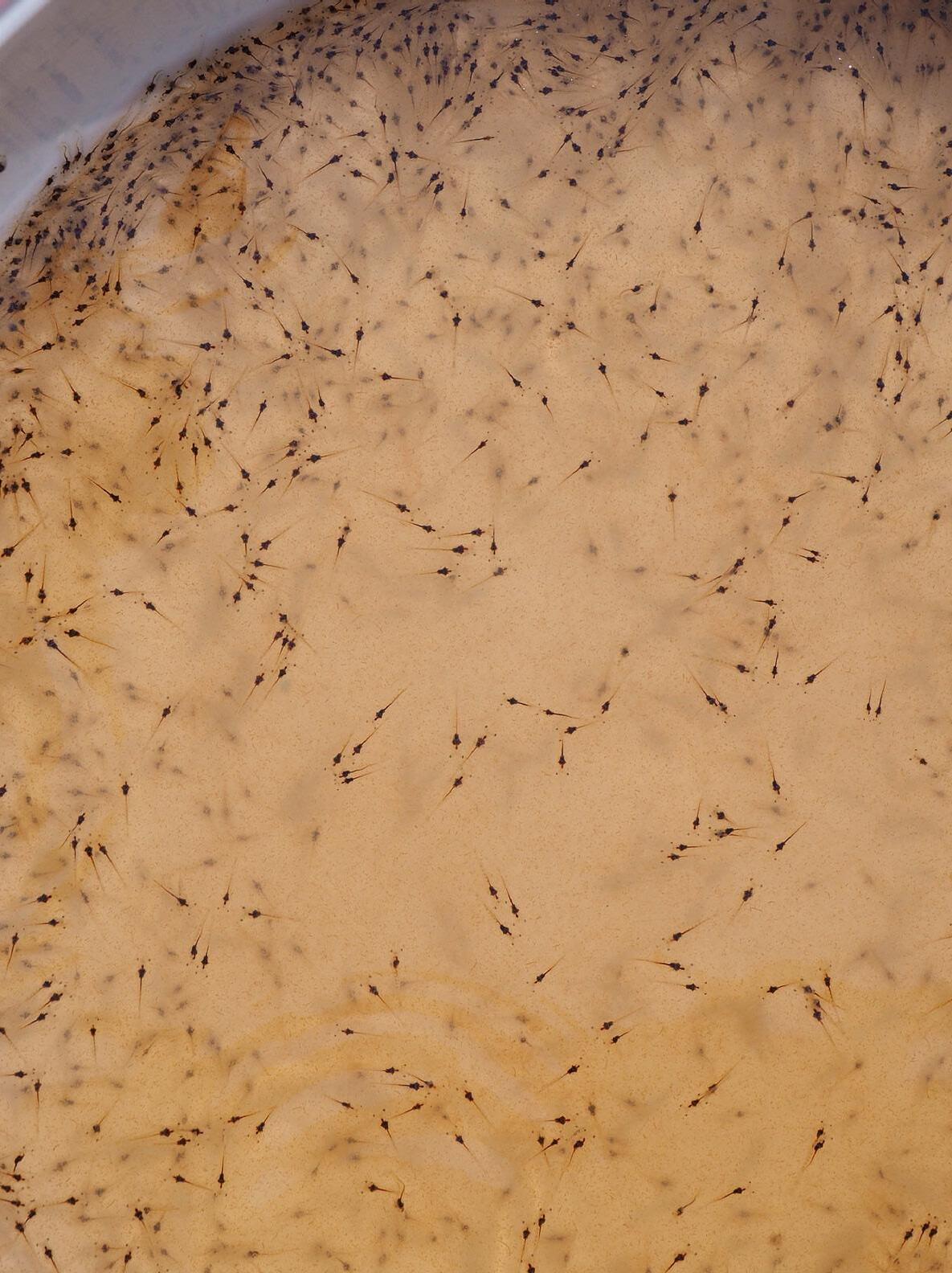
Enhancing


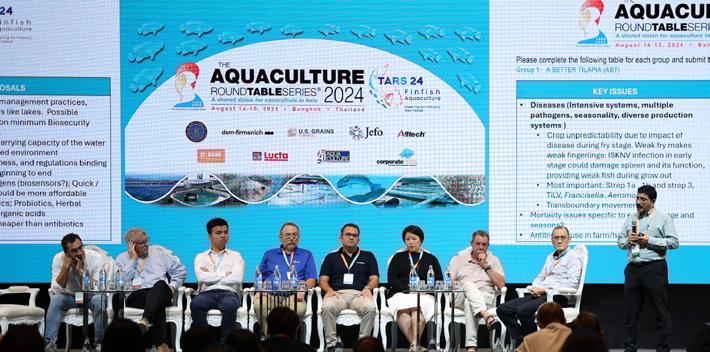
In its 13th year, The Aquaculture Roundtable Series (TARS 2024) returned to finfish aquaculture. Asia stands as the world’s largest producer of farmed finfish, contributing nearly 58 million tonnes to the global fish supply. As global demand is projected to double by 2050, producers in Asia are central to meeting this challenge. However, economic sustainability remains a key obstacle, with low farmgate prices and rising input costs squeezing margins. The market demand for quality, sustainability, and traceability adds further pressure on producers, who must balance these expectations without compromising on price.
Asia’s tilapia and pangasius face significant pricing challenges, hindering their climb up the whitefish value chain. Although Asia is a leading supplier of tilapia to the US, led by China and Indonesia, both species struggle with cyclic lows in farmgate prices, while retail prices for whitefish from Asia remain at the low and medium range. These issues present headwinds to the industry’s growth and market positioning.
In the marine segment, the industry is marked by large volumes of low-value milkfish and small volumes of high-value species like groupers. This fragmentation complicates efforts to achieve economies of scale and slows research and development in areas such as genetics, feed development, and vaccines. The contrast with Europe, where focus is placed on a few key species such as the European seabass and salmonids, amplifies the challenges posed by Asia’s multispecies culture.
Held in Bangkok, Thailand, on August 14-15, the meeting attracted 210 participants, with 72 of them from Thailand. This year’s program featured 40 speakers, tasked with navigating the multiple facets of Asia’s farmed fish industry, mainly production and supply chains for tilapia, pangasius and marine fish. TARS 2024 was organised by Aqua Culture Asia Pacific and Corporate Media Services, Singapore and this year, industry sponsors were dsmfirminech, US Grains Council, Jefo Nutrition, Alltech, BASF and Lucta.
Although Thailand is a small producer of the tilapia, it is a leader in exporting tilapia fry to 46 countries. Tilapia genetics is pursued by the private sector and the Department of Fisheries (DOF). However, farmers
At the Interactive Breakout Roundtable session, Group Leader, for “A Better Tilapia”, Dr Krishna R Salin, Asian Institute of Technology, Thailand (standing right) with table leaders, from left, Dr Roberto Cascione, Virbac Asia Pacific, Thailand; Dr Morten Rye, Benchmark Genetics, Norway; Abung Simanjuntak, dsm-firmenich, Indonesia; Hervé Lucien-Brun, Jefo Nutrition, Inc., Canada; Antonios Chalaris, Devenish, Scotland; Dr Ei Lin Ooi, Adisseo Asia Pacific, Singapore; Cameron Maclean, eFishery, Indonesia and Dr KP Chan, BASF Animal Nutrition, Asia Pacific, Singapore.
constantly face cyclic highs and lows in demand, affecting prices and margins. In his welcome message, Praphan Leepayakhun, Deputy Director-General, DOF, said, “Fish farmers are mostly small-scale. They are the backbone of our fish aquaculture industry and helping them to combat diseases, increase productivity and achieve consistent harvests is our responsibility.” He added that Thailand is strong in pond farming of the Asian seabass, producing almost 50,000 tonnes in 2022. “However, we need to focus on genetics, in the same way as we are doing for the tilapia.”

Praphan Leepayakhun, Deputy DirectorGeneral, Department of Fisheries Thailand (DOF) gave the welcome address.
While most of Asia’s finfish aquaculture is fragmented, there are a few integrated enterprises making waves globally. At the Hard Talk panel were business leaders, Nguyen Ngo Vi Tam , CEO at Vinh Hoan and Josh Goldman, Founder/CEO of Australis Aquaculture to discuss branding, marketing, and sustainability. Supporting them were Francisco Murillo of Tropo Farms, Ghana and USSEC’s Lukas Manomaitis, who offered a helicopter view on tilapia and the finfish aquaculture landscape, respectively (see pages 40-43).
The conference began with the State of Industry session, focusing on an analysis of the tilapia trade in the US, followed by directions for marine fish production in China, pangasius in Vietnam, and tilapia in Thailand (see pages 34-39).
A constant feature of the TARS program is the Interactive Breakout Roundtable session. This year, the task for participants was to build ‘de facto’ integrated enterprises for tilapia, pangasius, and marine fish. They addressed common industry issues from genetics, nursery, feed, productivity and efficiency, disease mitigation and

traceability, with the goal of driving the industry towards greater coherence and effectiveness. Some takeaways are listed below:
Retailers’ influence on consumer preferences: Retailers play a significant role in shaping consumer perceptions and demands, as seen with the promotion of salmon in Europe. This influence can extend to other species, but it also raises concerns about retailers imposing costly practices on farmers.
Need for industry pushback: While retailers can drive positive change, like promoting sustainable practices, there is a need for the industry to push back when retailers’ demands lead to increased costs or unfair burdens on small-scale farmers.
Quality and perception: Those for the pangasius and tilapia are influenced by factors like quality control and marketing. Poor practices can lead to a negative image, making it difficult to market these species, especially in regions where they are viewed as cheap or low-quality.
Importance of branding and negotiation power: Branding is crucial for improving the market position of less popular species. Only producers with strong negotiation power, can command higher prices and better market positions. Smaller producers in Asia have an unfair disadvantage.
Collaboration among stakeholders: More supply chain coordination, and collaboration among farmers, regulators, academia, and retailers is essential for improving standards, supporting small-scale producers, and enhancing the overall quality and marketability of fish species.
Education and support for small farmers: Educating small farmers on good practices is critical for preventing issues like disease and maintaining the quality of fish. Associations and cooperatives can help provide stability and fair pricing for these farmers.
Market adaptation and versatility: Species like pangasius can be marketed based on their versatility in flavour, catering to various consumer preferences. Adapting marketing strategies to emphasise these qualities can help improve their market appeal.
Changing consumer perceptions: There is a need for collective industry efforts to change negative perceptions of certain fish species, especially in regions where species like tilapia may have a poor image.
Product diversification through co-development: Better utilisation of the whole fish, improves profitability. Various products such as fish skin chips, can help diversify food options.
Importance of training farm workers: Better training of the farm workforce to ensure good farming practices, and better biosecurity, can improve fish health and performance throughout the production cycle.
Marine fish feed production: Feed millers are reluctant to produce feed for marine fish due to the continued use of trash fish, which lowers their volumes and profitability. Government intervention may be necessary to address this issue.
Low quantities hinder feed production for specific species: Low demand for feed for certain marine species, like for the grouper, makes it unprofitable for feed millers to produce specialised feeds, leading them to instead create a one-size-fits-all product.
Genetics and long-term investment concerns: On genetic improvement for the Asian seabass, once genetics selection is settled for the first founder stocks, the cycle time for the next selection is manageable. Similar to salmon, the adoption of strategies to prioritise genetic selection, despite the initial delay, was suggested.
Market development and branding for marine fish: There is difficulty in developing a premium market for marine fish due to the need for significant investment in branding and marketing. This is particularly challenging when the top species keep changing frequently.
Consumer demand vs production capability: The moot point for discussion was whether the industry should focus on producing what the consumers demand, or dictate what they should consume, especially when dealing with multiple species of fish.
Cultural preferences and market expansion: There is a cultural preference for marine fish among coastal populations in China and the need to change consumer perceptions in inland areas to expand the marine fish market. It was suggested that promoting the benefits of marine fish, similar to how chicken breast became popular for its protein content, could help achieve this.

At the opening ceremony of the AQUA 2024 event in Copenhagen, Denmark, the European Aquaculture Society (EAS) gave its highest award - Honorary Life Membership - to Bjørn Myrseth. A pioneer of fish farming in Europe and beyond, a role model for aquaculture and one of the founding members of EAS in 1976, Bjørn is the 16th recipient of this distinguished award.

Bente Torstensen, EAS President 2022-2024 presents the EAS Honorary Life Membership Award to Bjørn Myrseth at the AQUA 2024 Opening Plenary session.
AQUA 2024 was co-organised by the European and World Aquaculture Societies and attended by 3,600 participants from more than 80 countries. Bente Torstensen, EAS President 2022-2024 introduced and presented the award.
Bjørn Myrseth graduated with a master’s degree from the University of Bergen in 1971. After graduation, he became a founder of Stolt Sea Farm, specialised in the production of salmon smolts in Norway and later in Scotland, USA and Canada. Bjørn was the key driver of the company’s involvement in sturgeon farming in California.
He then looked to diversify his interests and, through Marine Farms AS, where he was CEO, made investments in Greece, Spain, UK and Chile. This was the start of Galaxidi Marine Farm in Greece and Culmarex in Spain. Marine Farms was listed on the Oslo Stock Exchange in 2006, having operations in the UK (salmon), Belize (cobia), Vietnam (cobia) and in Spain (seabass and seabream). In 2012, he was named as the Chairman of the salmon processor, Morpol, after their acquisition of Marine Farms.
Bjørn was presented with the Federation of European Aquaculture Producers “Award of Excellence” in 2011 for his “exceptional contribution to European aquaculture”. In 2013, he was presented with a lifetime achievement award by the Global Aquaculture Alliance. These are just two of his many recognitions.
Bjørn’s commitment and dedication to EAS goes back to its founding, as the European Mariculture Society in 1976, where he was a founding member and member of the Bureau. He was also the National Representative for Norway from 1976 to 1985, before coming back to the Board and becoming EAS President from 1992-1994 and then again from 2016-2018. This is the first time that EAS has had the same president for two non-consecutive terms.
Bjørn was chair of the 1993 EAS WAS World Aquaculture event in Torremolinos, Spain, and he was again the chair of the AQUA 2024 Steering Committee, 31 years later. Like all pioneers, he does not sit back on his laurels, but keeps active, keeps leading and keeps learning. He continues to be a Board member of companies across the globe and provides consulting services through his own Vitamar company.
His contribution to aquaculture is global, as described previously, and so the EAS Board considered that this EAS WAS AQUA 2024 event was the right time to honour Bjørn. He is a role model for aquaculture.
Honorary Life Membership of EAS is an award given to someone that has made a significant impact on the development of European aquaculture. Since 1981, EAS has given this award to very few persons, including Eric Edwards, Peter Hjul, Colin Nash, Courtney Hough, Pascal Divanach, Patrick Sorgeloos, Michael New, Sachi Kaushik, Stefano Cataudella and László Varadi.
ROBUSTNESS AND DIGESTIVE SYSTEM INTEGRITY +
PERFORMANCE
Partnering in microbial solutions for a changing world. Using sound science, proven results and knowledge from experience, Lallemand Animal Nutrition helps our customers and industry partners be more successful – and animals lead healthier lives.
Lallemand Animal Nutrition provides a full range of speci c, natural microbial products, services and solutions that improve animal well-being and performance while respecting animals, people and the environment.
A need for a fresh marketing strategy and matching feeds to location and farm conditions

There was a special program for Indonesian shrimp farmers during Asian Pacific Aquaculture (APA 2024) in Surabaya on July 4. This was organised by Shrimp Club Indonesia (SCI) for its members as well as other conference and trade visitors. The aim was to provide updates on the latest on the global demand and supply for vannamei shrimp and on shrimp feed technology and farm management.
Established in 2005, SCI aims to keep its members informed about the latest developments in the shrimp industry both locally and globally. The organisation provides a platform for shrimp farmers to exchange knowledge, discuss challenges, and collaborate on solutions. They also host events such as national meetings, seminars, and symposiums to promote sustainable shrimp farming practices. It was formed by a merger of two regional shrimp farming communities, the Lampung Shrimp Club (SC Lampung) and the East Indonesia Shrimp Club (SC Intim). Currently SCI has more than 15 representatives in various regions from western to eastern parts of Indonesia and continues to grow.
In 2023, SCI President, Haris Muhtadi estimated that Indonesia’s vannamei shrimp production was 265-275,000 tonnes. Exports in 2023 was estimated at 209,065 tonnes (GSF, 2024). “The challenging US market is a pain point for our shrimp farming industry since >70% of production goes to the US. With demand low in both the US and EU, market access is an issue our farmers are beginning to be aware of. For several years, we have been contented with the US market, a market which our processors are so familiar with. The US market merely demands low prices and does not focus on quality. Change is required if we need to seek alternative markets.”
Farmgate shrimp prices have fallen below pre-Covid levels and to two-decade lows. This is the biggest worry on the minds of all shrimp farmers. Ronnie Tan , Aquaculture Consultant, US Grains Council provided a summary of the demand, supply and price outlook. He set the scene for this session with an outlook on the global shrimp situation and outlined some positives and negatives in the current situation with shrimp markets. Noting the aim of the meeting, Tan gave tips on how the Indonesia’s shrimp industry could move forward.
Rabobank compared the relative prices of shrimp against a basket of animal proteins between January 2020 and January 2024. They found that shrimp prices were relatively cheaper at the wholesale level, but this was not reflected in the retail market yet and may have a lag time of 9-12 months. The largest markets are China, the US, EU+UK and Japan and shrimp is a very price elastic product. “China recorded nearly one million tonnes of shrimp imports in 2023 but with lower aggregate prices and Ecuador supplied 72%. YTD May 2024, volumes have eased 5% compared to the previous year. China’s secondary home prices fell again in May, and this dents consumer confidence. The US imported nearly 800,000 tonnes in 2023 and in May 2024, although seafood prices have eased 6.3% (Y-o-Y), general affordability remains a key issue,” said Tan.
The supply side has been the key disruptor as Ecuador has doubled production over the past 5 years. Global shrimp production in 2023 reached 5.15 million tonnes (Global Seafood Marketing Conference 2024) led by Ecuador, China, India, Vietnam and Indonesia. Ecuador expects single digit growth in 2024 due to slow demand and lower prices. China’s demand remains the big question while the US antidumping (AD) and countervailing duties (CVD) rates will hurt sales. There is also a big concern with national insecurity.



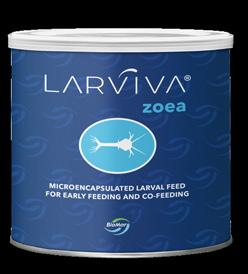

So, what is Indonesia’s challenge? Indonesia’s major exports are to the US at 70% and to Japan at 16% demanding mainly PD (peeled deveined) and HLSO (headless shell on) respectively but the US has recently imposed AD and CVD rates on most companies at a combined rate of 6.3%. The China, EU+UK markets are relatively untapped by Indonesia but the EU+UK demand strict certification. While China is a closer proximity market requiring less certification, the demand is for head on shell on (HOSO) product.
“However, Indonesia’s ‘soaking’ practice will not meet EU+UK and China’s specifications. Hence, of the four major markets totalling 2.6 million tonnes, Indonesia can only play in two i.e. a limited 38% of global market. To create a new marketing strategy, the farmers and processors will have to work together to find the right product for the new markets,” said Tan.
“The forecast for demand shows some US growth dependant on lower retail prices but China’s economy cannot lift demand further. Supply will not contract despite low prices. Ecuador’s growth is slowing but from a large base. Hence low prices will remain as domestic demand growth will take time. For Indonesia to remain competitive, productivity and efficiency will also be key.”.
Anwar Hasan , General Sales Manager, Shrimp Feed, West Area at CJ Feeds gave some perspectives on the current concerns with shrimp farming in Indonesia and on the role of feed millers to optimise shrimp growth performance and efficiency. “Within this industry, we need to understand why farms are not performing. In Indonesia, particularly in Sumatera and Java, only 3040% of farms are operating,” said Anwar.
Starting with the concerns of the industry in Indonesia, Anwar related this to global trends. In the 2021 Goal survey, market prices were the key concern for 2022. In contrast, in the 2022 survey for 2023, aquafeed costs rose to be the main concern. “However, we are in 2024, and we know that for today, the concern is low shrimp prices which are expected to remain stagnant for the next few years.” In Indonesia, July prices for size 50 have hovered around IDR65,000/kg (US$4.21). Anwar added, “For us in Indonesia, we focus on the US market which is now very difficult with India and Ecuador as competitors. For the EU markets, access is difficult.”
Some 2-3 years ago, acute hepatopancreatic necrosis disease (AHPND) began to affect farms. But although survival rates were 50-60%, with higher prices, margins were good for farms. In Indonesia, when compared to 2022, when the price was still acceptable, shrimp prices in 2024 declined to US$1-1.5/kg for size 50.
Anwar described the approach at CJ Feeds in feed development. Sustainability is important and using renewable plant protein meals and alternative protein and oil products is the new direction. Nevertheless, for any ingredient, the considerations are cost, availability, supply, consistency, palatability, digestibility, nutritional value and anti-nutritional factors. “At CJ, we focus on nutrient balance to promote growth. There is the amino acids balance and palatability and when plant meals are used, protein hydrolysates and krill meal come into the formulation. Other considerations are digestibility, health care with nucleotides, and organic acids for intestinal immunity.
The optimal requirement for protein in the feed of vannamei shrimp depends on shrimp stage and the size of the shrimp. Anwar emphasised the difference between a good protein composition with the right balance of amino acids versus just high crude protein with free nitrogen with consequential effects on the pond environment.
Common ingredients in shrimp feeds in Indonesia are fish meal, soybean meal, squid liver powder, fish oil, squid oil, lecithin, protein hydrolysate, vitamin and minerals, acidifier, antioxidant and toxin binders.
Disease may change the feed strategy. “We need to heed global warming and rising sea water temperatures. The increase in disease outbreaks caused by Vibrio harveyi reflects not higher cell fitness of the Vibrio bacteria, but rather an increase in virulence with toxin release to escape from adverse environments to nutrient rich host pathogen environment.
“We know that feeds with 38% crude protein (CP) give good results with good pond and feed management. In 90 days of culture, we get size 27 at a survival rate of 87% at a stocking density of 147 post larvae (PL)/m2. However, in East Java, a feed with 32% CP can produce size 40/kg after 89 days with a feed conversion ratio (FCR) of 1.2 at stocking density of 132 (PL)/m2. In Situbondo, where farmers are challenged with diseases, even 30-32% CP feed are working well to produce size 44/kg at FCR of 1.2, at a stocking density of 115 PL/m2.” The message is that matching feeds to location and farm conditions is crucial.


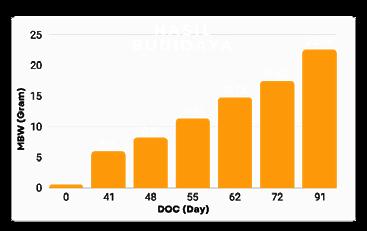
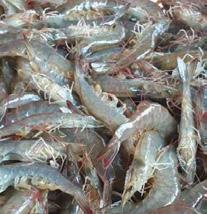
Figure 1. Shrimp growth performance by feeding CJ’s Super Innovative feeds with 30-32% CP in Situbondo, East Java. Extracted from the presentation by Anwar Hasan on Role of feed mill to optimise shrimp growth performance and efficiency.
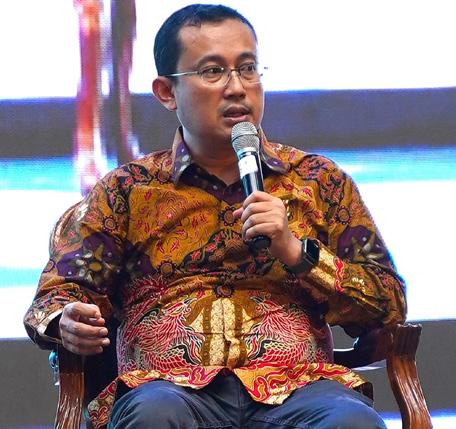
Anwar Hasan said that “ improvement in feed efficiency is not only to reduce production costs but also to reduce environmental impact of feeds and improve animal performance and its health status.”
Feeds account for 60% of the costs of production and when this increases to 70%, there should be a cause for concern. According to Anwar, improvement in feed efficiency is not only to reduce production costs but also to reduce environmental impact of feeds and improve animal performance and its health status.
“We need an assessment along the supply chain, from broodstock to health care. We know that for most farms in Indonesia, it is challenging to find solutions when facing disease outbreaks. However, some have been farming since 1990’s and they have survived.
“Furthermore, these farmers have made large investments and therefore, the feed miller has the critical role to support them to achieve success, including improving or changing husbandry practices, using functional additives in feeds as well as other interactions such as with the environment and broodstock. With current field situations, feed formulae, type of feeds and feeding strategies must be based on farm conditions including season, and disease challenges.”
Shrimp prices are low globally and this is also affecting shrimp farmers in Ecuador. “In 2024, Ecuador vannamei shrimp production is projected to grow 4-6% to 1.275 million tonnes, although values may fall to 5.5% and profits plummet. With low prices, how are farmers managing the cost of production via feeds and feed management? For certain, we know that the approach is entirely different than that in Asia and in Indonesia,” said Dr Aberto Nunes, Professor at Labomar in Brazil in his presentation titled “Cost effective and sustainable shrimp feeds with low levels of krill meal”.

Nunes cited that the cost of production (COP) for size 30/40 per kg shrimp in Ecuador varies between two categories. COP in small and medium size farms is US$3.09-3.30/kg and for large farms and integrators, it is US$2.87/kg. In April, the farmgate prices by two of the 10 major exporters ranged from US$3.40-3.60/kg for size 30-40/kg shrimp and US$3.10-3.30/kg for size 4050/kg shrimp. Therefore, for smaller farms, shrimp is a loss-making operation. Large companies which are able to absorb the low prices are taking over the small/medium size farms. But those in operation have taken some steps. “The smaller farms addressed low prices by changing to focus on larger shrimp, 28-33g shrimp instead of producing 20-25g shrimp to leverage on better prices. They have also reduced stocking density to 11-12 PL/m2 to have faster growth, in excess of 0.43 g/day.”
Economy and low protein feeds
These feeds contain 22,25,28,30,32 or 35% CP. In Ecuador, there are both pelleted and extruded feed, and the latter can support more than 50% soybean meal which can bring more than 15% reduction in prices when compared to an equivalent % CP feed. “By reducing % CP from 35 to 28, the price reduction is almost 8%. Generally, we see that farmers start with 42-35% CP feeds from PL10 to 3g shrimp. Then it is 35% CP feeds for 3 to 8g and then economy feeds from 8g to harvest.”
Extruded feeds and auto feeders
Nunes deliberated on why industry in Ecuador favours extruded feeds. “Firstly, major feed millers have vast knowledge on extrusion based on experiences with salmon feeds. There is vast experience with mechanical feeders such as timed and acoustic devices, and the extruded feeds have resistance to physical stress caused by such feeders.”
A study by Molina et al., in 2021 showed that the feed conversion ratio (FCR) was better with extruded feeds, at 1.67 versus 1.96 with pelleted feeds. Production of shrimp/ lb using acoustic technology to feed shrimp was US$1.58 with pelleted feeds and US$1.30 with extruded feeds as compared to US$1.61 for manual feeding of extruded or pelleted feeds.
It was changing needs that prompted a change to mechanical feeding. “Farms moved from feeding two times a day to 24-hour feeding and auto feeders became the tool among large and medium size operations. Our estimate is 25-30% of the 220,000ha of ponds use auto feeders.” Other benefits of this change include reduced leaching of feed and labour costs. There is a drastic improvement on FCR and yields such as from 1.3 tonnes/ha to 4.5 tonnes/ha with 3-4 crops a year.
Nunes discussed the benefits of acoustic feeding technology, supplied by three companies in Ecuador. These include real time feeding responses to dissolved oxygen levels and water temperature in ponds. “Prior to using these devices, farmers have guessed that they have been underfeeding their shrimp and this might have been one of the reasons for previous slower shrimp growth rates. Acoustic feeding systems are viable when stocking density is more than 20 PL/m expensive for lower yields. The system can detect shrimp chewing feed when they are more than 3g sizes, but recent research has shown that shrimp sounds are detectable even at post larvae sizes.”
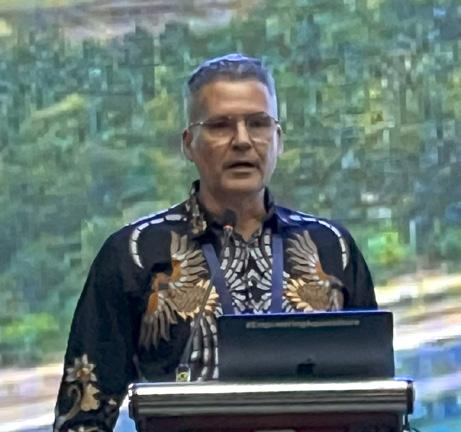
Alberto Nunes said that “ the use of high levels of soy protein sources in shrimp feeds can be cost competitive. The beauty of using plant protein meals is its predictability and consistency, but formulation must be on a digestible basis for all nutrients.”
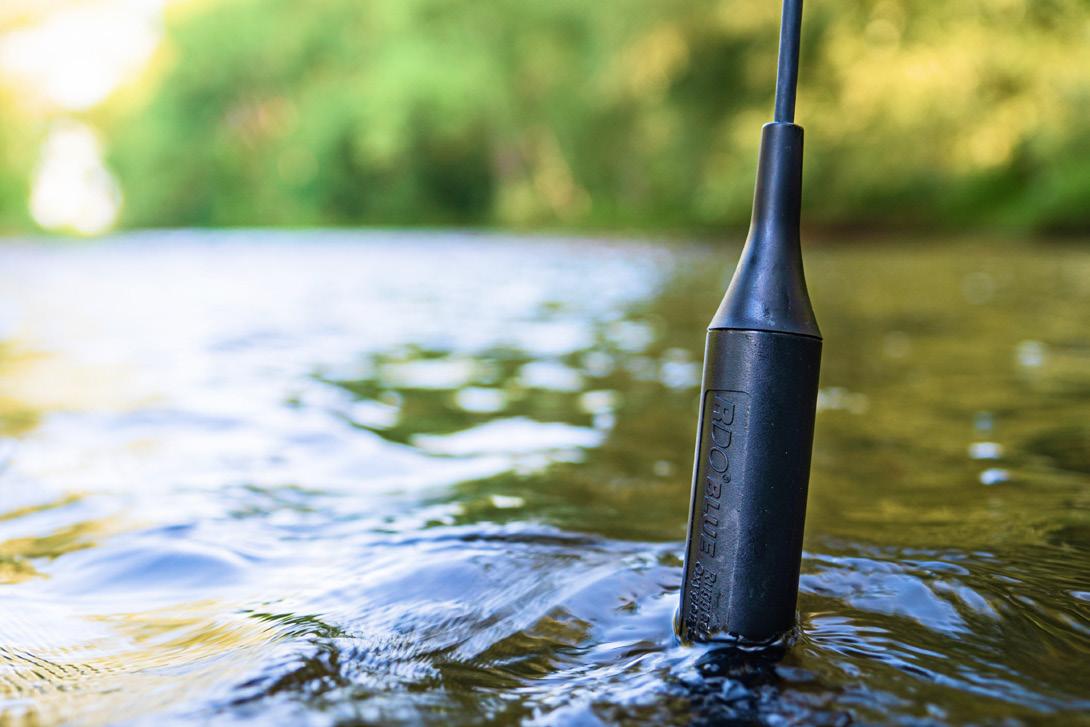
While feeding management has made an impact on production growth, the other development is in feed formulation.


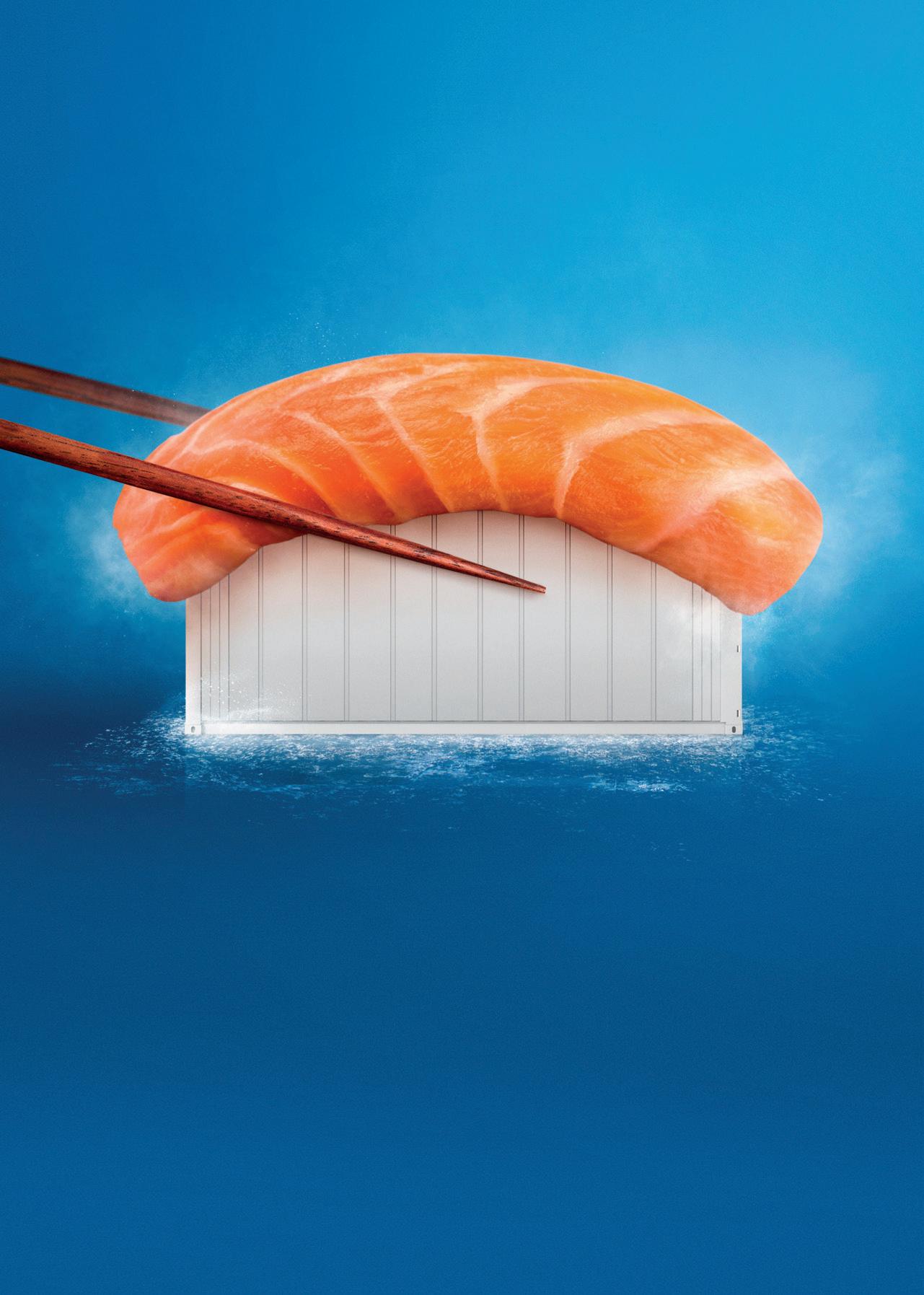
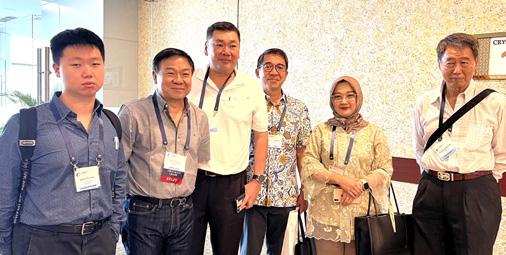
Iwan Sutanto, Past President of SCI (second left) and Dr Yuni Puji Hastuti, IPB University-Bogor (second right) with some shrimp farmers, from right, Soewando Basoeki, Abu Jasin Sutanto, Ricky Li (Sumatra SCI) and Edbert Thomas.
Today, commercial feeds in Ecuador contain fish meal at levels not exceeding 6%. Local fish meal is used and contains 48-60% CP, derived mainly from byproducts (trimmings) where the concerns are freshness, biogenic amines and consistency in quality such as amino acids which drive shrimp growth. Imported fish meal from Peru and Chile has 62-68% CP. “Soy based feeds are just popular. The 35% CP feeds may have less than 4% marine proteins, including fish meal, and almost 80% plant meals or almost 6% marine proteins and 72% plant protein meals. For farmers, economics matters and it is more on knowing that fish meal can be replaced with cheaper protein sources with no compromise on shrimp performance.”
Unfortunately, plant protein diets with low levels of fish meal and 1.5% fish oil require good sources of attractants. The inclusion of methionine, a crystalline amino acid works but a recent study showed its leaching rates were proportionate to its inclusion levels in feeds. Thus, feed attractants and palatants are essential to increase speed of feed consumption.
Nunes highlighted the requirement of krill meal in low fish meal feeds. “Much of the previous work done on the effectiveness of krill meal was carried out with diets deprived of or with very low levels of fish meal. Many studies showed that krill meal acts as a strong feed and growth enhancer at 3% dietary inclusion for juvenile shrimp. However, when combined with higher inclusion levels of fish meal, beyond 6%, our recent work has found that even 1.5% krill meal can be as effective as higher levels. This is partly explained by the fact that fish meal, like krill meal, also carries critical nutrients and chemical drivers for shrimp feeding stimulation and shrimp growth. This corresponds with the industry’s ongoing trend to achieve cost efficiency through the reduced utilisation of critical resources.
“The use of high levels of soy protein sources in shrimp feeds can be cost competitive. The beauty of using plant protein meals is its predictability and consistency, but formulation must be on a digestible basis for all nutrients.”
Other presentations in feed management included a mini review on functional feeds and additives by Professor Kyeong-Jun Lee, Jeju National University, South Korea. Lee also provided recommended levels for vitamin C and E at 60-90mg/kg and 60-80mg/kg, respectively. Others were Bacillus species of probiotics at 105-109 CFU/g, prebiotics and synbiotics. The recommended doses for organic acids were given for succinic acid at 0.5% and malic acids at 0.2%. For ß-glucans, it was around 0.2% and nucleotides at 0.1-0.4%.

Dr Matthew Briggs, Ridley Feeds, Australia introduce the product NovaqproTM, a novel sterilised microbial biomass developed by CSIRO and now marketed by Ridley AgriProducts for global markets except for China and Vietnam.
Haris said, “It is not easy for Indonesia to maintain status quo with the US markets. Today, we have to think differently, put more emphasis on quality and move to non-traditional markets like China. All shrimp farms need Indonesia’s good aquaculture management practices (CBIB) and for Europe, we need to strive for Aquaculture Stewardship Council (ASC) Furthermore, getting EU certification is an industrypublic task. We still have hope for the future but need to acknowledge that competition is strife.”

By Jean-Benoît Darodes de Tailly and Thomas Denis
The progressive intensification of shrimp production systems, driven by a growing market demand and land constraints, has inadvertently created ideal conditions for pathogens to thrive. The shrimp industry contends with a wide range of pathogens, including bacteria, viruses, fungi, and parasites which are often associated with intricate disease dynamics and symptoms, making diagnosis complex and treatment costly.
There are also no effective treatments against some of the most important shrimp pathogens such as the white spot syndrome virus and Enterocytozoon hepatopenaei (EHP) which can lead to unpredictable harvests and significant financial losses. Given these challenges, there is growing interest in preventive strategies that enhance shrimp’s natural defense mechanisms and improve their ability to cope with the conditions that may promote disease outbreaks.
fiction?
The reality often shows that despite investments in high-quality feed, disease-free post larvae (PL), water disinfection, and other biosecurity measures, pathogens continue to infiltrate shrimp farming systems through various means. Once pathogens enter a farm, their rapid spread can be exacerbated by the warm temperatures required for shrimp farming and the aqueous environment, which is an ideal medium for pathogen transmission and multiplication.
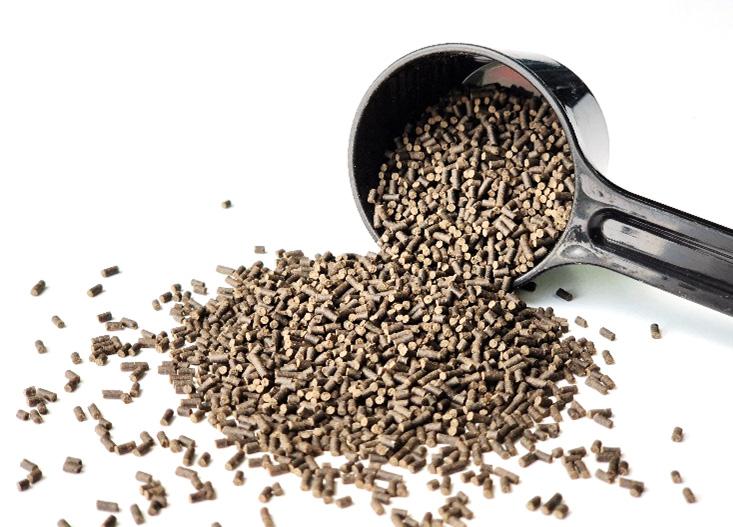
together with adverse conditions exacerbated by the e=ects of climate change, can be important vectors of stress and compromised immunity further adding to the susceptibility of shrimp. Jiang et al. (2005) demonstrated that suboptimal oxygen concentrations could lead to notable decrease in haemocytes, the shrimp’s primary immune cells. Similarly, Wang and Cheng (2005) found that abrupt salinity shifts could also compromise shrimp immune defenses within hours, favouring Vibrio alginolyticus infection (Figure 1). Once infected, shrimp have limited adaptive immune responses, and no commercial vaccines are currently available to protect them against future infections.
Shrimp sensitivity to pathogens stems from a variety of inherent characteristics. For instance, shrimp naturally inhabit the pond bottom, constantly coming into contact with substrates and potentially pathogenic microorganisms. Regular moulting also makes shrimp more susceptible to infections and parasites during this critical period. Additionally, and unlike mammals and some fish species, shrimp lack an acidic stomach barrier that could offer protection against pathogen entry.
Concurrently, the shrimp industry has gradually shifted towards more intensive practices. The higher densities and frequent variations of water quality encountered in such systems, together with adverse conditions exacerbated by the effects of climate change, can be important vectors of stress and compromised immunity further adding to the susceptibility of shrimp. Jiang et al. (2005) demonstrated that suboptimal oxygen concentrations could lead to notable decrease in haemocytes, the shrimp’s primary immune cells. Similarly, Wang and Cheng (2005) found that abrupt salinity shifts could also compromise shrimp immune defenses within hours, favouring Vibrio alginolyticus infection (Figure 1). Once infected, shrimp have limited adaptive immune responses, and no commercial vaccines are currently available to protect them against future infections.
This situation has led farmers to increasingly rely on functional additives by manually top coating them onto commercial feeds during their culture cycles. While
Time elapsed (h) 5 ppt 15 ppt 25 ppt
Figure 1. Impact of salinity on total haemocyte count of whiteleg shrimp Litopenaeus vannamei (adapted from Wang and Cheng, 2025).
this method has been effective in managing disease outbreaks, directly incorporating additives into the feed formulation offers a more reliable solution. It ensures precise dosage, consistent mixing and minimises the risk of water leaching of additives allowing for lower inclusion rates with the same effectiveness. Additionally, this approach simplifies administration, reduces the risk of fraudulent or low-quality additives entering the farm, and provides feed manufacturers with an opportunity to convert farmers into consistent users of functional feeds. With the professionalisation of farm management practices over the past decade, there is now greater potential for developing advanced, measurable functional feed concepts, provided there is a solid understanding of the physiological mechanisms required to achieve the desired outcomes.
Unlike many other farmed animals, our understanding of the shrimp immune system remains rudimentary. The existing knowledge is scattered across a wide range of literature, which can be confusing and present limitations for developing effective functional feed concepts.
In practical terms, shrimp natural defenses comprise three main barriers, each of which can be actionable with the right approach. The first barrier is the overall physiological and antioxidant status, which involves maintaining cellular health and mitigating oxidative stress caused by reactive oxygen species. This ensures robustness and less susceptibility to an infectious event. The second barrier is the epithelial layer, which serves as a physical barrier.
This barrier includes the shrimp’s cuticle, gills, gut lining, mucus, and microbiota. Maintaining the integrity of the epithelial layer effectively prevents pathogens from entering the body cavity and spreading within the shrimp. If pathogens evade these initial defenses, the immune system forms the third and final barrier. The immune system of shrimp relies on innate responses mediated by haemocytes - the shrimp’s immune cells. These cells coordinate and execute various humoral and cellular defense mechanisms that work together to control and eliminate pathogens.
Strategic interventions can be implemented to support and optimise these three barriers. Antioxidants are regularly used to block oxidative chains and the excessive production of free radicals. Bioactive compounds and probiotics can be added into feeds to improve gut health and integrity by acting against pathogens and reinforcing the barrier it forms with
the external environment. Immunostimulants are also commonly used to boost the production and activation of immune cells, enhancing immunity by fortifying both its cellular and humoral components.
While these strategic interventions are not silver bullets against pathogens in shrimp farming, they remain an important part of an integrated management approach that helps mitigate infection risks and severity. They should be viewed as complementary tools within a broader strategy that includes good farming practices, biosecurity measures, and regular monitoring, as described in Figure 2.
Developing a shrimp diet is a complex process that involves considering the nutritional needs of shrimp at different life stages, selecting appropriate raw materials, and optimising the physical parameters of the pellets. The goal is to create effective diets at minimal cost while ensuring consistent performance.
The industry typically evaluates diet efficiency using parameters such as feed intake, growth, feed conversion ratio (FCR), and cumulative mortality. However, moving forward, it is essential to also consider the other benefits of specific diets on a broader range of parameters, particularly those related to health. This is crucial because, while achieving low FCR through highquality feed is important, disease outbreaks can have a much more severe impact on farm economics at harvest.

The concept of balancing performance with health can be compared to recent advancements in salmon and shrimp genetics. While selection for rapid growth has its limitations, incorporating more parameters into genetic selection has led to lines that perform better under challenging conditions. A similar multi-parameter approach could now be applied to shrimp feed.
E>ectiveness of tailored functional feeds
Table 1 illustrates this by modelling the effects of changing FCR and/or survival rates on an average Litopenaeus vannamei farm in Vietnam. Unfortunately, assessing diet performance is often constrained by limited resources, and health considerations are not always prioritised. However, these can often be addressed cost-effectively with the right functional approach.
To illustrate the value of this approach, Phileo by Lesa=re conducted a large-scale commercial trial to evaluate the e=ectiveness of tailored functional feed concepts. These concepts, developed and validated under laboratory conditions, were tested to determine their impact on economic performance in real farming conditions. The trial was conducted in a cluster of corporate farms near Guayaquil, Ecuador, covering 101 hectares of commercial shrimp ponds and compared the performance of shrimp fed with a functional diet against those fed with a conventional diet over a full culture cycle.
The functional feed included Safmannan®, a yeast postbiotic from Phileo by Lesa=re, rich in beta 1.3 – 1.6 glucans and mannans, and Selsaf®, Phileo’s organic selenium-enriched yeast. These components were blended synergistically to support the three primary health barriers previously discussed in this article. Both solutions were incorporated into the feed at dosages of 0.5kg (Safmannan®) and 0.1kg (Selsaf ®) per tonne of feed, to mitigate the potential negative e=ects of pathogenic threats and oxidative stress.



Phileo’s probiotics and active yeast fractions are designed for hatcheries and growing farms to support health, feed efficiency and growth performance . Our sustainable solutions bring innovative responses to fishmeal reduction stakes and environmental challenges. Act with nature for animal care.
Figure 3. Enhanced shrimp performance with supplementation of Safmannan® and Selsaf®, compared to the control as indicated by (A) survival, (B) feed conversion ratio (FCR) (mean ± S.E.).
The concept of balancing performance with health can be compared to recent advancements in salmon and shrimp genetics. While selection for rapid growth has its limitations, incorporating more parameters into genetic selection has led to lines that perform better under challenging conditions. A similar multi-parameter approach could now be applied to shrimp feed.
Figure 3. Enhanced shrimp performance with supplementation of Safmannan® compared to the control as indicated by (A) survival, (B) feed conversion ratio ± S.E.).
cost reduction resulted in an increased profit margin of US$409/ha. The proposed solution hence yielded US$100 of returns per tonne of feed, for an initial investment of US$4/tonne of feed for both functional additives, equivalent to an ROI of 1:25.
improvements in survival could be expected. Nonetheless, FCR improved from an average of 1.78 in the control group to 1.60 in the supplemented group (Figure 3B).
Although no specific health parameters were recorded during production, this improvement in FCR is likely due to an overall enhancement in the health status and gut health of the shrimp throughout the production cycle. Consequently, production costs decreased from an average of USD 4 per kilogram of shrimp in the control group to USD 3.6 per kilogram of shrimp in the supplemented group. This cost reduction resulted in an increased profit margin of USD 409 per hectare. The proposed solution hence yielded USD 100 of returns per tonne of feed, for an initial investment of USD 4 per tonne of feed for both functional additives, equivalent to an ROI of 1:25
The inclusion of Safmannan® and Selsaf® resulted in an increase in survival rates average of 50.3% in the control group to 54.3% in the supplemented group (Figure Given the absence of any clear infectious events during the culture cycle, moderate
A guide on functional additives
These results highlight the substantial performance gains achievable through functional feed concepts, even in the absence of clear pathogenic threats. They also demonstrate how improved health can enhance the nutritional performance of conventional diets under commercial conditions with minimal investment in the formulation.
These results highlight the substantial performance gains achievable through functional feed concepts, even in the absence of clear pathogenic threats. They also demonstrate how improved health can enhance the nutritional performance of conventional diets under commercial conditions with minimal investment in the formulation.
Figure 3. Enhanced shrimp performance with supplementation of Safmannan® and Selsaf®, compared to the control as indicated by (A) survival, (B) feed conversion ratio (FCR) (mean ± S.E.).
To support shrimp producers in implementing functional solutions, Phileo by Lesa=re developed Aquasaf Shrimp, a comprehensive program o=ering practical guidance on using fermentation solutions to improve health mechanisms and performance of shrimp.
The inclusion of Safmannan® and Selsaf® resulted in an increase in survival rates from an average of 50.3% in the control group to 54.3% in the supplemented group (Figure 3A).
To illustrate the value of this approach, Phileo by Lesaffre conducted a large-scale commercial trial to evaluate the effectiveness of tailored functional feed concepts. These concepts, developed and validated under laboratory conditions, were tested to determine their impact on economic performance in real farming conditions. The trial was conducted in a cluster of corporate farms near Guayaquil, Ecuador, covering 101 hectares of commercial shrimp ponds and compared the performance of shrimp fed with a functional diet against those fed with a conventional diet over a full culture cycle.
Given the absence of any clear infectious events during the culture cycle, moderate
This program is built from a decade of research and development in yeast and bacteria, probiotics, and postbiotics.
The functional feed included Safmannan®, a yeast postbiotic from Phileo by Lesaffre, rich in beta 1.3-1.6 glucans and mannans, and Selsaf®, Phileo’s organic selenium-enriched yeast. These components were blended synergistically to support the three primary health barriers previously discussed in this article. Both solutions were incorporated into the feed at dosages of 0.5kg (Safmannan®) and 0.1kg (Selsaf®) per tonne of feed, to mitigate the potential negative effects of pathogenic threats and oxidative stress.
To support shrimp producers in implementing functional solutions, Phileo by Lesaffre developed Aquasaf Shrimp, a comprehensive program offering practical guidance on using fermentation solutions to improve health mechanisms and performance of shrimp.

It features case studies conducted with numerous institutes and commercial partners around the globe and integrates results from relevant published papers A detailed user manual accompanies the program, and can be downloaded using the QR code or https://phileo -lesa=re.com/en/program-aquasaf-shrimp/
References are available on request.
This program is built from a decade of research and development in yeast and bacteria, probiotics, and postbiotics. It features case studies conducted with numerous institutes and commercial partners around the globe and integrates results from relevant published papers. A detailed user manual accompanies the program, and can be downloaded using the QR code or https://phileo-lesaffre.com/en/programaquasaf-shrimp/
The inclusion of Safmannan® and Selsaf® resulted in an increase in survival rates from an average of 50.3% in the control group to 54.3% in the supplemented group (Figure 3A). Given the absence of any clear infectious events during the culture cycle, moderate improvements in survival could be expected. Nonetheless, FCR improved from an average of 1.78 in the control group to 1.60 in the supplemented group (Figure 3B).
Although no specific health parameters were recorded during production, this improvement in FCR is likely due to an overall enhancement in the health status and gut health of the shrimp throughout the production cycle. Consequently, production costs decreased from an average of US$4/kg of shrimp in the control group to US$3.6/kg of shrimp in the supplemented group. This
References are available on request.


Jean-Benoît Darodes de Tailly is Global Program Manager for Aquaculture – Phileo by Lesaffre Email: j.darodesdetailly@phileo.lesaffre.com
Thomas Denis is Technical & Feed Formulation Services Manager – Phileo by Lesaffre
A conversation with Thomas Levallois on the commitment to upcycle seafood waste in a facility designed with sustainability at its core, featuring the latest innovations and green technology solutions
There are two buzzwords in the aquaculture industry today - circular economy and sustainability. Aquaproducts Pte Ltd, is committed to transforming the seafood industry’s byproducts into valuable resources through cutting-edge innovations and green technology solutions. Its mission is to establish a robust, eco-friendly supply chain for marine functional proteins in Southeast Asia.
A decade ago, Thomas Levallois and François Dupuis, two French agrifood engineers co-founded Aquaproducts to use their expertise in enzymatic hydrolysis to maximise the use of local resources and support the circular economy. Aquaproducts has accumulated a decade of experience in marine bioextracts to manufacture functional peptides extracted from seafood byproducts, providing a sustainable source of alternative proteins for the feed industry. It is claimed that this reduces dependency on imported ingredients, strengthens regional supply chains, and creates new market opportunities.
Furthermore, the team has built strong partnerships with industry leaders, such as Scanbio SAS Norway and Maqpro Biotech Indonesia, reinforcing their sector position. Additionally, Aquaproducts is pursuing collaborations with European biotech firms to develop biopolymers from shrimp shells
The green field facility in Long Anh province in Vietnam’s Mekong Delta, is a major milestone after years of commitment. The opening event on June 11 also highlighted its role in promoting high-quality, locally-made ingredients. It is contributing significantly to the local economy with a promise to create hundreds of jobs. (see issue July/August page 61 https://bit. ly/47vq0KQ)
The new state-of-the-art facility is said to be designed with sustainability at its core, featuring solutions to ensure efficiency and environmental responsibility. The factory aims to produce 10,000 tonnes of powder and upcycle over 50,000 tonnes of seafood waste annually. The 2,500m2 site is close to raw material sources, clients, and major exportation ports. The facility incorporates innovative drying technology, a zero-waste policy, water recycling systems, advanced 3-stage odour treatment, and a comprehensive wastewater facility. Dupuis emphasised that the goal is not just to recycle waste and produce great products, but to do so responsibly without creating new sources of pollution.

Leiber ® Beta-S
Highly purified ß-glucans | Immunity booster | Increased resilience | Improved vaccinations
Leiber ® Beta-S Plus
The ß-glucan alternative | Synergistic blend of pure ß-glucans and MOS
In an email conversation, Thomas Levallois elaborated on the company’s journey, its products and plans for the future. Levallois, with a master’s in aquaculture and a BSC in agro-economics has more than 15 years of experience in sales and marketing of marine functional ingredients for the feed industry, with a few partnership (joint ventures) set-ups.

Thomas Levallois is now Director at Aquaproducts Pte Ltd. Previously, he was the Director of Sales at Diana Aqua, now a branch of the Symrise group. In 2014, he co-founded Aquaproducts Ltd, a consulting and trading company and later in 2016, he set up Maqpro Biotech Indonesia, a factory producing marine hydrolysate and chitin.
Tell us more about your journey with the circular economy project?
Thomas Levallois: Francois Dupuis and I started with consulting and trading services to promote alternative proteins produced from marine byproducts. Our first industrial project in Indonesia in 2016 set the stage for what was to come next. By 2020, we had valued over 20,000 tonnes of seafood waste, producing 5,000 tonnes of protein hydrolysate annually for the domestic market.
In 2021, the company welcomed two seed investors, Jean-Yves Chow and Marc Le Poul, who brought a wealth of expertise, network and support. This partnership enabled AquaProducts to raise US$4 million with the Sustainable Ocean Fund from Mirova, thus marking the launch of our venture in Vietnam. The following year in 2022, we created MBV, the manufacturing arm of AquaProducts. Today, the site we have in Vietnam is ready for operation. This hydrolysate factory focuses on producing dry hydrolysate protein powder for the Asian feed and pet food markets.
is
TL: We specialise in upcycling marine protein, particularly from seafood byproducts like shrimp heads. Our extraction process uses natural enzymes to break down protein molecules into small peptides and free amino acids. The resulting marine functional proteins are particularly beneficial for improving palatability, health, and immunity in aquaculture species, especially during juvenile stages, or when used in low fish meal diets.
We prioritise quality by sourcing raw materials exclusively from human-grade processing units and trusted suppliers. Each element undergoes analysis in our laboratory to meet quality standards, supported by HACCP and GMP certifications.
Aquaproducts’ expertise lies in the enzymatic hydrolysis of marine byproducts to extract proteins and other valuable compounds such as oils, chitin, and chitosan. This method ensures sustainable valorisation of byproducts, transforming them into marine functional proteins for the animal feed and pet food markets.
“The primary goal is to enhance performance and sustainability by reducing the use of traditional ingredients like whole fish, fish meal and squid paste.”
TL: MBV offers a range of marine functional proteins, including shrimp hydrolysate powder, salmon hydrolysate powder, and pelagic hydrolysate powder. These products are used as feed supplements in aquafeed, typically at a 1-5% inclusion rate. The primary goal is to enhance performance and sustainability by reducing the use of traditional ingredients like whole fish, fish meal and squid paste.
TL: These new ingredients provide solutions for antibiotic replacement, productivity improvement, and sustainability in the feed industry. Our model of using local, undervalued byproducts and transforming them with lowenergy processes enables us to offer competitive prices for the Southeast Asian region.
The competitive advantages of these products lie in their 100% sustainable sourcing and stable supply, which ensures consistent prices. As mentioned above, they are natural solutions for reducing antibiotic use, a significant concern in aquaculture. Our primary targets include all true marine animals, carnivores and generally all species during juvenile stages when quality nutrients are crucial.
Beyond its core purpose, what are AquaProducts’ sustainability credentials and functional benefits?
TL: AquaProducts operates with a circular approach, processing 100% byproducts from the seafood industry, primarily sourced from local farms and, to some extent, sustainable fishing (cannery byproducts). We aim to sell over 90% of our output to local and regional markets in Southeast Asia. This supports local economies while promoting sustainability by utilising underused resources and minimising waste.
Using local byproducts and enzymatic reactions, we create valuable products with zero waste and ecofriendly processes. Our focus on developing unique products without harsh chemicals or harmful thermal processes aligns with our mission to provide advanced natural solutions for the Asian aqua and livestock feed industries.
“Our continuous challenges and motivations lie in innovating the model to improve scalability and cost-effectiveness, making these solutions accessible to a broader user base rather than just niche markets.”
Would you compare AquaProducts to a startup?
TL: No, AquaProducts does not fit the typical startup profile. The technology we use for the enzymatic hydrolysis of fish byproducts has been developed since the 1980s. The main challenge has been scaling this model. Over the past fifteen years, we have successfully built and developed several marine hydrolysate factories, initially within international groups and recently, independently with Maqpro Biotech Indonesia. These ventures are now thriving, with fully grown production capacities. This industry thrives on experience and knowhow rather than intellectual property or novel technology, and we are constantly learning and improving.
Our continuous challenges and motivations lie in innovating the model to improve scalability and costeffectiveness, making these solutions accessible to a broader user base rather than just niche markets.
TL: Our immediate focus is refining our model to make it easily scalable with limited capital expenditure, enabling rapid expansion in regions with abundant undervalued marine byproducts. We see significant opportunities for growth in Southeast Asia and other regions globally. The supply of byproducts keeps growing, and the demand for functional protein is unlikely to be oversaturated. Our long-term vision includes implementing our scalable model worldwide and addressing the continuous need for sustainable and functional protein sources.


RESTRICT inappropriate use of antibiotics and chemicals
REDUCE losses from subclinical disease and outbreaks
INCREASE economical and ecological sustainability
BOOST feed perfomance and farm productivity
These diets increased the overall growth performance of tilapia and increased phosphorus, calcium and ash accumulation levels in the whole body, bones, and scales compared with unsupplemented diets. Moreover, the study demonstrated a reduction of P released in the water.
By Nguyen Van Nguyen, Le Hoang, Pham Duy Hai, Tran Van Khanh and David Bal
The increasing use of plant protein meals in the aquafeed industry has become a global trend. Their use can be problematic as they are less digestible and contain antinutritional factors (Danwitz et al., 2016). Particularly, the presence of phytate dramatically affects the digestibility of phosphorus (P) in the diet. Additionally, phytate also affects the environment through undigested phytate-P, which is excreted through the faeces. Phytate comprises 60 to 80% of the entire P, a chelated form of magnesium, calcium, and sodium salts found in plantbased diets (Shahzad et al., 2020; Rodrigues et al., 2023).
In general, aquatic animals are not capable of digesting organic P in feeds using their endogenous enzymes. A possible strategy to counterbalance the negative effects of phytate in plant ingredients is to incorporate exogenous phytase in aquafeeds. Phytase can reduce the amount of inorganic phosphorus (iP) supplementation and decrease P and nitrogen (N) excretion in faeces, benefiting both animals and the environment.
Despite quality studies on dietary phytase and enzyme mixtures in Nile tilapia (Oreochromis niloticus) feeds, information on the influence of dietary levels of phytase
on tilapia performance and environmental impact remains limited. Thus, the aim of the present study is to investigate the effects of the novel bacterial 6-phytase Rovabio® PhyPlus on growth, feed utilisation, digestibility, nutrient retention, and body composition in Nile tilapia fed a complete plant-based diet.
This is to examine the effects of the dietary supplementation of this new generation phytase Rovabio®PhyPlus on growth performance, nutrient digestibility and retention, and bone characteristics of Nile tilapia fed practical diets formulated with three different available phosphorus (AvP) levels.
Seven experimental plant-based diets were formulated to be isoproteic (30% crude protein), isolipidic (7% crude fat), and to meet all known nutrient requirements of Nile tilapia (Table 1). Two positive control (PC) diets were considered: PC1 with a standard AvP requirement for Nile tilapia (0.9%) and PC2 with a minimum AvP requirement (0.6%). Ingredients
Table 1. Formulation and nutrient composition of experimental diets. FTU= fytase units; AvP=available
Treatments Description of the experimental diets
PC 1
PC 2
NC
PC 2
Min 3000 kcal GE, 30% CP, 7% fat, and 0.90% AvP (use MCP)
Min 3000 kcal GE, 30% CP, 7% fat, and 0.60% AvP (use MCP)
MMin 3000 kcal GE, 30% CP, 7% fat, and 0.40% AvP (no MCP)7% fat, and 0.40% AvP (no MCP)
Remark
standard tilapia diet
Minimum dose of Av P of Nile tilapia (reduced AvP diet to eliminate safety margins on P)
severely phosphorus deficient diet
In total 420 all-male tilapia (ABW of 68.9 ± 1.1 g/ fish) were selected for the feeding trial and randomly distributed into 28 fibreglass tanks of 200L each, at a density of 15 fish per tank. Fish were fed twice daily (9am and 4pm) to satiation for 2 months. Uneaten feeds were removed 20 minutes after feeding, to calculate the feed consumption. Dead fish were removed and weighed daily, and feed intake was monitored weekly to assess growth and feed efficiency.
Min 3000 kcal GE, 30% CP, 7% fat, and
0.60% AvP (use MCP)
T1 NC + 500 FTU
T2 NC + 1000 FTU
All fish were bulk weighed and counted after 30 days and after 60 days of the feeding trial to determine weight gain. Water quality parameters (dissolved oxygen, pH, temperature) were monitored daily and ammonia compounds (NH3-N, NO2-N) weekly during the culture period. Water exchange was fixed at 10% daily to maintain suitable conditions for an optimum growth and health status of tilapia.
Minimum dose of av P of Nile tilapia (reduced avP eliminate safety margins
T3 NC + 1500 FTU
T4 NC + 2000 FTU
Supplementation of Rovabio® PhyPlus enzyme
NC Min 3000 kcal GE, 30% CP, 7% fat, and
0.40% AvP (no MCP) severely phosphorus deficient
Table 2. Experimental design of diets.
T1
T2
T3
T4
NC + 500 FTU
NC + 1000 FTU
NC + 1500 FTU
NC + 2000 FTU
Table 2. Experimental design
A negative control diet (NC) was formulated without inorganic-P source (no MCP) and with a low level of AvP (0.4%). Four diets with phytase (T1, T2, T3, and T4) were prepared by supplementing the NC diet with four levels of Rovabio®PhyPlus of 500 FTU/kg, 1000 FTU/kg, 1500 FTU/kg, and 2000 FTU/kg respectively. Chromic oxide (Cr2O3) was used as an inert marker to measure nutrient apparent digestibility coefficients at an inclusion level of 0.5%. The formulation had a high plant protein content (Table 2).
Experimental set up
Ingredients were analysed to determine the nutrient composition for the feed formulation and test diets were sampled for chemical analysis. Liquid phytase (Rovabio®PhyPlus 5000L) was also analysed and coated onto extruded pellets accurately according to the tested dose.
After a week of feeding with the experimental diets, faeces were collected at the bottom of each digestibility tank. Collection was at 10:00am and 60 minutes before the next feeding. Faecal samples from each tank were stored at –20°C for chemical analysis. At the beginning of the trial, a pooled sample of 20 fish was taken for the determination of whole-body chemical composition, amino acids profile, and the ratio Ca, P in bone and scale.
Supplementation of Rovabio® enzyme
At the end of the trial, five fish from each tank (20 fish per treatment) were sampled for analysis. For culture water, a sample at the beginning and 28 samples at the end of the trial were collected for analysis of N and P content released into water. Fish in each tank were weighed after 30 days and 60 days of culture. Weight gain, final body weight, survival rate and feed conversion ratio (FCR), were determined. Apparent dry matter digestibility coefficients (ADMD) of different diets were measured using the equation of Cho et al., (1982). Apparent digestibility coefficients (ADCs) for crude protein, crude lipid, ash, gross energy, phosphorus, starch, and amino acids (arginine, histidine, lysine, methionine, and threonine) were calculated according to Bureau and Hua (2006) as follows:
A total of 2000 all-male tilapia, with an initial body weight (IBW) of about 30-40g/fish were reared in six fiberglass tanks of 1000L prior to the feeding and digestibility assays. During 15 days acclimation period, fish were fed a commercial diet (35% crude protein and 6% fat) twice daily at 9am and 4pm.
Experimental set up
.
A total of 2000 all-male tilapia, with an initial body weight (IBW) of about 30-40g/fish were reared in six fiberglass tanks of 1000L prior to the feeding and digestibility assays. During a 15-day acclimation period, fish were fed a commercial diet (35% crude protein and 6% crude fat) twice daily at 9am and 4pm.

ADMD (%) = 100 - 100 (% Cr2O3 in feed / % Cr2O3 in faeces)
Apparent digestibility coefficient (ADC):
ADC (%) = 100 - 100
% Cr2O3 in feed % nutrient in faeces
% Cr2O3 in faeces % nutrient in feed ( ( X
There was no significant difference in the survival rates of fish among the treatments and overall survival was over 97.5 % (Table 3). Reduction in AvP from 0.9% to 0.6% clearly reduced the performance on day 60. Further reduction in AvP by 0.2% points in NC caused significant additional performance losses in all measured parameters.
After 60 days of culture, the highest FBW and WG were observed in PC1 (0.9 AvP), and statistically similar to phytase supplemented treatments at 1500 and 2000 FTU/kg levels. There was not enough substrate (phytic-P : 0.33%) to release the same amount of P (0.5%) in the diet. Yet achieving statistically similar performance results implied that the optimum AvP level should be between 0.6-0.9%.
Final body weight (FBW), FCR and weight gain (WG) of fish fed 1000 FTU phytase (T2 diet) was similar with the PC2 diet (0.6% AvP) indicating that 1000 FTU might be equivalent to 0.2% AvP. There was not enough substrate
1. Tank system used for the faecal collection for the digestibility assay
IBW =Initial body weight; FBW=final body weight; WG=weight gain; FCR=feed conversion ratio; TGC=thermal growth coefficient; ADG=Average daily growth; SR=survival rate. (Values mean ± SD (n=4). Values in the same row with different superscripts are significantly different (P<0.05)
Table 3. Performance data summary.
to release the same amount of P but this implied that the optimum dose may be around 1000FTU. Thus, all performance parameters were positively affected by the phytase supplementation (Table 3 and Figure 2).
FCR decreased (p<0.05) with the increase of phytase dose while ADG increased significantly (p<0.05) from 1.15 to 1.76. Starting from 500FTU/kg and subsequently at 1000, 1500, and 2000 FTU/kg, ADG and FCR were significantly better that the negative control (p<0.05).
Data in Figure 3 showed that FCR and ADG were positively affected by the enzyme supplementation. ADG increased significantly (p<0.05) from 1.15 to 1.76 after 60 days of trial, while FCR declined significantly (p<0.05) from 1.44 to 1.29 with increasing phytase dose in the diets.
(Figure 4). There was not any significant differences in amino acids profiles between initial fish and harvested fish and among all treatments.
The AvP equivalency values of the phytase were calculated using linear and nonlinear response equations (Table 4) established for bone characteristics at the graded doses of phytase supplementation. The characterisation of bone indicated that increasing the doses of supplemental phytase (500, 1000, 1500, and 2000 FTU/kg of diet) in the diets increased the released AvP of 0.14%, 0.23%, 0.30%, and 0.32% respectively. In addition, the evaluation of bone characteristics also illustrated that the specific equivalency values of Rovabio® PhyPlus (FTU/1 g inorganic P) ranged from 221 - 503 FTU (Table 5).
IBW =Initial body weight; FBW=final body weight; WG=weight gain; FCR=feed conversion ratio
TGC=thermal growth coefficient; ADG=Average daily growth; SR=survival rate (Values mean ± SD (n=4).
There was a positive influence of the tested phytase on P, Ca, and ash content of the whole body. Fish fed with 1000 to 2000 FTU phytase showed an increased wholebody P, Ca and ash compared to NC diet and levels equivalent to PC1 and PC2. Fish fed PC1 with high levels of inorganic AvP exhibited the highest ash, P, and Ca content. Similarly, Ca and P content in the scale and bone of tilapia increased significantly compared to NC group Parameters
Values in the same row with different superscripts are significantly different (P<0.05)
Table 3. Performance data summary

Figure 3. Feed conversion ratio (FCR) and average daily growth (ADG) of experimental Tilapia fed different levels of Rovabio® PhyPlus in diets.
Figure 3. Feed conversion ratio (FCR) and average daily growth (ADG) of experimental Tilapia fed different levels of Rovabio® PhyPlus in diets.
Data in Figure 3 show that FCR and ADG were positively affected by the enzyme supplementation. ADG increased significantly (p<0.05) from 1.15 to 1.76 after 60 days of trial, while FCR declined significantly (p<0.05) from 1.44 to 1.29 with increasing phytase dose in the diets.
Phosphorus equivalency values
Phosphorus equivalency values
The AvP equivalency values of the phytase were calculated using linear and nonlinear response equations (Table 4) established for bone characteristics at the graded doses of phytase supplementation. The characterization of bone indicated that increasing the doses of supplemental phytase (500, 1000, 1500, and 2000 FTU/kg of diet) in the diets increased the released avP of 0.14%, 0.23%, 0.30%, and 0.32% respectively. In addition, the evaluation of bone characteristics also illustrated that the specific equivalency values of Rovabio® PhyPlus (FTU/1 g inorganic P) ranged from 221 - 503 FTU (Table 5).
Bone characteristics Response equations without added PyPlusa R2 Response equations with added PyPlusb
The AvP equivalency values of the phytase were calculated using linear and nonlinear response equations (Table 4) established for bone characteristics at the graded doses of phytase supplementation. The characterization of bone indicated that increasing the doses of supplemental phytase (500, 1000, 1500, and 2000 FTU/kg of diet) in the diets increased the released avP of 0.14%, 0.23%, 0.30%, and 0.32% respectively. In addition, the evaluation of bone characteristics also illustrated that the specific equivalency values of Rovabio® PhyPlus (FTU/1 g inorganic P) ranged from 221 - 503 FTU (Table 5).
Bone ash Y = 10.202X1 + 44.786 0.80 Y = 76.7 (1-0.349e -0.000054X2)
Bone Ca Y = 4.8366X1 + 15.646 0.68 Y = 19.544 (1-0.075e -0.00097X2)
Bone P Y = 1.995X1 + 7.575 0.82 Y = 9.4 (1-0.124e -0.000919X2)
Average equivalent released AvP (%)
aY = response; X1 = available P, % bX2 = added phytase, FTU/kg of diet. cEquivalent released P = equivalent AvP - AvP in the diet.
Table 4. Response equations and equivalency values (%).
Response Equivalency Equations R2 Equivalent of 1 g inorganic P (FTU)
Bone ash Y = 4.91-4.584e -0.0005X 0.99 338
Bone Ca Y = 3.18-3.109e -0.0016X 0.98 221
Bone P Y = 4.10-5.861e -0.0013X 0.99 503
dY = released P (g/kg) and X = phytase activity (FTU/kg of diet)

Table 5. Specific equivalency values of PhyPlus (FTU/1g inorganic P).
In this trial Rovabio®PhyPlus inclusion positively reduced the P content in culture water compared to the positive control diet (PC1) supplemented with inorganic AvP (0.9%). Fish fed with the new generation phytase supplemented diets from 1000FTU to 2000 FTU significantly improved growth, feed utilisation (FCR), nutrient digestibility and retention. Furthermore, ash, P, and Ca concentrations in the whole body improved compared to non-supplemented diet (NC).
Diets including inorganic P (PC1, PC2) and ranges of 1000-2000 FTU had higher P, Ca and ash accumulation levels in the whole body, bones, and scales compared with those of the NC diet. The tested phytase positively affected the digestible P equivalence. Supplemented levels in diets (500, 1000, 1500, and 2000 FTU/kg of diet) improved the equivalent released AvP by 0.14%, 0.23%, 0.30%, and 0.32%, respectively.
The results suggested that a dietary 1000 FTU/kg of the phytase supplementation might be the suitable dose for optimum growth, feed utilisation, nutrient digestibility and retention. The positive environmental impact and improved economics was also demonstrated.

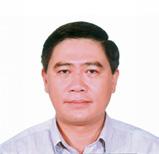
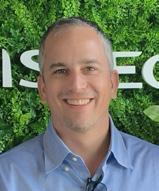
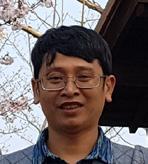
Nguyen Van Nguyen is Director, Research Center for Aquafeed Nutrition & Fishery Post-Harvest Technology (APOTEC) - RIA2, Vietnam.
Le Hoang, is Head of Aquafeed Technology, Processing, and Fish Nutrition Department, (APOTEC) - RIA2.
Pham Duy Hai is Head of Laboratory for Aqua-Nutrition and Sea-Food Quality Analysis, (APOTEC) - RIA2.
Tran Van Khanh is Head of Fisheries Experiment Station, (APOTEC) - RIA2.
David Bal is Head of Research Aquaculture Nutrition & Health (ASA), Adisseo Asia Pacific Pte Ltd, Singapore.
Email: david.bal@adisseo.com
A short review on occurrence of mycotoxins in feedstuffs for aquafeeds, effects on carp and whiteleg shrimp and their management
By Vivi Koletsi
The Asia-Pacific region leads all others in farming aquatic animals, producing 83.4 million tonnes of the 94.4 million tonnes produced globally in 2022 (FAO, 2024). Global aquaculture production increased by 6.7 million tonnes in 2022 compared to 2020 — and that increase is mainly attributed to increases in Asia. Notably, for the first time in history, the supply share of aquatic animals from aquaculture (51%) surpassed the supply from fisheries (49%).
It is worth highlighting that current projections indicate that Asian countries will maintain their dominance in the aquaculture sector by producing 89% of the world’s output of aquatic animals by 2032 — which would be a 1% increase over the region’s output in 2022 (88%). These projections also hypothesise that aquaculture in Asia will account for more than 91% of the total increase in production expected by 2032.
Advances and innovations in the aquafeed industry have significantly contributed to the expansion of aqua farming, with fed aquaculture now accounting for approximately 73% of all industry production. The increasing demand for aquafeed resulting in the insufficient volumes and high prices for fish meal and fish oil, have contributed to the rapid decline of their inclusions in formulations; conversely, explorations of diverse raw materials and the inclusion of alternative protein sources have increasingly become common practice (Naylor et al., 2021). According to the Practical Aquaculture Feed Formulation Database (PAFF), soybean meal is the most common plant protein source in the diets of the major farmed aquatic animals in Asia. Its inclusion varies by species, with the percentages differing for Asian seabass (25%), white-leg shrimp (35%), pangasius catfish and common carp (both 42%). Other types of plant-based ingredients commonly included in the diets of these species are wheat meal, flour, wheat gluten meal, corn meal, corn gluten meal and by-products like wheat bran, corn bran, rice bran and distillers’ dried grain with solubles (DDGS).
While plant protein sources are essential for fostering sustainable growth in the aquaculture industry, they also introduce potential risks — particularly from mycotoxins (Glencross et al., 2020). Mycotoxins are produced by specific fungi that thrive in favourable conditions on plantbased feed ingredients, before and after harvest (Marijani et al., 2019). These fungi can also grow in aquafeeds stored in inadequate or less-than-ideal conditions (e.g., high temperatures and humidity), which further increase the risk of mycotoxin contamination.
The most common mycotoxins produced pre-harvest include Fusarium spp., while aflatoxins and ochratoxin A are typically produced during storage by Aspergillus and Penicillium spp. (Yiannikouris and Jouany, 2002). Studies have documented the presence of mycotoxins in aquafeeds in Asia and Europe (Gonçalves et al., 2018; Koletsi et
al., 2021), highlighting the need to screen plant-based ingredients for mycotoxin contamination.
The Alltech 37+ lab offers an advanced mycotoxin analysis technology — such as liquid chromatographytandem mass spectrometry (LC-MS/MS), which allows for the detection of up to 54 different mycotoxins. To assess the general risk of contamination, we examined the mycotoxin profiles of samples of soybean meal (n=71), DDGS (n=86), wheat (n=89) and corn (n=389) that were submitted to the Alltech 37+ lab in the first half of 2024 (Table 1).
A closer look at Table 1 reveals that over 90% of all DDGS samples contained Fusarium -produced mycotoxins, such as fumonisins, as well as type-B trichothecenes (mainly deoxynivalenol). In addition to mycotoxins produced pre-harvest in the field, approximately 13% of the DDGS samples contained aflatoxin B1, and around 53% contained other Penicillium mycotoxins, which are produced post-harvest during storage and transportation. In other ingredient samples, mycotoxins produced by field fungi were also prevalent: Fusaric acid was present in 54.9% of soybean meal samples, and type-B trichothecenes appeared in 67.4% of wheat samples and 80.2% of corn samples.
One notable statistic is the high frequency at which emerging mycotoxins — or toxins that are not regulated and not routinely defined in many mycotoxin-monitoring programs — were found across all feedstuffs, including in 71.8% of soybean meal samples, 85.9% of corn samples, 93.3% of wheat samples and 97.7% of DDGS samples. The global prevalence of emerging mycotoxins in crops and finished feeds has been recently demonstrated by Kolawole et al. (2024); they highlighted that when co-occurring with other toxins, and even at low levels, emerging mycotoxins can significantly affect an animal’s performance.
The occurrence of multiple mycotoxins in feedstuffs is well-documented (Koletsi et al., 2021) and was confirmed by the analysis results: 76% of soybean meal samples were co-contaminated with an average of 3.4 mycotoxins, 100% of DDGS samples contained an average 11.4 mycotoxins, 95% of wheat samples were co-contaminated (with 5.7 mycotoxins, on average) and 95% of corn samples contained an average of 7.6 mycotoxins per sample.
While it has been proven that multiple mycotoxins, and especially emerging mycotoxins, can be present in feedstuffs simultaneously, there is a lack of scientific information about their combined effects. To our knowledge, only one study — conducted by Berntssen et al. in 2023 — has evaluated the impact of emerging mycotoxins in aquatic animals. Those authors found that salmon is particularly sensitive to enniatin B1, and they subsequently determined that the safe amount of enniatin B1 that can be included in feed should be limited to 20–50ppb. When the combined effects of mycotoxins were
To assess the general risk of contamina8on, we examined the mycotoxin profiles of samples of soybean meal (n=71), DDGS (n=86), wheat (n=89) and corn (n=389) that were submiMed to the Alltech 37+ lab in the first half of 2024 (Table 1).




assessed in vivo in fish, studies showed that fumonisin B1 and moniliformin had synergistic effects in catfish (Yildirim et al., 2000), while in rainbow trout, the co-exposure of aflatoxin B1 and zearalenone resulted in synergistic effects (Ghafarifarsani et al., 2021), and deoxynivalenol, fusaric acid and fumonisins exhibited additive effects as well (Koletsi et al., 2023).
Research has revealed that each species’ specific sensitivity is of high importance in Asia-Pacific, including their sensitivity to individual mycotoxins that are produced before harvest (type-B trichothecenes, like deoxynivalenol; type-A trichothecenes, such as T-2 toxin; fumonisins; zearalenone) or after harvest (aflatoxin, ochratoxin A). The following sections provide insights drawn from mycotoxin studies conducted on carp and shrimp.
The presence of deoxynivalenol in common carp feed (at 352–953ppb) affected the organ health and immune responses of the fish (Pietsch et al., 2014a; Pietsch et al., 2014b; Pietsch et al., 2014c; Pietsch et al., 2015), and its presence in grass carp feed (at 318ppb) resulted in reduced growth performance and diminished intestinal immunity and impaired the intestinal structure and gill integrity of the fish (Huang et al., 2018; Huang et al., 2019; Huang et al., 2020). Exposing common carp to T-2 toxin led to decreased feed intakes and growth (Balogh et al., 2009), increased oxidative stress, anaemia, altered immune responses (Matejova et al., 2017), damaged DNA (Szabó et al., 2021) and affected defence mechanisms (Pelyhe et al., 2016). Exposure to fumonisin B1 resulted in histological changes in the organs of common carp (Petrinec et al., 2004), while other studies of common carp showed that even at low doses (i.e., up to 300ppb), zearalenone can affect the intestinal (Wang et al., 2019) and gill integrity of the fish (Zhang et al., 2023) and can even change the expression of immune- and antioxidative-related genes (Pietsch, 2017).
Several studies have documented the potency of aflatoxin B1 (at 13–50ppb) and its ability to impact growth performance and immune function: it can cause histological changes and plasma biochemical indices, and lead to aflatoxin residues in the muscles and organs of carp (Han et al., 2010; Huang et al., 2014; Fan et al., 2018; Zeng et al., 2018; Ning He et al., 2022). Scientific evidence also shows that ochratoxin A reduces growth performance and feed efficiency (Liu et al., 2021; Zhao et al., 2024a) and can affect a fish’s intestinal
and gut barriers (Zhao et al., 2024b; Liu et al., 2021), creating oxidative and histological damage (Zhao et al., 2022), with toxin residues detected in the organs and skin of grass carp (Zhao et al., 2023a; Zhao et al., 2023b).
Shrimp is highly vulnerable to mycotoxins. Even when found in concentrations as low as 330ppb, deoxynivalenol can lead to decreased weight gain in shrimp and can impact the expression of antioxidative-related genes in their hepatopancreas. Moreover, when present in doses of 420ppb or higher, deoxynivalenol can reduce survival rates and lead to histopathological changes in the hepatopancreas (Xie et al., 2018).
Concentrations of T-2 toxin in shrimp feed (at 500ppb) can decrease growth and survival rates, increase oxidative stress biomarkers and lead to histopathological changes in the hepatopancreas and muscles of shrimp (Qiu et al., 2016; Deng et al., 2017; Huang et al., 2019a and 2019b). The presence of fumonisin B1 at levels between 500–1,800ppb led to reduced growth performance and greater histological changes in the hepatopancreas and muscles of shrimp (Mexía-Salazar et al., 2008; García-Morales et al.,
Shrimp are also sensitive to storage mycotoxins, such as aflatoxin and ochratoxin A, which are most likely to grow in stored feed — and especially in the high humidity levels and temperatures that are common across Asia-Pacific. Once again, effects including impaired growth, feed efficiency and survival, as well as damage to the hepatopancreas, are all linked to exposure to aflatoxin B1 in shrimp at doses ranging from 20ppb to 1,200ppb (Yu et al., 2018; Deng et al., 2020; Zeng et al., 2015). Ochratoxin A has been shown to affect growth performance and the accumulation of residues in the shrimp abdomen at doses as low as 100ppb (Albuquerque et al., 2016).
Mycotoxin
spectrum analysis by a certified lab — such as the Alltech 37+ lab, which can detect up to 54 different mycotoxins. Based on the results of those analyses, feed producers can strategically supplement mycotoxin-adsorbing agents — like Mycosorb® family products from Alltech — in their formulas. Some producers decide to include these agents for prophylactic purposes without necessarily implementing a full mycotoxin-monitoring plan. Another common feed-formulation strategy is to include mold inhibitors, such as Alltech’s MOLD-ZAP, to help inhibit fungal growth and minimise the risk of contamination during storage.
In literature, Mycosorb® family products are referred to as yeast cell wall extract (YCWE) and backed by decades of scientific research. Evaluating the effectiveness of any multi-binding agent is crucial, considering that feedstuffs and aquafeeds are commonly contaminated with multiple mycotoxins. Among the various detoxifying agents with multiple-mycotoxin-binding claims tested in vitro, YCWE has demonstrated the greatest efficacy, adsorbing more than 50% of deoxynivalenol, zearalenone, fumonisin B1, ochratoxin A, T-2 toxin and aflatoxin B1 (Kolawole et al., 2019). YCWE has also been successfully tested in vivo in several aquatic species.
Mycotoxin contamina8on can occur before and/or aber harvest but preven8ng fungal growth on crops pre-harvest has become increasingly more challenging due to climate change (Medina, 2023) As a result, feed mills are now more likely to receive feedstuffs that have already been contaminated in the fields. Fortunately, some preventa8ve and correc8ve steps can be implemented at this stage to mi8gate the risks of exposing fish and shrimp to mycotoxins
Mycotoxin contamination can occur before and/or after harvest — but preventing fungal growth on crops preharvest has become increasingly more challenging due to climate change (Medina, 2023). As a result, feed mills are now more likely to receive feedstuffs that have already been contaminated in the fields. Fortunately, some preventative and corrective steps can be implemented at this stage to mitigate the risks of exposing fish and shrimp to mycotoxins.
Mycotoxin prevention and mitigation strategies along the aquafeed supply chain are primarily implemented at the feed mill level (Figure 1). A monitoring plan at feedmill facilities, which screens feedstuffs upon arrival, is an effective option for preventing mycotoxin contamination. Alltech’s RAPIREAD™ technology enables feed producers to quickly identify and analyse up to seven key mycotoxins. It is also advisable for feed producers to periodically send samples of their feedstuffs and their final feeds for a full-
Mycotoxin preven8on and mi8ga8on strategies along the aquafeed supply chain are primarily implemented at the feed mill level (Figure 1) The implementa8on of a monitoring plan at feed-mill facili8es, which screen feedstuffs upon arrival, is an effec8ve op8on for preven8ng mycotoxin contamina8on. Alltech’s RAPIREAD™ technology enables feed producers to quickly iden8fy and analyse up to seven key mycotoxins. It is also advisable for feed producers to periodically send feedstuffs and their final feeds for a full-spectrum analysis by a cer8fied lab the Alltech 37+ lab, which can detect up to 54 different mycotoxins. Based on the results producers can strategically supplement mycotoxin-adsorbing agents family products from Alltech in their formulas. Some producers decide to include these agents for prophylac8c purposes without necessarily implemen8ng a full mycotoxin-monitoring common feedformula8on strategy is to include mold inhibitors, such as Alltech's MOLD growth and minimise the risk of contamina8on during storage.
This YCWE technology consists of insoluble carbohydrates primarily derived from the glucans in the cell walls of the Saccharomyces cerevisiae strain of yeast. Mycosorb A+ goes a step further by combining those yeast cell wall components with carbohydrate components from algae. The flexible surfaces of these active yeast cell wall components facilitate the absorption of free mycotoxins. More specifically, β-D glucans feature spaces that align perfectly with specific mycotoxins, making them optimal binding sites. The algal components of Mycosorb A+ further enhance its binding capacity, allowing it to adsorb a broader range of mycotoxins. Unlike clay-based mycotoxin binders, the yeast and algae components of this solution do not interact with the essential nutrients, minerals or vitamins included in the diet. Instead, they specifically bind mycotoxins in the gastrointestinal tract, inhibiting the absorption of mycotoxins into the bloodstream and their distribution to target organs and, alternatively, promoting their excretion via faeces. As a result, the bioavailability of these mycotoxins and their potential impact on animal health and performance are minimised.
References are available on request

Dr Vivi Koletsi is a global technical support specialist within Alltech’s Technology Group. Email: Vivi.Koletsi@alltech.com

1. Recommended mycotoxin prevention and mitigation strategies for feed mills.
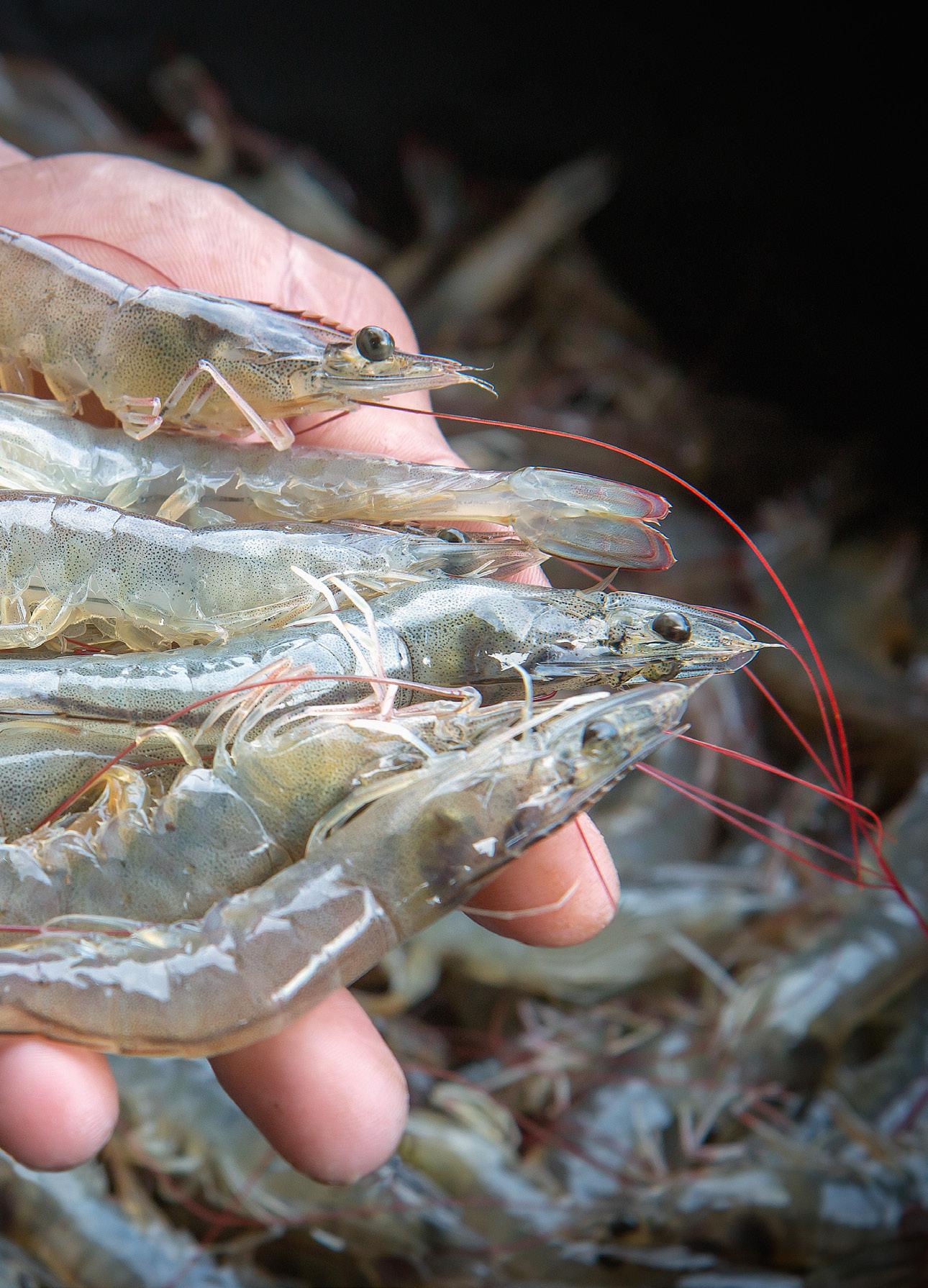
Mycotoxins are a concealed risk to aquatic production, particularly if they go undiagnosed over a long period of time.
Unlock the potential of your farm with Alltech’s industry-leading mycotoxin control program. With our suite of mycotoxin testing services and our proven range of Mycosorb® broad-spectrum adsorbents, you can take control of the mycotoxin risk in your business.
By Le Thanh Hung, Huynh Khanh Duy, Vo Thi Thanh Binh, Mihai Sun and Sutep Luengyotluechakul
In the feed industry, mineral premix is often used in feed formulae to supplement micro minerals (Zn, Se, Mn, Cu, Fe). They participate in the immune system, helping shrimp and fish to resist pathogens (Lim et al., 1996). Inorganic minerals are often used in the form of mineral salt such as zinc sulphate (ZnSO4.7H2O). However, inorganic minerals have lower biological value than organic minerals, which can result in higher mineral excretion and environmental pollution. Trace mineral stability and absorption processes affect availability and ultimately animal performance. Mineral-amino acid complexes (Mineral-AA complexes, a mixture of a single specific metal complexed with different AAs in a 1:1 ratio) are taken up by AA-transporters instead of metal ion transporters, reducing the risk for transport saturation and improving absorption efficiency. Furthermore, mineralAA complexes are more stable and minimally antagonised by other dietary ingredients, like phytic acid.
In the Mekong Delta, the survival rate from raising pangasius catfish Pangasianodon hypophthalmus fry to fingerlings is extremely low, around 7-10%, due to disease outbreaks. This study aimed to evaluate the supplementation of organic minerals in the form of mineral-AA complexes compared with inorganic minerals to improve resistance to disease and growth rates of catfish during the nursery phase.

Some 15-day old fish (0.12-0.15 g) were stocked in 28 hapas (1.5x1.0x1.3m) immersed in an earthen pond of 500m2, at a stocking density of 500 fish/hapa. A basal feed was formulated with ingredients such as fish meal, soybean meal, rice bran, cassava meal and dicalcium phosphate (DCP) to provide a 40% protein and 6 % lipid diet. Feed with floating characteristics was produced at a feed mill. The basal diet was supplemented with either inorganic or organic minerals to create seven different experimental diets, with different sizes (0.2, 0.4 or 1.0 mm), according to the size of the experimental fish. NT1 and NT2 diets were supplemented with inorganic minerals, namely zinc sulphate (ZnSO4.7H2O), manganese sulphate (MnSO4.H2O), iron sulphate (FeSO4.7H2O), copper sulphate (CuSO4.5H2O) and selenate (Na2SeO3.5H2O). The remaining feeds (NT3,
NT4, NT5, NT6 and NT7) were supplemented with ZINPRO ‘s mineral-AA complexes: Availa-Zn, AvailaSe, Availa-Mn, Availa-Cu, Availa-Cr and Availa-Fe. The amount of micro minerals added to the basal diet is shown in Table 1. Fish were fed one of the seven diets twice a day (at 7:00 and 16:00) for 8 weeks. A feeding tray was used to monitor and adjust feed consumption to be close to satiation.
At the end of the feeding trial, 28 fish per hapa were randomly selected to be challenged with Edwardsiella ictaluri bacteria by immersion method (bacterial concentration 1.2 x 105 CFU/mL). Challenged fish were transferred to tanks where the mortality was followed for 14 days.
NT1* follows the micro mineral requirement of fish (NRC, 2011)
Table 1. Content and source of the trace minerals added to experimental feed.
Results and discussion
Crude protein, crude fat, and crude fibre were kept similar among the seven experimental diets (Table 2). Trace mineral content varied among diets (Table 2) because of the different mineral supplementation (Table 1).
Micro mineral
Table 2. Nutritional composition and micro minerals in the seven experimental diets.
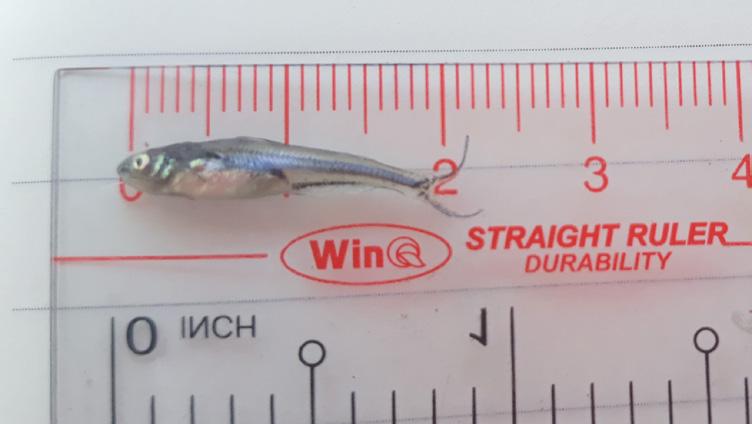
the experiment.


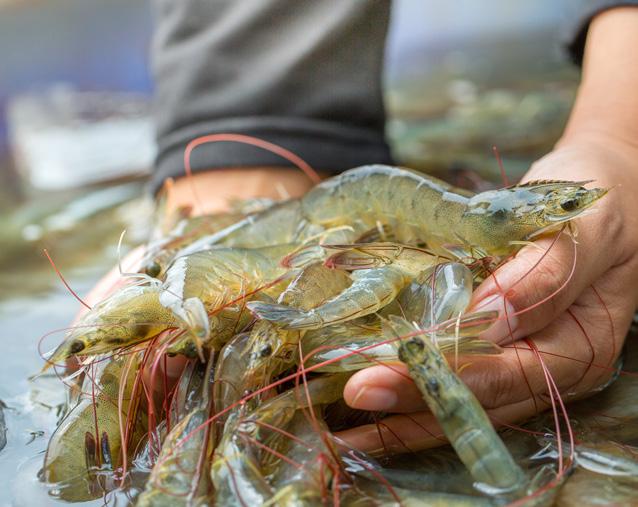
- W56: Fish weight after 8 weeks feeding; DWG (Daily weigh gain); SGR (Specific growth rate), FCR (feed conversion rate); SR56 (survival rate); W0: Initial weight of fish (0.12-0.13 g/fish).
- X= Mean ± SD (n = 4). Data on the same column having a different superscript letter has a significantly different (Duncan test, p < 0.05).
Table 3. Growth performances and feed conversion ratio of fish fed one of the seven diets at the end of the 8 weeks feeding period.
At the end of feeding for 8 weeks, survival rates were significantly different (p<0.05) between diets (Table 3). Diets NT1 and NT2, using inorganic minerals, had the lowest survival rate. The growth rate of fish shown in Table 3 is expressed in terms of daily weight gain (DWG) and specific growth rate (SGR). Feed conversion ratio (FCR) was highest in treatment NT1 (1.56) and lowest in treatment NT7 (1.36), with this difference being statistically significant (p<0.05). Total replacement of inorganic trace minerals with mineral-AA complexes (60ppm Zn, 0.25ppm Se, 2.4ppm Mn, 5ppm Cu, 30ppm Fe) during the nursery phase improved SGR, FCR, and survival by 2, 3, and 52%, respectively. Supplementation of 0.4ppm Cr, in addition to other mineral-AA complexes (NT7) further improved SGR, FCR, and survival by 3, 4, and 28%, respectively.
After 8 weeks of feeding, fish were exposed to bacteria challenge and their mortality was recorded daily (Figure 1).
As shown in Figure 1, challenged fish started dying from the 5th day onwards, with the mortality rate increasing rapidly from the 6th to the 10thday post-challenge. The fish mortality stopped at the 12th day post-challenge. The cumulative mortality rate (Table 4) was significantly different among treatments (p<0.05), with the highest cumulative mortality rate registered with diet NT1 (67.86%) and the lowest registered with diet NT7 (34.82%). Increased Se level from 0.25 to 0.4 ppm and the supplementation with 0.4ppm Cr significantly reduced fish mortality in response to E. ictaluri challenge.
Treatment 5 days post challenge 10 days post challenge 14 days post challenge
Table 4. Cumulative mortality (%) of fish at 5 days, 10 days and 14 days post challenge.
1. Cumulative mortality of fish fed seven diets after the bacteria challenge for 14 days.
As presented in Figure 1 and Table 4, results demonstrated that the supplementation with organic minerals (mineralAA complexes), clearly improved the pangasius catfish survival rates during the nursery phase. It appeared that the inorganic minerals were not sufficient to meet the performance and the health requirements of fish.
Results from our study agreed with previous work showing supplementation with organic minerals such as Zn improves channel catfish immune response (Lim et al., 1996). Partial or complete replacement of inorganic minerals with mineral-AA complexes was shown to reduce skin lesions in Atlantic salmon after infestation with Caligus,and increase the number of goblet cells in intestine and skin of European seabass and intestine of Nile tilapia, indicating enhanced barrier defense mechanisms against pathogens.
Moreover, replacement of inorganic minerals with mineralAA complexes significantly improved performance, mainly the activity of key antioxidant capacity enzymes, the expression of immune cytokines and modulated intestine microbiota in Nile tilapia (El-Sayed et al. 2023 a,b). Supplementation with Fe-AA complex vs inorganic Fe has significantly improved the haematocrit levels and mean corpuscular haemoglobin, and enhanced antioxidant responses in juvenile Nile tilapia (Hermes et al., 2023).
Dietary supplementation with Zinpro® Chromium Methionine proved to be consistently effective in improving the utilisation of feed in crustaceans as well as in fish, regardless of their trophic level. The performance measured as SGR and FCR was found to have improved by a minimum of 4% in salmonids, gilthead seabream, African catfish, tilapia, pangasius (this study), common carp, and crustaceans fed diets supplemented with chromium methionine complex.
Conclusion
The inorganic micro minerals supplemented in pangasius catfish premix are not sufficient to meet the demand in larval rearing of the fish. The supplementation of organic micro minerals of zinc, iron, selenium, and chromium clearly improves the fish survival rates and its fish growth as well as feed use efficiency. Nursery phase supplementation of a minimum 60ppm Zn from Availa®Zn, 0.4ppm Se from Availa®Se, and 0.4ppm Cr from Availa®Cr is recommended for improving pangasius survival rate, growth, feed conversion ratio, immune response, and resistance to E. ictaluri
References
Arafat R. Ahmed. 2012. The effect of dietary chromium (III) on growth and carbohydrate utilization in mirror and common carp (Cyprinus carpio). Dissertation of University of Plymouth. https:// pearl.plymouth.ac.uk



El-Sayed M. A.-F., Figueiredo-Silva, C.,. Zeid, S. M. S., Makled, S. O. 2023. Metal–amino acid complexes (Zn, Se, Cu, Fe, and Mn) enhance immune response, antioxidant capacity, liver function enzymes, and expression of cytokine genes in Nile Tilapia reared under field conditions. Journal of Aquatic Animal Health 35(4):248262. doi: 10.1002/aah.10194.
El-Sayed M. A.-F., Figueiredo-Silva, C., Zeid, S. M. S., Makled, S. O. 2023a. Metal-amino acid complexes (Zn, Se, Cu, Fe and Mn) as a replacement of inorganic trace minerals in commercial diets for Nile tilapia (Oreochromis niloticus) reared under field conditions: Effects on growth, feed efficiency, gut microbiota, intestinal histology, and economic return. Aquaculture 567 (2023) 739223. https://doi.org/10.1016/j.aquaculture.2022.739223.
Kaiser, F., Schlachter, M., Schulz, C., Figueiredo-Silva. C. 2023. Dietary Supplementation with Chromium DL-Methionine Enhances Growth Performance of African Catfish (Clarias gariepinus). Aquaculture Nutrition. https://doi.org/10.1155/2023/7092657
Lim C., Kleisius P. H. and Ducan P. L. 1996. Immune response and resistance of channel catfish to Edwardsiella ictaluri challenge when fed various dietary levels of zinc methionine and zinc sulfate. Journal of Aquatic Animal Health 8 (4): 302 – 307.
Mechlaoui, M., Dominguez, D. , Robaina, L., Geraert P., Kaushik S., Saleh R., Briens M., Montero D., Izquierdo M. -2019-. Effects of different dietary selenium sources on growth performance, liver and muscle composition, antioxidant status, stress response and expression of related genes in gilthead seabream (Sparus aurata). Aquaculture 507: 251–259
National Research Council (NRC), 1993. Nutrient requirement of Warmwater Fishes and Shellfishes. National Academy Press, Washington DC.
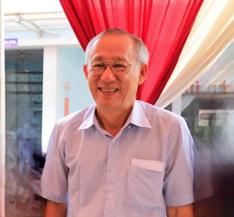

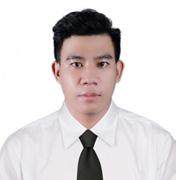
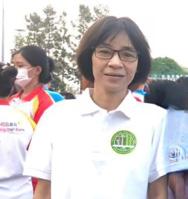
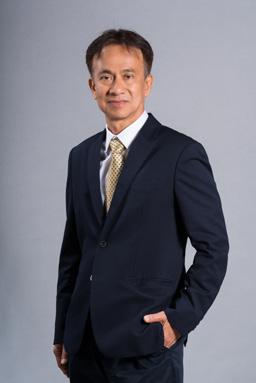
Mihai Sun is Principal Scientist with Cargill Corporation and conducted this research while working at Zinpro Corporation, USA;
Sutep Luengyotluechakul is Regional Business Enterprise Manager – South and Southeast Asia at Zinpro Animal Nutrition (Thailand) Inc. Email: sutep@zinpro.com
SINGLE SCREW EXTRUSION SYSTEM OPTIMIZES FLEXIBILITY AND MARKET OPPORTUNITIES
Optimize the return on your capital investment with a single screw extrusion system. Buy one system and cost-effectively deliver product to multiple market opportunities.
• One system capable of economy up to super premium fresh meat petfood
• Aquatic feeds that range from floating to sinking shrimp feed
• Capitalize on high margin petfood treat opportunities
• Significantly lower operating cost per ton versus competitive systems
An Extru-Tech Single Screw Extrusion System provides all the flexibility and production efficiencies at around half the cost of competitive extrusion systems with high operating costs.

Contact Extru-Tech today at 785-284-2153 or visit us online at extru-techinc.com
Box 8 100 Airport Road Sabetha, KS 66534, USA Phone: 785-284-2153
Fax: 785-284-3143
extru-techinc@extru-techinc.com www.extru-techinc.com
Discussions on how the lower demand for frozen tilapia fillet affects producers in Asia to how consumers are influencing which marine fish is on the dining table
Jayvee-Calculated will be 6 pages = changed layout –see new file pp34-39 highlighted part
Discussions on how the lower demand for frozen tilapia fillet affects producers in Asia to how consumers are influencing which marine fish is on the dining table
At TARS 2024, four presentations in the State of Industry and Challenges (SOI) session discussed the evolving dynamics of the farmed fish industry: views on the US market for the tilapia; the pangasius in Vietnam and the region; marine fish in China; and for the host country, Thailand, the focus was to increase production in tilapia via genetics and quality fry.

Speakers and an industry panellist at the State of Industry and Challenges session. From second left, Francisco Murillo, Yufan Zhang, Mai Chung, Amorn Luengnaruemitchai, and Olivier Decamp, R&D and Business Development, INVE Aquaculture, Thailand. The session was moderated by Ronnie Tan (left).
Photo: Speakers and an industry panellist at the State of Industry and Challenges session. From right, Francisco Murillo, Tropo Farms Ltd, Ghana; Yufan Zhang, Alltech, China; Mai Chung, ADM Animal Nutrition, Vietnam, Amorn Luengnaruemitchai, Manit Genetics Co Ltd & Manit Intertrade Co Ltd, Thailand and Olivier Decamp, R&D and Business Development, INVE Aquaculture, Thailand. The session was moderated by Ronnie Tan, US Grains Council Aquaculture Consultant.
The decline in US tilapia imports: Misreading the signs
At TARS 2024, four presentations in the State of Industry and Challenges (SOI) session discussed the evolving dynamics of the farmed fish industry: views on the US market for the tilapia; the pangasius in Vietnam and the region; marine fish in China; and for the host country, Thailand, the focus was to increase production in tilapia via genetics and quality fry.
lbs/person. In general, while some species have seen fluctuations, tilapia experienced a pronounced, longterm decline in per capita consumption. The solution, according to Francisco, lies not in cutting production, but in tackling the complex challenge of shifting market perceptions (Figure 1).
The US tilapia market is a reference on global tilapia trade and Francisco Murillo, CEO of Tropo Farms Ltd, Ghana began his presentation with a spoiler - “Tilapia consumption in the US is in a longterm declining trend (mainly due to demand of frozen fillets), compounded by a short-term supply issue (related to fresh fillets).”
The decline in US tilapia imports: Misreading the signs
The US tilapia market is a reference on global tilapia trade and Francisco Murillo , CEO of Tropo Farms Ltd, Ghana began his presentation with a spoiler - “Tilapia consumption in the US is in a long-term declining trend (mainly due to demand of frozen fillets), compounded by a short-term supply issue (related to fresh fillets).”
Tilapia imports into the US Francisco then shifted to the notable drop in tilapia imports into the US markets and explained the trends.
Some 23 years ago, tilapia showed up in the top 10 in the list of seafood in the US. Growth was high at 144% in the next 5 years, and tilapia reached number 4. In 2006, it surpassed the catfish, the other freshwater fish in the US market. The peak consumption for the tilapia was at 1.47 lbs/person in 2022, but this has declined 30% to 1.05 lbs/person In general, while some species have seen fluctuations, tilapia has experienced a pronounced, long-term decline in per capita consumption. The solution, according to Francisco, lies not in cutting production, but in tackling the complex challenge of shifting market perceptions (Figure 1).
Some 23 years ago, tilapia showed up in the top 10 in the list of seafood in the US. Growth was high at 144% in the next 5 years, and tilapia reached number 4. In 2006, it surpassed the catfish, the other freshwater fish in the US market. The peak consumption for the tilapia was at 1.47 lbs/person in 2022, but this has declined 30% to 1.05
Fresh whole tilapia imports comprise mostly red tilapia from Colombia. This is because the US market could not get enough red snapper, a sought-after fish. Volume was 5 million kg which is expected to be stable for the next 2 years.
Whole frozen tilapia imports were 60 million kg but has been slowly declining. Volume is expected at 48 million kg in 2024.
Fresh tilapia fillet imports were relatively stable. Over the past 12 years, the volume of fresh tilapia fillets imported into the US fluctuated between 19.7 million kg and 26.7
Figure 1. Per capita consumption of tilapia in the US from 2001 to 2021. Extracted from the presentation on Tilapia Market in the US: History and Perspectives by Francisco Murillo, Tropo Farms Ltd, Ghana at TARS 2024.
million kg annually. However, the first five months of the current year have signalled a sharp downturn, with projections indicating an annual total of just 20.3 million kg—potentially the second-lowest volume in over a decade.
The decline in fresh tilapia imports can be attributed to a series of setbacks across key producing countries because of Streptococcus agalactiae 1a, affecting farms in Mexico, Honduras, Costa Rica, Colombia and Brazil. Other challenges include the suspension of exports from Rainforest, a major producer, due to the US Food and Drug Administration’s (FDA) concerns over salmonella contamination, low juvenile production and reduced stocking levels in Colombia, and lower supply from the Honduras as the government imposed a prohibition on aquaculture activities in Lake Yojoa.
Frozen tilapia fillets
These are the largest segment of the market - 88% from China and 8-10% from Indonesia. A declining long-term trend is obvious. “In the last ten years, there was a drop in imports from China by 42% and from Indonesia, 46%. Back in 2014, the US was importing a million lbs of frozen fillet/day and a million lbs of fresh fillet/week. Today, frozen fillet imports are down to 600,000 lbs/day, a 40% reduction. The main reason is that US consumers have become more aware of environmental and social issues. Data up to June 2024, showed a decline of 16% Y-o-Y in June 2024, with China’s imports declining by 19%.
Tilapia production in China: A sector in decline
Yufan Zhang gave a sobering update on tilapia production in China. “Despite official statistics indicating growth, on-the-ground reality tells a different story. With low demand, farmers are struggling with low prices. The financial strain on distributors and farmers is evident, with many exiting the industry due to unsustainable margins. The future of tilapia production in China appears bleak, with a potential significant decline looming as government reports eventually catch up with the situation on the ground.”
Value-added tilapia: A mixed picture
Is there a noticeable shift, particularly in the US towards value-added tilapia products, with convenience-oriented offerings like breaded or marinated tilapia? Francisco highlighted a critical disconnect in the data. “The statistics in the US. do not reflect the rise in value-added products because much of the value addition happens domestically and not at the point of import. “The US and EU may show a tilt towards value-added products, but emerging markets, where a significant portion of tilapia is consumed, do not exhibit the same trend. In countries like Egypt and China, there is no clear path towards value-added products.”
A bad reputation Francisco gave his perspectives on the long-term decline in imports. Large stores will not sell products from China, stemming from concerns over antibiotic use, as well as poor social and environmental practices. Negative media coverage has led major US supermarket chains like Costco, Publix, and Kroger to distance themselves from these products. The risks of reputational harm and potential legal liabilities have become too great.
The situation was aggravated by controversial practices and ongoing production issues. Carbon monoxide (CO), used to enhance the colour of tilapia fillets, is not allowed in Europe. Despite being deemed “generally recognised as safe” (GRAS) by US Food and Drug Administration (FDA), the use of CO raises concerns on product authenticity and consumer perception. Similarly, tripolyphosphate (TPP) is used to retain water in frozen fillets, potentially inflating the fillet’s weight by 30% or more, a practice allowed in both the EU and the US, albeit with labelling requirements.
Certification efforts, such as those by Chinese producers, may help, but entrenched views, such as the Monterey Bay Aquarium’s Seafood Watch classifying tilapia from China on the red list i.e. ‘to avoid’, continue to deter US consumers. Addressing these perceptions is crucial for reversing the downward trend, but it will require a sustained, long-term effort. “For tilapia, the decline in per capita consumption in the US is likely to continue unless we can fundamentally change market perceptions,” he cautioned.
With regards to the fresh fillet market, to counter production and disease challenges, Francisco said producers are turning to “increased vaccination efforts, including the development of vaccines tailored to new strains of the bacteria”. Additionally, there is a push to boost juvenile production to offset lower survival rates. Notably, Costa Rican exporter Rainforest is working through FDA protocols to restore its US market access, a process expected to bear fruit by late 2024 or early 2025.
Data up to June 2024, showed a decline of 16% Y-o-Y in June 2024 for imports of frozen fillets. China’s imports declined by 19% (Table 1). This decline in US demand is symptomatic of broader issues within the industry, including consumer perceptions and market dynamics.
The long-term decline in US per capita consumption of tilapia is particularly troubling, suggesting that the industry must address deeper issues related to market perception and product branding.
Table 1. US imports statistics, frozen tilapia fillet (kg) by country of origin in June of each year. Extracted from the presentation on Tilapia Market in the US: History and Perspectives by Francisco Murillo, Tropo Farms at TARS 2024.
Contrary to the assumption that increased consumption in producing countries have led to the reduction in US imports, Francisco clarified, “It’s not that more tilapia is being consumed elsewhere, but rather that the US market is shrinking, pushing producers to find other markets.”

Francisco Murillo said, “It’s not that more tilapia is being consumed elsewhere, but rather that the US market is shrinking, pushing producers to find other markets.”
In his presentation on “The pangasius through a macro lens, Mai Chung, APAC Regional Manager for Aquaculture Feed Additives, ADM Animal Nutrition, Vietnam, recalled its history. The pangasius industry, a once modest sector in Vietnam’s Mekong Delta, has grown exponentially over the past few decades from 50,000 tonnes in 2000 to 1.7 million tonnes in 2023, earning its place as a key player in the global white fish market. Today, Vietnam remains the leading producer of pangasius. Other countries in the Asia-Pacific region, including India, China, Indonesia, and Bangladesh, have also seen significant growth in production, driven by rising demand and favourable farming conditions.
The production cost is low - between US$1.1-1.3/kg. The farmgate price is low at US$1.2-1.3/kg, giving farmers a small margin. Each cycle is 8-9 months for 800g-1.2kg fish. However, processors prefer 1-1.2kg fish.
In the 2010s, media reports in Europe raised concerns on the sustainability of Vietnam’s pangasius production, leading to the inclusion of “Ca Tra” (Vietnamese Catfish) on the WWF’s consumer red list. In response, Vietnam developed its VietGAP standard and promoted the Aquaculture Stewardship Council (ASC) certification. It became the only country with pangasius farms certified to these rigorous standards. However, negative perceptions persist, requiring efforts to improve the industry’s image.
“Certification may be uneconomical for small-scale farmers, but it helps to improve production efficiency. A study by Can Tho university analysed production efficiency of certified versus uncertified farms. They reported that efficiency (FCR, survival rates etc) of certified farms is higher,” said Mai.

Mai Chung said, “Negative perceptions still persist, requiring efforts to improve the industry’s image.”
Low profit margins and trade protectionism
The pangasius industry faces several challenges, including low profit margins, difficulty accessing finance for smallscale farmers with interest rates of 11-15%, and trade protectionism in key markets like the US. However, Mai said that the fish is remarkably adept at converting feed into protein, requiring only 5-10% animal protein in its diet and can even grow with 100% plant proteins.
“Feed costs are low at US$0.45/kg, and this coupled with a fast growth rate, makes pangasius one of the most economically viable species to farm. However, feed is 86% of production costs. “If the farmer pays feed cost upfront, the cost of production is 5-10% lower, compared with paying later with interest to the feed distributor. Feed costs are supported by integrators who buy back harvests or feed distributors at 1.2% monthly interest,” said Mai. “There are now fewer small-scale farmers and processors get 60-70% of raw materials from their own farms.”
The US Department of Commerce maintains antidumping duties on several Vietnamese pangasius producers. This makes the products less competitive. Therefore, there is a need to reduce dependence on one market and seek new markets.
Diversified products and moving up the whitefish ladder
Looking forward, Mai believes that the pangasius industry will likely see moderate growth in production volumes. It will have more integrators. Certification and sustainability are very important for its future as well as a focus on genetics and vaccine development.
“Industry also recognises that it must invest in marketing, branding and R&D to position pangasius as a highquality, desirable product rather than a low-cost seafood. Emphasis needs to be on value-added and premium products as well as on development of co-products. It will be good to see pangasius in sushi markets.”
From the whole fish, fillet yield is 36.4%. With pangasius, there is zero waste since co-products include fish meal and fish oil for feeds and biofuel; pangasius stomach in Vietnamese cuisine; and the skin for chips and conversion to gelatine and collagen for the food, cosmetics and pharmaceutical industries.
Amorn Luengnaruemitchai, Managing Director at Manit Genetics who is also president of the Tilapia Association of Thailand, said that the tilapia is very dear to Thailand. It was introduced by King Rama IX in 1965 and is the mainstay of small-scale cage farmers in lakes and rivers with little economies of scale. They struggle with high feed cost, while fish prices fluctuate with demand and supply. “Nevertheless, it is growing at 2% annually, although production volumes are small as compared to major players such as Bangladesh.”
Over the past 50 years, Thailand has been the largest exporter of tilapia fry, reaching 45 countries, according to data by the Department of Fisheries (DOF). Selected strains are the result of breeding programs carried out by the private sector and DOF; the latter has four Chitralada tilapia strains. They have also developed saline strains, tolerant from 20ppt to seawater salinity
Effects of climate change
Exports of frozen fillet are to the US and round whole fish to Myanmar and Cambodia. Thailand’s Nile tilapia exports have been decreasing since 2009. Amorn attributes this to “the era of global boiling” - escalating feed prices at 30% more which do not commensurate with farmgate prices for the fish. Climate changes with extreme heat and unpredictable weather patterns with higher water temperatures and changes in rainfall, have led to disruptions in fish farming operations and increased production costs. These factors have collectively led to a 20% decline in production volume. Amorn showed data linking temperatures to fish mortality over a 3-year period.

Amorn Luengnaruemitchai said that “climate changes have collectively led to a 20% decline in production volume.”
New market approach
The tilapia is a popular daily fish available in restaurants and street stores. The association wants to change this perspective and is approaching chefs to create new menus for a new style of serving the fish. They have an airline contract and next is developing new recipes.
China’s marine fish: The real direction
Marine fish aquaculture contributed only 1.93 million tonnes, out of the total farmed fish production of 29 million tonnes in 2022. Dr Yufan Zhang, China Aqua BD Manager & SE Asia Technical Manager, Alltech China said, “We have 60 species farmed commercially and only 9 have genetic strains. Fujian and Guangdong province are leaders in marine fish production. This sector is fast growing and the direction according to media and government includes indoor recirculating, industrialised pond recirculating, offshore and deep-sea culture models and fish processing, distribution and consumption. ”
and Guangdong province are leaders in marine fish production. This sector is fast growing and the direction according to media and government includes indoor recirculating, industrialised pond recirculating, offshore and deep-sea culture models and fish processing, distribution and consumption. ”
China's marine fish total production (000 tonnes, %)
China’s marine fish total production (‘000 tonnes, %)
Flounder, 121, 10% Red drum, 63, 5% Cobia, 27, 2%
Sea bass, 199, 16% Sea bream, 131, 11%
The golden pompano story








Grouper, 204, 16%
Large yellow croaker, 254, 20%
Golden pompano, 244, 20%
Figure 2. China’s marine fish total production in ‘000 tonnes and % share. Extracted from the presentation by Yufan Zhang, on China Marine Fish Culture: Real Direction and Bigger Bottle Neck, at TARS 2024.
Yufan sees the golden pompano as an example of what is really pushing the direction of this sector. It is the fastest-growing marine fish species in China and since 2020 is close to overtaking the large yellow croaker as the top farmed species in China. In 2023, it reached the top with over 300,000
The golden pompano story
Yufan sees the golden pompano as an example of what is really pushing the direction of this sector. It is the fastestgrowing marine fish species in China and since 2020 is close to overtaking the large yellow croaker as the top farmed species in China. In 2023, it reached the top with over 300,000 tonnes (Table 2).
1 Large yellow croaker Large yellow croaker Large yellow croaker Large yellow croaker (254,000)
2 Sea bass Grouper Sea bass Pompano (243,000)
3 Grouper Sea bass Grouper Grouper
4 Flounder Flounder Flounder Sea bass
5 Sea bream Sea bream Pompano (243,000) Flounder
Table 2. The rise of the pompano Trachinotus blochii , in China since 2020. Production is in tonnes/year. Extracted from the presentation by Yufan Zhang, on China Marine Fish Culture: Real Direction and Bigger Bottle Neck, at TARS 2024.
Yufan said that contrary to the perception that marine fish farming is driven by high-end, noble goals, the reality is far simpler - margins and capitalism. The push for profitability, rather than innovation or sustainability, is shaping the sector’s trajectory, shifting towards farming the golden pompano. The preference for prepared foods during the Covid lockdown benefited the fish. In 2021, the cost of production for the golden pompano was CNY22/ kg while price was CNY30/kg. Comparatively, the cost of production for the seabass was CNY16/kg while price was CNY22/kg.

Yufan Zhang said that contrary to the perception that marine fish farming is driven by high-end, noble goals, the reality is far simpler: margins and capitalism.
However, Yufan said, “This focus on immediate financial returns has led to a lag in the development of improved fish varieties and deep-sea culture technologies, which are crucial for long-term growth.” In 2022, four species— large yellow croaker, golden pompano, grouper, and seabass—dominated the sector, accounting for 70% of the total yield (Figure 2). Yet, Yufan argued that these methods, particularly coastal cage farming and pond farming, are not sustainable in the long run. Rather, the industry’s future lies in offshore deep-sea culture and industrialisation. However, these innovations are hampered by the sector’s current profit-driven approach.
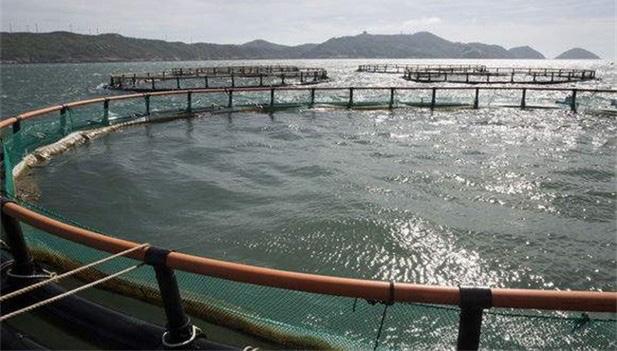

“Are
we seeing a move towards value added products globally.”
Lukas Manomaitis, U.S. Soybean Export Council, Singapore

“With pangasius and tilapia facing infections and climatic effects, does functional feeds have room in the production system?” Romi Novriadi, Jakarta Technical University of Fisheries, Indonesia
“The large yellow croaker Larimichthys crocea is our national fish. We started its farming when supplies from fisheries were depleted. The fish was the leading marine fish for several years. Yet since 2018, its farming has stagnated when cost of production rose from US$18.7 in 2009 to US$27.7 in 2018 and margins dropped from US$10.4/kg in 2009 to US$1.7/kg in 2018. Margins were the bottleneck.”
He contended, “The battle for the future of marine fish farming will not be won in fishponds or on the high seas but at the dining table. In that connection, the industry must prioritise consumer demand and market dynamics over mere production metrics. He argued that only by aligning with market needs can China unlock the full potential of its marine fish farming industry and overcome the bottlenecks that currently constrain its growth.
This remains a significant hurdle for fish farmers. Francisco showed how fresh tilapia fillet imports into the US were down because of the effects on production due to Streptococcus agalactiae 1a, from high mortality rates in Colombia and Honduras and reduced juvenile production and reduced stocking levels.
Amorn highlighted the complexity of managing fish mortality and disease. “There is no absolute solution”, he noted, “as multiple factors, from genetics to seasonal timing, play a role in disease outbreaks.” Effective management hinges on selecting the right solutions for specific conditions, whether it is adjusting stocking density applying vaccines strategically or perhaps vaccinating only during certain seasons when disease outbreaks are more likely, compared to vaccinating all year round. While vaccines and functional feeds offer some hope, they are not yet widely adopted due to cost and practical limitations.


“If we increase production but per capita consumption stays the same, how are we going to sell?
Christopher G. Co, Oversea Feeds Corporation, Philippines
“Will we see a slow decline in global seafood consumption.”
Alex Chin-Chiu Lin, Aquaculture Technologies Asia Ltd, Taiwan
Amorn questioned, “Which season should we grow tilapia? Should it be past summer, connecting towards the rainy season? That part is crucial as that is when it can get easily infected.”
He added that the recirculating aquaculture system (RAS) is often touted as a solution; it’s resource-intensive, requiring precise feed inputs that may not be feasible across all environments. “Success,” Amorn argued, “lies in tailoring strategies to the unique circumstances of each region, season, and fish species.” He detailed how the 300,000 tilapia farmers in Thailand have come together to create a platform to share disease diagnostic information. Via this app, they can obtain services from DOF and universities and get notifications on disease in areas affecting them.
Mai echoed this by adding, “Only large companies can vaccinate pangasius while functional feed for pangasius is not popular due to costs. For the moment, there seems to be no practical solution for preventing disease and the farmer has to resort to better management practices like water treatment to eliminate problems.”
The farmed fish industry, as discussed at the State of Industry panel at TARS 2024, is navigating a challenging landscape. Disease management remains a persistent issue at the farm level while global consumption patterns suggest that the industry must adapt to shifting demands and perceptions. As the panellists agreed, the path forward will require a combination of innovation, strategic adaptation, and a keen understanding of the varied markets that make up the global aquaculture landscape.
A global exchange by industry leaders at TARS Hard Talk 2024 on marketing the pangasius, tilapia and Asian seabass
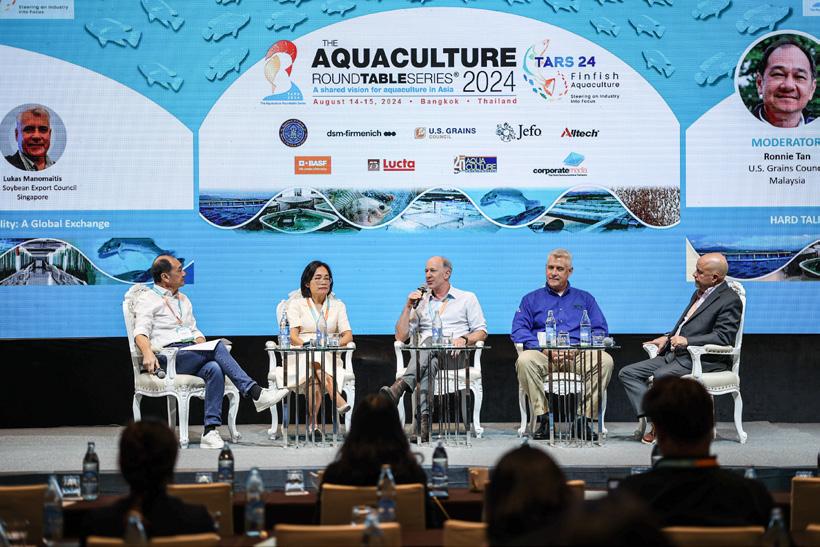
Asia’s finfish industry plays a vital role in the supply of fish protein for a burgeoning global population; however, the industry grapples with sustainability, branding, and market positioning. At TARS 2024 on finfish aquaculture, held in Bangkok on August 14-15, the Hard Talk moderated by Ronnie Tan, US Grains Council, featured the following industry leaders who provided insights and a window into the strategic thinking shaping the future of fish aquaculture.
Nguyen Ngo Vi Tam is CEO of Vinh Hoan, the world’s largest pangasius producer, based in Vietnam.
Josh Goldman is Founder/CEO of Australis Aquaculture, the leading producer of ocean farmed Asian seabass or barramundi, from farms off Vietnam.
Francisco Murillo, CEO of Tropo Farms, Ghana, one of the leaders in tilapia farming in Africa.
Lukas Manomaitis, Global Aquaculture Coordinator, U.S. Soybean Export Council.
Branding and market positioning: The challenge of recognition
In an increasingly competitive market, the need for effective branding and market positioning is paramount. Tam highlighted the journey Vinh Hoan undertook in developing a strong brand identity. Initially focused on processing over 10-15 years, the company gradually recognised the importance of branding, particularly in the face of commodity price fluctuations. “We positioned ourselves as one of the leading pangasius fish companies in sustainable production. We let the product speak for itself.”

Nguyen Ngo Vi Tam says “We positioned ourselves as one of the leading pangasius fish companies in sustainable production. We let the product speak for itself.”
Josh’s experience with Australis Aquaculture underscores the importance of branding in a market where consumers have little pre-existing knowledge of the product. This is both a challenge and an opportunity because there is white space to define the category. Australis introduced barramundi, an unknown species in the North American market, with the goal of creating a strong consumer brand. “We think of The Better Fish primary as a consumer brand,” Josh explained, “This requires us to identify and address areas of shared concern with our consumers and to create emotional relevance which sits behind the idea of ‘a better fish’ for a better world.”
Francisco’s perspective on tilapia reflects a different challenge. Unlike barramundi, tilapia is widely recognised but often lacks a strong consumer-facing brand. “In the US market, tilapia became popular because of its mild flavour and versatility, which appealed to healthconscious consumers. US consumers do not like a ‘fishy’ fish and the tilapia was like chicken. However, the lack of a strong brand meant that tilapia producers had to focus on reliability and sustainability to maintain their reputation with large buyers.”
His view, however, is that for tilapia, the focus is not to brand it as a consumer facing product, because to him, the buyers are the retailers. “For retailers, they want reliability. They are buying millions of pounds of seafood products every week and the last thing they want is a problem. They only want to associate your brand with reliability. In reliability, I mean you deliver the quantity you say you were going to deliver, at the time you said you would deliver, and at the quality you committed to.”

Francisco Murillo says, “In reliability I mean, you delivered the quantity you say you were going deliver it, at the time you said you would deliver, and at the quality you committed to.”
Sustainability emerged as a central theme in the panel discussion, with each CEO emphasising its importance in their business strategies. Tam’s company embraced sustainability early on. “Sustainability was a call to be heard. We confidently followed this pathway, invested in marketing talents, and improved our marketing communications and positioned Vinh Hoan as a pioneer in sustainability.”
Josh’s approach to sustainability is closely tied to the Australis mission and branding. The company’s mission to globalise the barramundi is driven by a belief that it provides a more resilient alternative to offset climate risks faced by many other white fish species. Josh noted that the company’s success depended as much on creating a strong brand that resonates with consumers as it does on production. “Our vision has always been to make this a product that could work pretty much in every supermarket in America,” he said.
When asked whether he considered his brand as a “mass luxury product,” he replied, “We don’t see it as a luxury product - to the contrary - we believe its attributes and value are ideal to support regularly consumption, both at home and in a wide range of food service environments.”
On the white fish ladder, barramundi is affordable to most consumers, with a price point slightly below Atlantic salmon. Josh said, “We’re positioned to make it affordable for everyday use for the average consumer. Barramundi products are probably not competing directly with pangasius and tilapia and should be viewed as higher quality sustainable replacement for grouper, snapper, or seabass that still works for a broad array of different end-users.”
Lukas Manomaitis discussed the broader impact of sustainability on the aquaculture industry. He noted that the rise of certification bodies and social media had significantly influenced the industry, pushing producers towards more sustainable practices. “Now, if you want to succeed, it’s necessary to have a great story,” he said, emphasising the importance of sustainability in marketing and branding.
These have become crucial aspects of the aquaculture industry, particularly in markets where sustainability is a key concern. Lukas highlighted the growing importance of certification in Asia, where many producers initially resisted these requirements. However, the involvement of buyers and certification bodies eventually forced producers to adopt sustainable practices. This shift had a significant impact on the industry.

On market positioning the barramundi, Josh Goldman says, “Barramundi products are probably not competing directly with pangasius and tilapia and should be viewed as higher quality sustainable replacement for grouper...”
“Certification did not exist 20 years ago. When they did come about and started talking to the industry, I think that most of Asia did not listen to them. But when the certification bodies came out and collaborated with the buyers, suddenly, certifications became more than just a formality—they became essential for market access, especially with major retailers like Walmart,” said Lukas.
The pandemic further accelerated this shift. With consumers spending more time at home, they began scrutinising product labels and packaging, leading to a heightened awareness of sustainability issues. This newfound consumer interest in sustainability was a turning point, as seen in discussions at the Boston Seafood Show two years ago. Lukas noted a distinct change: consumers, particularly younger generations like
Gen Z, now demand transparency about the origins and production methods of their food.
As a result, aquaculture companies have had to adapt their branding and marketing strategies to emphasise sustainability. Stories of responsible production and eco-friendly practices have become crucial in appealing to modern consumers. This convergence of certification, social media, and consumer demand has not only reshaped the industry but also set new standards for what it means to succeed in the global marketplace.
Josh gave his take. “Most supermarkets have a framework and timeline in place, made a decade ago and is maturing. At the consumer level, if you get the branding right on sustainability, it becomes a point of entry for younger consumers, more motivated around ethical buying issues.”
Instead of relying on external suppliers or partners for several aspects of production, a vertically integrated aquaculture company manages the supply chain - from breeding and hatchery operations to farming, processing, and distribution. Both Josh and Tam, are pursuing a vertically integrated approach in their companies’ growth.
Josh emphasised that for his company, vertical integration was a natural evolution. By focusing on a single species, they integrated operations to maintain control over critical aspects such as hatcheries and genetics. For him, this approach was essential to fulfilling the company’s brand promises and ensuring reliability. “Vertical integration is about committing to our promises, maintaining our reputation and fulfilling our mission.”
However, Josh acknowledged the financial challenges associated with such a strategy. While vertical integration can be resource-intensive, he argued that it becomes necessary as the business grows. At Australis, this was built up over 15 years and is still an ongoing journey.
Tam shared a similar viewpoint and vision but stressed on the importance of flexibility. Vinh Hoan, while integrated, still occasionally purchases from the market to benchmark against industry standards in farming and feed production. This flexibility allows the company to avoid overconfidence and maintain a competitive edge.
“We cannot do everything by ourselves, and therefore, we want to showcase to independent farmers, nurseries, and hatcheries, since there is a huge demand for quality pangasius fingerlings. We are also keen to invest in innovations.”
The discussion also touched on the lessons that could be learned from the Mediterranean seabass industry. Lukas pointed out that in Türkiye, the government initially supported fingerling production before stepping back to let the private sector take over. This hands-off approach contrasts with some Asian countries, where governments remain involved, creating competition with private hatcheries.” Asia could benefit from adopting some of the streamlined practices seen in the Mediterranean, particularly in areas like cold chain logistics.”
Francisco provided insights from the South American context, where vertical integration is often a necessity due to the lack of reliable third-party suppliers. He highlighted the strategic importance of controlling the entire value chain, including feed, to ensure that products meet certification requirements. This is crucial in maintaining market competitiveness and avoiding the risk of losing key certifications, which can impact market access. “If I buy from a third party, can I be sure they are going to be certified?”
Common in fish farming is cyclic demand and supply situations. Tam discussed how her company navigates these fluctuations by focusing on diversification. “We focus on gradually improving the fish value, such as with breaded and marinated products,” noting that the company had expanded into related products like collagen, fish meal, gelatine, and biofuel to mitigate the impact of market fluctuations.
Francisco highlighted the differences between the frozen and fresh tilapia markets, noting that the fresh market is more susceptible to fluctuations due to its short shelf life. “You can have overproduction, and there’s very little you can do other than leverage relationships with customers,” he said. Building trust with buyers, he argued, was essential for managing these fluctuations.

Will the Asian seabass be the next ‘Asian salmon’?
Once considered a minor player in the aquaculture industry, the Asian seabass is now emerging as a significant species. This shift is driven by both its biological attributes and changing market dynamics, though the path to dominance remains contested.
Josh noted that while he did not predict seabass becoming a leading species, his research indicated that the salmon industry would eventually face biological constraints limiting its supply. “I spent 3 years profiling 30 species, raised them in recirculation systems in the US, and I chose the barramundi and built a company around that. This is based on a combination of biological attributes, oil content and mild flavour. We see barramundi as the tropical salmon. This is a compelling vision for this region, but we still have a long way to go.”
However, Lukas, who has extensive experience in the Asian market offered alternative species. While he acknowledged the barramundi’s potential, other types of seabass, such as the Japanese and European seabass, are also vying for prominence. He argued that “In Asia, seabass is considered a mid-value species,” although with strong genetics and widespread production. Higher-value fish like pompano and snapper also present compelling cases. For seabass to truly dominate, it must achieve substantial production volumes without oversaturating the market.”
The debate highlighted a broader challenge in aquaculture: the need to focus on one species to achieve the necessary scale for profitability. As the moderator pointed out, successful aquaculture requires significant investment in genetics and production methods, which can be difficult if resources are spread too thin across multiple species.
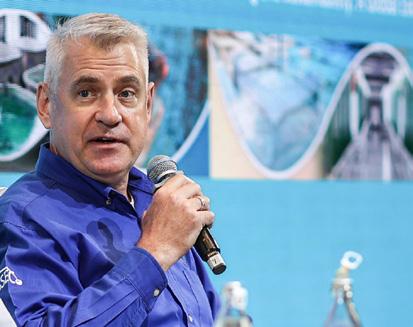
Lukas Manomaitis says that higher-value fish like pompano and snapper also present compelling cases. For seabass to truly dominate, it must achieve substantial production volumes without oversaturating the market.
Lukas suggested that the industry may need to settle on a single species, and singled out grouper, which could serve as Asia’s answer to salmon. However, the process of
ramping up production remains a significant hurdle. Josh, on the other hand, emphasised the advantages barramundi holds in terms of growth rate and established infrastructure. “While European and Japanese seabass reach about 400g after 18 months, barramundi can grow to 3kg under the right temperature. The barramundi is also well ahead of its competitors in terms of nutrition, disease control, and consumer acceptance.”
As the finfish aquaculture in Asia continues to evolve, the question of which species will emerge as the “next salmon” remains open.
The panel discussed the importance of using the entire fish, particularly for the tilapia and pangasius. Filleting yields are typically low, raising the question of how to make use of the remaining by-products.
Tam emphasised that the value of fish extends far beyond frozen fillets. “Early on, Vinh Hoan recognised the potential in the whole fish, using the skin for collagen and gelatine production, which are highmargin products. Other by-products, such as fish meal and fish oil, are repurposed for animal feed or even biofuel, a growing market in some countries.”
The publicly listed company sees expanding fish farming to increase production of these valuable by-products, particularly collagen. “Our most recent effort to add value is pangasius surimi from filleting trimmings.”
Francisco echoed these sentiments, stating that tilapia is not very different from pangasius in this regard. Filleting yields are low at 33%. Furthermore, additional meat recovered from rib cages and heads are carved out into small pieces for products such as ceviche. He pointed out that reputable companies should utilise fish waste for meal and oil, for biodiesel—though this is only viable when international fuel prices are favourable.
Looking ahead, the panel identified several key trends that will shape the future of fish aquaculture, particularly in scaling production to meet growing demand.
Lukas pointed to the ongoing impact of social media and certification bodies, which are likely to continue driving the industry towards more sustainable practices.
Josh highlighted the potential for barramundi to become a leading species in the white fish market, particularly as consumers become more aware of its health benefits and sustainability.
Francisco emphasised the importance of reliability and sustainability in maintaining market share, particularly in the highly competitive US market. He noted that while tilapia remains a popular choice, producers must continue to innovate and improve their practices to stay ahead of the competition.
In the words of Tam, “We shouldn’t let challenges make us underestimate the value of fish.”
The future of fish aquaculture will depend on the industry’s ability to overcome these challenges, leveraging innovation, sustainability, and strategic thinking to meet the needs of a changing world.
Vannamei shrimp supply outlook to May 2024
At Shrimp Summit 2024, Kontali estimated production to reach 5.7 million tonnes in 2024 and grow further to 6.1 million tonnes in 2025
At Shrimp Summit 2024, Kontali estimated production to reach 5.7 million tonnes in 2024 and grow further to 6.1 million tonnes in 2025

At the Shrimp Summit, 2024, the session on Global Production and Markets was moderated by Travis Larkin (left) The Kontali team of Erwin Termaat, Analyst (right) and Ragnar Nystøyl, Managing Director. Picture credit: TCRS
Organisers of Shrimp Summit, The Centre for Responsible Seafood (TCRS) has published a series of takeaways from the Shrimp Summit 2024, held in Chennai, India, on June 27-29.
The takeaways on global production and markets were:
with increasing cost of production, but currently, this is still not hampering production volumes significantly. Yearly harvest volumes are estimated at 1.4 million tonnes for 2024.
Organisers of Shrimp Summit, The Centre for Responsible Seafood (TCRS) has published a series of takeaway from the Shrimp Summit 2024, held in Chennai, India on June 27-29. Those on global production and markets were:
• Following several years of outsized growth, especially in Ecuador, global production is slowing due to prolonged low prices.
• Following several years of outsized growth, especially in Ecuador, global production is slowing due to prolonged low prices.
• The US Department of Commerce published preliminary antidumping (AD) and countervailing duty (CVD) margins for four investigated countries. The combined (AD +CVD) margins for most exporters from Indonesia, India, Ecuador, and Vietnam range from 6.30 to 28.60%.
• The US Department of Commerce published preliminary antidumping (AD) and countervailing duty (CVD) margins for four investigated countries. The combined (AD +CVD) margins for most exporters from Indonesia, India, Ecuador, and Vietnam range from 6.30 to 28.60%.
The Global Production and Markets session covered production trends and forecasts by country, issues related to markets including price trends, US AD and CVD trade cases and social responsibility in the supply chain.
India’s growth is expected to be up 5% in 2024 versus 2% in 2023. Erwin said, “Last year was not a great year for India due to diseases. We are confident that the 2024 production will be over a million tonnes. We are actually seeing a rise in exports. There is stiff competition with Ecuador for the US and EU markets. This competition will remain in the foreseeable future.”
The Global Production and Markets session covered production trends and forecasts by country as well as issues related to markets including price trends, US antidumping (AD) and countervailing duty (CVD) trade cases, including social responsibility in the supply chain.
Kontali Analyst, Erwin Termaat, and Chief Analyst, Ragnar Nystøyl presented production trends and challenges for Litopenaeus vannamei. Production is expected to reach 5.7 million tonnes in 2024 and grow further to 6.1 million tonnes of LSE (live shrimp equivalent) in 2025. They gave some analysis for the following producing countries.
China’s growth in production is slowing down from 8% in 2023 to 2% in 2024 at only 800,000 tonnes. There has been an expansion of small greenhouse farming and increasing yields but has adverse impacts from groundwater pumping. “There’s a lot of potential in these systems and when things are done right, there is stable growth. The downside is weather events like typhoons, which destroy roofs and result in ponds with broken liners,” added Erwin.
Kontali analyst, Erwin Termaat, and Managing Director Ragnar Nystøyl presented production trends and challenges for Litopenaeus vannamei. Production is expected to reach 5.7 million tonnes in 2024 and grow further to 6.1 million tonnes of LSE (live shrimp equivalent) in 2025. They gave some analysis for the leading producing countries.
“Ecuador showed a steady growth which was slowing in 2024, at an estimated 8% after a 15% growth in 2023,” said Erwin. “Although exports were not increasing due to some logistical problems in China as well as AD and CVD margins in the US, we still estimate an 8% growth. Exports were slow early in the year, due to the metabisulphite incidence with containers shipping to China but exports are up again.”
Vietnam will have a better year in 2024, up 6% after a slowdown in 2023. Vietnam’s production was down slightly in 2023 but export numbers are showing quite a strong start in the year for Vietnam. The estimated production for 2024 is over 600,000 tonnes.
Indonesia has seen declines for two years (-7% in 2023, an estimated -5% in 2024), but the rate of decrease is slowing and may show slight improvement in 2025. There are government programs that are showing some potential and Kontali expects that 2025 can be quite positive for Indonesian farmers.
“Ecuador showed a steady growth which was slowing in 2024, at an estimated 8%%after a 15% growth in 2023,” said Erwin Termaat “Although exports were not increasing due to some logistical problems in China as well as AD and CVD margins in the US, we still estimate an 8% growth. Exports were slow early in the year, due to the metabisulphite incidence with containers shipping to China but exports are up again.”
El Niño did not prove to affect significantly production directly, but the decreased rainfall, especially in the Andes region, made hydropower less reliant. Farmers struggled
“There are always challenges, pricing being one of them,” said Ragnar. “Prices are low, and the big question is what will happen in the second half of 2024.”
With regards to the outlook scenario for 2025, Kontali gave an estimate of 6.1 million tonnes of LSE. Production will continue in Ecuador and Vietnam. India is expected to grow 6%. “However, the current lowering of stocking density happening in India have the potential for growth coupled with a more spread out production season,” said Erwin.
Kontali has gathered data and weighted averages based on volumes from regions and different sizes. Ragnar said, “Over the period from Q1 2020 to Q2 2024, we see a decline of more than 20% to USD3.57/ kg in May. There are indications of a further decline in June. The big question is what will happen in 2H 2024.” He added, “Looking at the history of prices, before 2022, there was always an uptick in pricing in the second half. But this has not happened in the past 2 years.”
“When we look at the market and supply dynamics, in salmon it happens in the production but for the shrimp, it is a much larger part of the market dynamics at post-harvest. And this is really a long period of a product life cycle of a shrimp price, which acects the price dynamics.”
consumers, there are margins and costs. Using the US market’s retail basket, where retail prices hovered around USD16/kg whilst farmgate prices were around USD4-5/ kg, and retail staying at USD16-18/kg since 2018, Ragnar said, “From farmgate to product price, we are comparing apples and pears. You cannot analyse on the basis of prices at these two points. At the retail level there is always a need to look at the wider picture. In an indexed way, shrimp has become much cheaper for the US consumer. But for other proteins, chicken breasts or salmon fillets, consumer prices are even lower (Figure 1).
“Where does the money go between this? Well, it is either in margins or in costs. We know that margins are needed or kept all along the value chain. Could it be that supply chain costs have impacted the distribution of price differentials? There are also large variations of costs involved (Figure 2). Could it be that the cost side taking up the cost difference more than we think?”
Lately, around this low-price scenario, the discussion is on whether consumers really benefit fully from these low shrimp prices Between the farm gate to price to consumers, there are margins and costs. But using the US market’s retail basket, where retail prices hovered around USD16/kg whilst farm gate prices were around USD4-5/kg, and retail staying at USD16-18/kg since 2018, Ragnar said, “From farm gate to product price, we are comparing apples and pears. You cannot analyse on the basis of prices at these two points At the retail level there is always a need to look at the wider picture. In an indexed way, shrimp has become much cheaper for the consumer in the US. But for other proteins, chicken breasts or salmon fillets, consumer prices are even lower (Figure 1).
To understand more on pricing, Ragnar looked at market dynamics of two important aquaculture categories, salmon and shrimp. The production cycle of salmon takes from 20 to as long as 30 months and almost 85% are sold and shipped to their point of purchase as fresh products within two weeks. Whereas for the shrimp, production happens in 3-5 months but 95% are frozen and remain in inventory for a long time.
Ragnar listed the margins and cost from farm gate to consumer. The margins are at;
• Processors and exporters
“Where does the money go between this? Well, it is either in margins or in costs. We know that margins are needed or kept all along the value chain. Could it be that supply chain costs have impacted the distribution of price dicerentials?” Said Ragnar. There are also large variations of costs involved (Figure 2). Could it be that the cost side taking up the cost dicerence more than we think?
• Importers/wholesalers/middleman
• Retailers/foodservices
The costs are:
• Processing input costs (energy, labour, fuel etc)
Ragnar listed the margins and cost from farm gate to consumer. The margins are
• Processors and exporters margin
• Processing yield/supply chain losses (yield loss, driploss)
• Importers/wholesalers/middlemans’ margin
• Logistics cost (fuel, containers, distance and time).
• Retailers/Foodservice’s margin
The costs are:
“When we look at the market and supply dynamics, in salmon it happens in the production but for the shrimp, a much larger part of the market dynamics is at postharvest. And this is really a long period of a product life cycle, which affects the price dynamics.”
• Inventory, handling and holding costs (energy, time, interest, labour, etc.)
• Processing input costs (energy, labour, fuel etc)
• Insurance, capital cost (time, interest and risk etc)
• Processing yield/supply chain losses (yield loss, drip -loss)
• Logistics cost (fuel, containers, distance and time
• Inventory, handling and holding costs (energy, time, interest, labour, etc.)
• Insurance, capital cost (time, interest and risk etc)
Lately, around this low-price scenario, the discussion is on whether consumers really benefit fully from these low shrimp prices. Between the farmgate to price to
Ragnar concluded that as analysts, Kontali will focus in a methodological way to build a model with all these costs elements taking into consideration not only the cost side but also from the retailer side who have not lowered the prices and whether they could have or should have
Ragnar concluded that as analysts, Kontali will focus on a methodological way to build a model with all these costs elements taking into consideration, not only the cost side but also from the retailer side, who have not lowered the prices and whether they could have or should have.
Figure 1. Retail pricing – US market – shrimp’s position versus competing proteins are also important. Source: Presentation by Kontali at Shrimp Summit 2024, Chennai, India. Source: Price data, Comtell.
2 Retail pricing – US market – Shrimp’s position versus competing proteins are also important Source: Presentation by Kontali From the session on Global Production and Markets, Shrimp Summit 2024, Chennai, India.

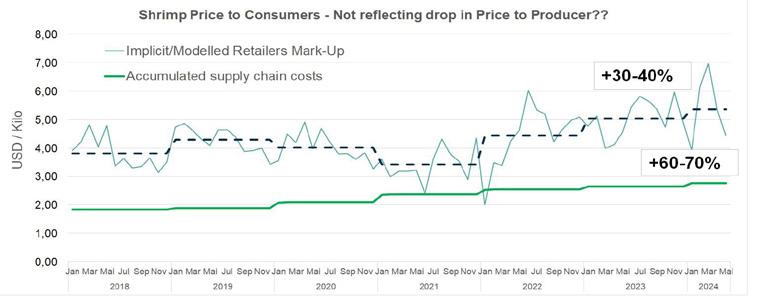
Figure 2. Chart on how supply chain costs have impacted the distribution of price differentials. Source: Presentation by Kontali at Shrimp Summit 2024, Chennai, India. Analysis based on price data from Kontali Shrimp and Comtell, and Kontali Research on supply chain costs and margins.

China is the leading consumer of marine shrimp with imports exceeding one million tonnes in 2023, albeit import volumes are predicted to come down in 2024 at 934,171 tonnes (van der Pijl, 2024). Based on the feedback at the last Global Shrimp Forum (GSF 2023) on the expanding intensive shrimp farming models and shrimp supply within China itself, there was a session - “Deep Dive into China’s Shrimp Production” at GSF 2024. The conference was held on September 3-5, in The Netherlands.

Dr Luca Micciche’, Technical Director at Verdesian Life Sciences based in Malaysia, who works closely with Chinese shrimp farmers, including those operating small greenhouses, traced the current trend in shrimp
farming in China. He set the stage with a presentation on the “Latest development in Chinese shrimp farming: Challenges and opportunities”.
At the panel session, Luca was joined by Fang Qing, Independent Consultant, China and Dr Guo Fuci, CBS Bio Platforms, Canada. Robins McIntosh of Charoen Pokphand Foods, Thailand, joined virtually. The moderator was Sander Visch, Lead Analyst Shrimp Sector, Kontali.
In 2024, out of an estimated total shrimp production of 2.5 million tonnes, 93% will comprise of vannamei shrimp, followed by monodon shrimp (5%) and kuruma shrimp at 2%. “However, monodon shrimp production is growing proportionally faster due to a healthy market demand for live and large shrimp. Unfortunately, supply is still limited to the major cities and touristic coastal areas,” said Luca. “Domestic prices are down trending during the last years due to the global crisis and economic slowdown, but this is pushing Chinese producers to upgrade their farming techniques towards higher levels of efficiency and production quality.”
Luca added, “From 2004 to 2020, the average annual growth rate was 5.2%/year. After 2020, we saw a deep slowdown with an average growth rate of just 1%/year, mainly due to the Covid-19 pandemic and the global economic turmoil. The slowdown could also be attributed to market saturation with domestic production and imports starting to match domestic demand.”

In terms of land use, shrimp farming occupies 10% of the total area of 7,394,647ha used for aquaculture. There are four main farming models as shown in Figure 1.
The small greenhouses account for 28% of the production volume. During 2020-2024, the growth rate of traditional earthen ponds at low stocking density of 60 post larvae (PL)/m2 is low at 2%; it is the small greenhouse model with stocking density of 150PL/m2 which is expanding at 12% followed by lined/elevated ponds stocking at 100150PL/m2, at 8%.
Growth of shrimp factories using high-tech intensive farming methods has tapered down to 6%. Luca observed that these factories which have a high-water exchange at 60-80%, high stocking density of 500PL/m2 or even as high as 1,200PL/m2, are pathogenic reactors and effluent water could easily contaminate the water resources.
“Where is the production expanding the most? Based on a spatiotemporal study published in 2022 (Jing Wang et al., 2022), the direction of shrimp farming expansion in China is from the northeast to southwest. Post larvae supply is from numerous hatcheries in south China. Guangdong province has always dominated shrimp production in China during the last 20 years and recently the southern provinces of Fujian and Guangxi are becoming more prominent in terms of outputs.”

There are three reasons for this shift. Firstly, aquaculture workers are moving to the southern provinces. Local entrepreneurs rent land and build infrastructure to lease to farmers. The latter are then spared of high capital investments for long land rentals and infrastructure construction. The second driving factor is “the total fisheries economic output” - an index representing the maturity and quality of the value chain and logistics associated with shrimp farming, and thirdly, the per capita disposable income in these provinces.
Luca assessed scalability for six farming models- the four already mentioned and in addition, round tanks with high stocking densities at 150-250PL/m2 and RAS (recirculated aquaculture systems). The parameters considered were biosecurity, profitability, replicability, maintainability and sustainability. The result was that these small greenhouses of less than one mu in size (666.7m2) with biofloc systems and average stocking of 125PL/m2 have the highest score. Therefore, the small greenhouse model is the most adoptable and successful in China.
A description of the small greenhouses in Rudong, Jiangsu, where this model was first developed, was given. Ponds are 320-360m2 stocking 150PL/m2 and covered with plastic sheets. Water exchange is only 5-10%. These small greenhouses use 4.5L effective microorganisms (EM) for




Earthen Ponds (Low Stocking Densities <60PL/sqm)
Earthen Ponds
(low stocking density <60PL/m2)
Small greenhouses <500sqm (Biofloc systems - average 150PL/sqm)
Small greenhouses <500m2 (Biofloc systems - average 150PL/m2)
Lines ponds/Elevated ponds >500m2 (average stocking densities 100150PL/m2)
Shrimp factories very high stocking densities >500PL/m2
Lined ponds/Elevated ponds >500sqm (average stocking densities 100-150PL/sqm)
Shrimp factories very high stocking densities >500PL/sqm
Figure 1. Estimated marine shrimp production for 2024 of ~ 2.5 million tonnes based on four farming models. Extracted from the presentation by Luca Micciche’ “Latest development in Chinese shrimp farming: Challenges and opportunities” at Global Shrimp Forum 2024, The Netherlands.
China, authorities are strictwith sampling of eeluent water and shrimp, and will close ponds, if antibiotic residues are detected.

According to Luca, these range from USD3-3.60/kg (Figure 2). Farmgate prices have been down trending in the past 4 years. Farmers are struggling to reach breakeven at midyear and at year end production costs in 2024 will almost match farmgate prices (Figure 3).
Figure 2. In 2024, the average production cost breakdown per kg of shrimp produced in small greenhouse farming model. With no heating, the average cost is USD3.65/kg. With heating, the cost goes up by USD1.25/kg.
Figure 2. In 2024, the average production cost breakdown per kg of shrimp produced in small greenhouse farming model. With no heating, the average cost is USD3.65/kg. With heating, the cost goes up by USD1.25/kg. Extracted from the presentation by Luca Micciche’ “Latest development in Chinese shrimp farming: Challenges and opportunities” at Global Shrimp Forum 2024, The Netherlands.
pond remediation. In terms of biosecurity, the model is the best as quick isolation of disease is possible. A farmer may manage up to 10 units. In the first part of the crop, there is one partial harvest when salinity is low and density higher. After this harvest, salinity is then increased for the second harvest of larger shrimp.
Fuci added that ponds are small at 40mx9m (360m2); production from each cycle is 1000kg/m2/cycle and with three crops, production is almost one tonne/pond. “A trend is also to deepen older ponds from 1m to 1.5m to have 3050% more yield. If one pond fails, it is easy to restart at another pond.”
Currently, around 450,000 of these ponds are operating at different levels, said Robins. Because of difficulties in the market, yield in 2024 may be lower. “The whole point of the greenhouse model is absolute biosecurity; groundwater is used with no or minimal water exchange, and covered. Any pathogen intrusion would be from post larvae. Farmers are savvy and check the post larvae themselves as the requirement is absolutely no Vibrio. For Chinese farmers, Enterocytozoon hepatopenaei (EHP) which will destroy the economics of the crop is more of a threat, while highly lethal post larvae virus (HLV) will kill the crop early. A secondary requirement is faster growth for lower cost.”
Among these small greenhouses, a common practice is to use clean groundwater, and many of them do so without getting permission from the authorities. Therefore, there are reports that the authorities are monitoring the environmental impact of these farms. Authorities are strict and conduct regular sampling of effluent water and shrimp, and will close ponds, if antibiotic residues are detected.
Robins gave alternative figures of USD3.30-3.80/kg. This can be lowered if lower protein and cheaper feeds are available. In China, feeds, usually high in protein, cost USD1.30-1.80/kg. The acceptable farmgate price is USD5.00 to USD5.50/kg, and at below USD5/kg, the farmer will stop farming. There is an element of 50% failure rate (where the crop did not meet expectations due to disease, low survival, high FCR) and then costs will be USD4.50-4.60/kg.
A remark was on the location of mega shrimp factories in farming areas and how these factories compete for the same markets. Earthen ponds have been in existence for more than 20 years. While these are stable and low-cost, Fuci said that some farms have converted parts of their earthen ponds into small greenhouses. “Disease outbreaks are increasing, and production is less and less from these earthen ponds. It is clear that the small greenhouse is the way forward,” added Robins.
The group gave their take on 2H 2024. Qing expects that more effort will be concentrated on building specific pathogen free (SPR) broodstocks. Fuci said, “There are two markets: local production of live shrimp while imports are frozen shrimp. Farms strive to produce robust shrimp prior to harvest so that shrimp can withstand transport of 3-4 days to inland cities such as Chengdu.”
While agreeing on the two independent markets in China, Robins asked whether the frozen shrimp import market compete with the live shrimp or do the live shrimp prices have their own dynamics with production within China? Overproduction and low prices of live shrimp could be addressed by moving away from coastal areas to other markets.
Luca concluded, “Currently, I do not see a direct competition, with the imports from Ecuador since the demand can still sustain both domestic and imported products. I am very positive that the demand will increase in 2025, and prices will improve. Today, per capita shrimp consumption per year in China is less than 10kg.”
Figure 3. Average farm gate price in USD/kg vs production cost USD/kg (Jiangsu province data). Red circles show how in the middle of the year and at year end production costs in 2024 almost match farmgate prices. Extracted from the presentation by Luca Micciche’ “Latest development in Chinese shrimp farming: Challenges and opportunities” at Global Shrimp Forum 2024, The Netherlands.


Co-located with Organized by


Indonesia demonstrated how it sees aquaculture’s role in driving the blue economy

Asian Pacific Aquaculture returned for the second time to Indonesia and to Surabaya on July 2-5. According to Dr Krishnan R Salin, the outgoing President of the World Aquaculture Society – Asia Pacific Chapter (WASAPC), this was the most remarkable APA meeting in its history with 6,051 participants from 63 countries, 72 of them students. There were 399 abstracts, 70 posters and 31 sessions. The trade show had 226 booths. Indonesia has hosted three WAS events - World Aquaculture in 2005 in Bali, APA 2016 and this APA 2024, both in Surabaya. The event was hosted by the Directorate General of Aquaculture, Ministry of Marine Affairs & Fisheries (MMAF) Republic of Indonesia. Organisers were WAS, WAS-APC and PT Tirta Anugrah Abadi.
In his welcome message, Salin said that the conference theme, Aquaculture - Driving the Blue Economy emphasises on the shared commitment to developing new aquaculture approaches, improving collaboration, and addressing global concerns of the blue economy. While thanking sponsors and supporters, he added, “At APA, we can make significant strides toward a sustainable and resilient blue economy. Indonesia as a leader in aquaculture production, alongside China, India and Vietnam, is expected to benefit greatly from this event.”
Indonesia’s blue economy is a crucial part of its national development strategy, leveraging its vast marine resources for sustainable economic growth. The blue economy in Indonesia is valued at approximately US$1.34 billion. This strategy formed the overriding statements by the Vice President of Indonesia Ma’ruf Amin during the elaborate official opening ceremony on July 4.
In his opening address, he discussed the global challenges in the marine and fisheries sectors such as meeting the food needs of the global population especially in terms of high quality animal-based protein. This is an opportunity as the market size is huge amounting to 5% of the global economy. This is where Indonesia has the advantage as 60% of the archipelago is under water.
He added that Indonesia is implementing the blue economy as part of its national strategy with the involvement of the government, business leaders, investors and academicians to create comprehensive and integrated policies. Aquaculture has the potential to account for 16% of Indonesia’s marine economy. However, there are many
challenges: climate change, ecological and environmental impacts, diseases and biosecurity.
The keynote speaker, Professor Dr Rokhmin Dahuri, outlined his vision of where aquaculture in Indonesia should focus on and its positioning in the global aquaculture marketplace. Rokhmin is President of Indonesia Aquaculture Society, lecturer and professor at Faculty of Fisheries and Marine Sciences, IPB University and the former Minister of Marine Affairs and Fisheries of the Republic of Indonesia (2001-2004). He discussed key global trends - population growth, changing human lifestyles, science, technology disruptions, increases in demand, and insecurity within the Asia Pacific region. He quoted the study by the UK-based Marine Climate Change Impact Partnership, where with climate change, a 10C increase affects 10% of aquaculture capacity.
In Indonesia, Rokhmin added that 69% of the aquaculture activity is on Java while it is only 7% of the archipelago in size. In 2023, Indonesia’s aquaculture production was almost 17 million tonnes, including seaweeds (Table 1). The work for aquaculture is to maintain and revitalise all existing aquaculture business units as well as to open aquaculture development and businesses in marine ecosystems, brackish water ponds, and freshwater lakes, reservoirs, rivers, ponds etc. The targets are better productivity, efficiency, profitability, competitiveness, inclusivity, and sustainability.

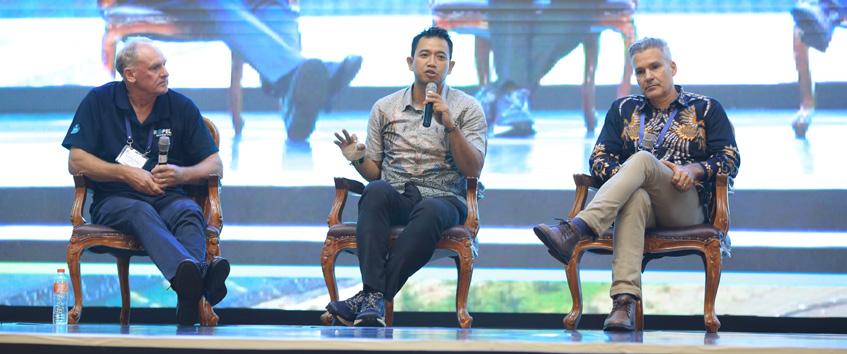
Rokmin said, “On-farm aquaculture production business unit should meet its economy of scale. That is the size of a business unit which produces a net profit that makes the owner and employees life prosperous, with income bigger than US$480 (IDR 7.5 million)/person/month.” (World Bank, 2023).
“We must apply Best Aquaculture Practices, use top quality broodstock and climate resilient species such as those that are temperature/salinity tolerant. Indonesia is behind with research on climate change on aquaculture. We also need: top quality and relatively cheaper feed, and precision feeding by using the latest sound-based automatic feeder; disease control; water quality management; a proper pond engineering which includes layout, design, and construction of ponds, cage nets, and other containers; and biosecurity.”
In terms of species to focus on, for the marine environment, he listed the lobster, grouper, barramundi, silver pompano,

The Shrimp Club Indonesia organised an Indonesia Shrimp Farmers Day on July 4. AAP’s report is on pages 8-14. Photo shows a panel with speakers (from left), Dr Matthew Briggs, Ridley Feeds, Australia; Bawanta Widya Suta, Aker Biomarine and Dr Alberto J.P. Nunes, LABOMAR, Brazil.
Photo credit: APA24 Local Committee.

the Aspirations of Blue Transformation: R&D as Key Driver.” Photo credit: APA24 Local Committee
mussel, abalone, pearl oyster, and seaweed (Euchema spp). For coastal areas, he singled out vannamei and black tiger shrimp, milkfish, saline tilapia, mud crab, and seaweed (Gracillaria spp) and for freshwater- tilapia, common carp, gouramy, pangasius, Clarias catfish, eels, giant freshwater prawn, ornamental fish and aquatic plants.
Finally, he gave a roadmap on how to achieve sustainable aquaculture by focusing on non-conventional aquaculture products. Attention should shift to seaweeds where Sulawesi is Indonesia’s largest producer, aqua-based tourism as well as micro algae as a source of algae oils and zero waste technology such as the production of chitosan from shells.
Table 1. Indonesian aquaculture production based on main commodities in tonnes (20192023). Source: Directorate General of Aquaculture, MMAF (KKP, 2023), https://statistik.kkp.go.id/.
Asia Pacific Aquaculture 2024 is one of the leading exhibitions and conferences in the field of aquaculture. It provided a platform for exhibitors to showcase their latest innovations and products.
Fish size estimation technology
Japan’s I-enter Corporation Ltd has the I-Ocean fish size estimation camera which was granted a patent in April 2020. It utilises advanced deep-learning image recognition technology to accurately detect fish and estimate their length and height based on their location information without the need for direct contact. It uses a portable underwater camera. The data are stored in the database and then managed through a web page. The system enhances the efficiency of farmers when measuring fish size since it is accurate regardless of the skill of the user. Some case studies are available on the website.
The team also demonstrated the IoT water quality sensor which offers 24/7 remote management of water quality data for land-based and marine aquaculture. It measures water temperature, dissolved oxygen level, conductivity (salinity), chlorophyll, pH, ORP, and turbidity according to usage. The measurements can be made at a water depth of 10m or more. The recommendation is to measure water quality inside fish tanks on land-based farms every 15 minutes and on offshore farms every hour. i-enter.co.jp/ en/marine-tech
Integrated shrimp aquaculture platform
Vietnam-based Rynan Technologies has developed a revolutionary intensive marine shrimp culture system in round tanks, deploying several smart technologies. At the trade show, the technology company was represented by PT Adhisakti Solusi Komputindo. Established in 2015, Rynan obtained the Asia Impact Fund in 2017.
In aquaculture, the objective is to use advanced technology to make informed decisions to maximise productivity and profits. It is also to manage the shrimp farming environment and challenge traditional farming methods. TOMGOXY is an integrated aquaculture platform combining IoT monitoring devices and cloud service with AI driven data analysis. There is precise monitoring of water quality parameters with sensors for early detection of disease outbreaks. The information can be accessed remotely via an app and management software. rynantech.com/aquaculture-tech
Live algae culture equipment is from Canada-based Industrial Plankton. The company designs and manufactures turnkey bioreactors for clean onsite live algae production, research laboratories and biotechnology use. Producing enough biosecure algae is the bottleneck for many hatcheries, while the algae must be good quality with low pathogens levels. The company says that its bioreactors are optimised for easy use and biosecurity. industrialplankton.com
Almost all of the feed mills operating in Indonesia were present at the trade show as well as those from other Southeast Asian countries. One of the pioneering feed mills in Indonesia is Gold Coin, now under Aboitiz Foods. In Indonesia, Gold Coin offers a large range of shrimp feeds,


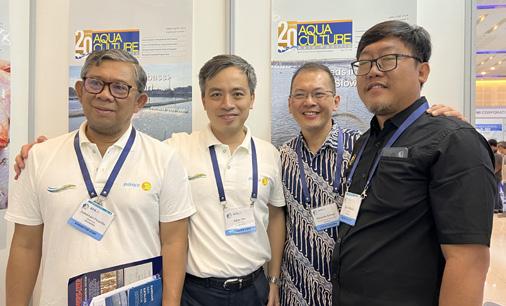
all pelleted. There are 10 sizes, from fines (100-300µm), crumbles (400-800µm) to 1.8mm pellets.
PT Indonesia Evergreen Agriculture, established in 2017, is one of the newer feed mills to enter the Indonesian feed market, although Guangdong Evergreen Feeds has long been established in China. It markets extruded fish and pelleted shrimp feeds. Fish feeds are for the common carp and Clarias catfish. There is a general freshwater feed for other species.
PT Sekar Golden Harvesta Indonesia (SGHI) began feed production in Sidoarja, East Java in 1991 under the name PT Karka Nutri Industri. In 2020, PT Karka and Liaoning Wellhope entered into a joint venture, which gave SGHI the opportunity to innovate and offer various feeds for shrimp farming. The lower protein feeds contain a minimum of 25% crude protein (CP) and 28-30% CP. The highest protein level is 40% CP for intensive and super intensive farming. It also offers feeds for the tilapia, pangasius, gourami and milkfish. There is a feed dedicated to the intensive farming of the tilapia at a stocking of 100-200 fish/m3. The company has pelleted feeds designed for semi-intensive farming of tilapia, milkfish and shrimp. Economical feeds for traditional farming of tilapia and milkfish are also available.
PT Maqpro Biotech Indonesia is a pioneer in Indonesia for marine bio-processing activity. It produces highly specific marine extracts. Product-wise, it has three liquid feed supplements: fish peptide extracts with two levels of crude protein and shrimp peptide extracts. All are specially designed for aquafeeds. These small peptides with free amino acids are palatants and attractants and help to replace fish meal in aquafeeds. It uses a standardised hydrolysis of fresh marine by products (small pelagics and tuna). maqprobiotech.com
Living Seas Aquafeeds Pte Ltd produces functional feed additives by up-cycling and up-valuing locally available seaweeds and marine plants. The Shrimp Supplement contains a mixture of red and green seaweeds, mangrove leaves and volcanic minerals. It is made through a fermentation process which releases bioactive molecules.
The company runs trials for its feed additives with different formulations at the experimental shrimp farm- Living Seas Lab in Northern Lombok, Indonesia. The suggested inclusion rate is 3% for better growth, survival and vigour. The new product is Ulvanite (Ulva and bentonite) feed additive, an associated clay with red and green seaweed. It is targeted for shrimp and fish feeds. livingseasaquafeeds. com
The Norwegian-based company Zooca® uses the copepod Calanus finmarchicus, to produce novel products. The 48% CP Zooca®powder is a heat stable and homogenous powder with a marine flavour. It contains essential amino acids for fish and shellfish, including methionine, lysine and arginine, lipids rich in omega-3s and high levels of zinc and selenium as well as the antioxidant astaxanthin. Astalipid is extracted from the copepod and is high in astaxanthin and omega3s to support optimal growth, immunity and reproductive performance. Two other products are Zooca® SeaFrozen which is the complete C. finmarchicus and the hydrolysate, which is the protein extract from the copepod. zooca.eu



Regal Springs Indonesia (PT Aqua Farm Nusantara) was founded in 1988 in Wunut, Central Java. In 1998, the production expanded to Lake Toba in North Sumatra where it also has a hatchery and processing plant. Today, it is one of the world’s largest tilapia producers and exporters. As a first-time exhibitor at WAS events, it said in a press release (https://bit.ly/47t5smm) that it wants to showcase its commitment to sustainable and innovative aquaculture practices. It displayed its premium products, including its extensive by-product portfolio, and innovations in environmentally friendly tilapia farming. It is supporting Indonesia’s efforts to support sustainable aquaculture and is strongly commited to the Blue Food Movement. The ambitious strategies include by-products to promote circular economy practices, continuous efforts to maximise positive impacts on society through social and community programs such as the “Love Fish Campaign” (Gerakan Memasyarakatkan Makan Ikan – Gemarikan), active and innovative collaborations with universities and educational institutions, as well as initiatives in ecotourism and other environmental and social endeavours. regalsprings.co.id/en/
The conference at APA24 covered a vast range of subjects. Below, we feature a small selection of presentations.
Mary Jessa Bell Pagapulan, Institute of Aquaculture, College of Fisheries and Ocean Sciences, University of the Philippines Visayas, discussed her work on the growth performance of various strains of saline tilapia in the Philippines. These are saline-tolerant tilapia strains, developed for culture in brackish water ponds. Strains included the Brackish water Enhanced Selected Tilapia (BEST), Molobicus, a hybrid of Oreochromis niloticus X Oreochromis mossambicus, and Saline-tolerant Population of Improved Nile tilapia (SPIN), cultured in a pond system at a salinity range of 28-30ppt. She recommended farming the UPV and BEST strains in saline water as they demonstrate optimal growth, feed efficiency, and good survival in this environment.
Richard Le Boucher from the Temasek Life Sciences Laboratory, National University of Singapore reported on work on digestibility optimisation of single-cell protein ingredients (BeV-BM) produced in Singapore from beverage liquid waste. With nearly 50g saline tilapia O. mossambicus, kept at 5ppt water at 28°C, fed experimental diets containing 30% of the bacteria meals, the protein digestibility coefficient (ADC) of the bacteria meal was 77.6%. However, 50% replacement of soy meal with the bacteria meal showed a negative impact on performance. It was possible to cancel this negative impact by modifying extrusion parameters. The main target was to improve the digestibility of diets with the bacteria meal. This study also covered the Asian seabass Lates calcarifer.
In the session on Broodstock, Breeding, Genetics, and Domestication, Celestine Terence reported on work done at the Tropical Futures Institute, James Cook University Singapore on resistance and selective breeding as a long-term solution against scale drop disease virus (SDDV). This is a pathogen responsible for mortality losses of 40-90% in the Asian seabass. Currently, there is no vaccine developed for SDDV. In their study, about



5,000 fish, with almost 50% clinically sick and the other half clinically healthy) from four commercial cohorts were genotyped for a breeding program to also identify SDDV DNA in the fish fin clip samples. Presently, the detection of SDDV involves qPCR testing of immune competent tissues, such as spleen or kidney, impractical for high-valued broodstock. Sick fish had 88.9% SDDV prevalence, whereas healthy fish had 0.2% SDDV prevalence. Results showed a high association between SDDV prevalence and load and fish health status. Celestine said these findings suggest that breeding programs generating large ddRADseq GBS datasets
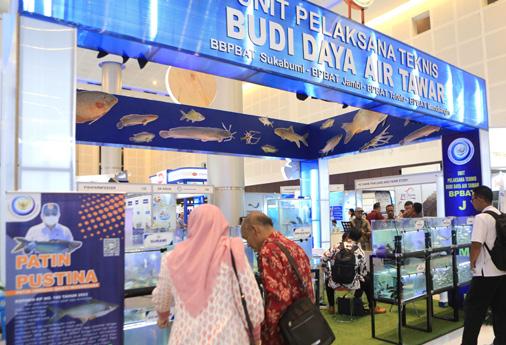
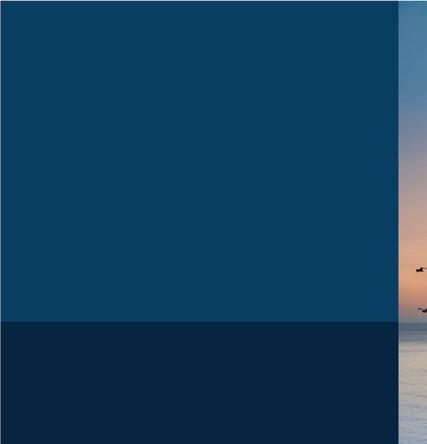
may also be used for pathogen surveillance purposes in aquaculture breeding programs where the target pathogen infects the host genotyped tissue.
In the session on Epidemiology and Health Management, Dr Loc Tran, ShrimpVet Laboratory Vietnam said that translucent post larvae disease (TPD) in vannamei shrimp culture is a significant threat, with more than 90% mortality isatio within 24-28 hours. The initial cases were reported in China in 2019. In 2023, the Vietnam Fisheries Department reported its occurrence after ShrimpVet Laboratory’s research findings in shrimp hatchery samples. TPD is characterised by a pale, translucent hepatopancreas in post-larvae stages.
Investigations have attributed TPD to a novel Vibrio parahaemolyticus strain, exhibiting heightened virulence and distinct from strains implicated in acute hepatopancreatic necrosis disease (AHPND). Loc described a study using histopathological examination and PCR diagnostics to determine the pathology. ShrimpVet’s internal research showed that TPD can also infect shrimp at their grow out stages. He recommended a management protocol encompassing rigorous sanitation, use of probiotics, and continuous pathogen surveillance. Future research will be on genetic analysis to understand TPD’s mechanisms and develop targeted treatments.
Reference
Book of Abstracts, Asian-Pacific Aquaculture 2024, July 3-5, 2024, Surabaya, Indonesia. World Aquaculture Society, 2024.






This year, INVE Aquaculture, part of Benchmark, is still in the midst of celebrating its 40th anniversary. In line with INVE’s philosophy of operating in close proximity to its customers, the company has been celebrating this anniversary by hosting small-scale events throughout the year and across the globe. Celebrations started in Thailand at the end of 2023.
On September 9, the celebrations continued in Ostend, Belgium where INVE Aquaculture, as the platinum sponsor of larvi 2024, the 8th Fish and Shellfish Larviculture Symposium, held a reception for all participants at the opening session. The conference was from September 9-12, and had 360 participants from 50 countries.
Patrick Waty, CEO gave a keynote presentation on “Nurturing tomorrow: our role in sustainable aquaculture.”
He said, “Nurturing tomorrow, is our role together towards sustainable aquaculture. There are challenges and with these, are opportunities, for the future. Compared to livestock production, fish and shrimp farming has very low feed conversion ratios (FCRs). We have a very low water and land usage with low carbon footprint.
“larvi 2024 is all about life beginning in the water with larvae. The global shortage of fish will be addressed by us and is on the shoulders of all of us. There are four important pillars, the first is early stage. What we achieve at the hatchery is invisible to many but have consequences in the next stage, be it nursery or grow-out.”
The second pillar added Waty, is the collaborative part, between hatchery, nursery and the farm. The external world, supporting the farm needs is also part of this collaborative aspect; stakeholders, consumers, authorities and support from science and universities. Next is industry with knowledge transfer and Waty, brought in the good
effects of consolidation in the Mediterranean. The fourth pillar is technology to further evolve. This includes biotech and understanding microbiome, automation and AI.
The takeaway is efficiency and sustainability. “Sustainability is all about consistency. To be sustainable is not just about the environment, but replication in an efficient way. We also include four elements, health and environment, breeding and genetics.”
Founded in 1983 as Artemia Systems, a Ghent University spin-off, INVE Aquaculture was born out of the groundbreaking research done by early aquaculture pioneers. The first generation of INVE luminaries developed the world’s first scalable live food solutions. This remarkable breakthrough was – looking back at it now – what made the surge of global aquaculture possible. Up to this day, INVE Aquaculture stands as a living testament to this legacy of turning scientific knowledge into workable aquaculture practices.
Throughout its history, INVE Aquaculture has not only evolved with the ever-changing landscape of aquaculture but has also played an instrumental role in shaping it. The company’s dedication to R&D has been unwavering from pioneering technologies in larval rearing and hatchery management to leading the way in sustainable practices.
As it celebrates its 40th anniversary, INVE Aquaculture continues to be a beacon of innovation, confident to meet the challenges of the future while fostering growth of the aquaculture industry. True to its academic heritage, INVE Aquaculture embodies the spirit of scientific innovation and entrepreneurship. A strong commitment to customercentricity, and sustainable growth has enabled INVE to become a global leader in shrimp and marine fish hatchery nutrition. inveaquaculture.com







Pontus Research is a contract research organisation (CRO), with facilities in Wales and Singapore to run bespoke trials for companies involved in the aquafeed supply chain, from additive suppliers to feed producers. Most trials are on alternative feed ingredients and additives, and in Wales, the trials are carried out with mainly freshwater species or life stages including salmon parr, trout, carp and tilapia. In Singapore, where the facility is in the Marine Aquaculture Centre on St Johns Island, trials are run on tropical marine species including shrimp, barramundi, grouper and snapper. Pontus offers research on palatability and performance, digestibility and retention, skin and flesh pigmentation, immunology, health, microbiome, and histology. A new histology laboratory and a research scale extruded feed manufacturing line are its most recently acquired assets in Wales.
In Wales, the company has tanks up 1000L using recirculating aquaculture systems (RAS) with precise water quality and temperature monitoring. RAS gives options of changing to freshwater, marine, tropical, and temperate conditions. In Singapore, Pontus has access to a range of sizes and configurations, encompassing both flow through and RAS, with an ambition to establish their own research station in the near future.
own. Over the following four years, the research facility grew from one system to three, increasing its client base and breadth of expertise. Successful fundraising followed in 2018 through 2019 and raised £1.2 million for Pontus to build up new capacity, increasing to eight research systems, which the company is working at filling through extensive business development work. In 2021, a research scale feed mill was added. This is for producing their research feeds and for other facilities as well as more fundamental feed technology research. This allows it to tailor research feeds to the customers’ needs as well as support R&D in feed technology and product benchmarking.
“We are appreciated being here among the former coal mines in South Wales, which has seen high unemployment and poor development since the collapse of the industry in the late 80’s. We are giving something back, a scientific and technological activity and creating employment for several local people who wouldn’t necessarily have had this opportunity, to learn from and grow alongside PhD and Masters holders. This is quite important in terms of the ethos of the business,” said James.
James started to look at the Singapore option in 2021 and opened a Singapore operation in 2022, providing identical services as in Wales for a different species base. “I knew that I had to be in Asia and took up the chance of expanding market reach into Asia and to be known there too. But the pandemic meant that we took longer than planned to bring this facility online. Unfortunately, at the same time we also saw cuts in R&D budgets by companies who were or would have been our clients, so growth has been more challenging than we had foreseen.
A research scale extruder line is one of its most recently acquired assets in Wales.
Pontus Research was set up ten years ago by Jack James. Prior to this James, with a PhD in aquaculture nutrition from Swansea University, Wales, spent several years gaining farm management experience in a 400- tonne RAS eel farm in Madagascar and commercial research management experience at AquaBio Tech in Malta.
“During my PhD, the focus of alternative protein research were ingredients that are common place today – soy protein concentrate, wheat gluten and processed animal proteins. I was interested specifically in the impacts of alternative proteins, not only on nutrition but also the waste characteristics in systems such as RAS, on filtration efficiencies, particle sizes etc,” said James, at the recent Aqua 2024, in Copenhagen, Denmark, held from August 26-30.
Establishing Pontus in 2014, James wanted to bring the experience, knowledge and expertise into performing high quality R&D for companies that had the ambition, but not the facilities or internal expertise, to do it on their
“In Europe, we are well recognised in industry, among insect meal, single cell protein and feed additive producers. We assure confidentiality in all our trials where required, and never seek to retain any IP – we are a pure service provider for our customers. We have published research with Protix, the insect meal producer, on palatability enhancement of insect hydrolysates and attractants in vannamei shrimp diets, and presented other work with AB Vista, Chemoforma, Microbiome Labs and Calysta.
James also has an internal project running called Innovative Sustainable RAS Feed (InSuRAFeed) for carp, rainbow trout and shrimp utilising UK-sourced, non-soy, lowemission ingredients to support an expected growth in RAS production in the UK. Some initial findings of this work was presented by Nicola Pontefract, as an eposter at Aqua 2024 (Figure 1). In the presented work, the concept was to produce experimental feeds for carp and trout at three cost levels, expensive, moderate and economical. Shrimp is also included as there is a lot of interest in the potential for landbased shrimp aquaculture in the UK. “The business plans are based on sustainability of the product, with production close to a market rather than on the other side of the world,” added James.
“This sustainability story breaks down when feeds are imported from overseas, with ingredients produced in the Americas, for example. Therefore, we are looking at developing economical feeds using UK-origin ingredients
ingredients, exclusively, by Pontefract, N. Mance, H, E. and James, J.M., presented at Aqua2024, Copenhagen, Denmark, August 26-30, 2024.

Jack James, CEO and Founder, and Nicola Pontefract, Research Scientist, Pontus Research during Aqua 2024, in Copenhagen, Denmark.
Jack James, CEO and Founder, and Nicola Pontefract, Research Scientist, Pontus Research during Aqua 2024, in Copenhagen, Denmark
– wheat, peas, fava beans, lupins, crab, and mussel meals. We are also investigating single cell proteins, hemp meals and insect products and will be releasing the data to the industry soon. This project is funded from the Carbon Innovation Fund administered by the Co-op Foundation, the charitable arm of the Co-op chain of supermarkets in the UK with funds coming from the sale of the chains “bag for life” carrier bags. pontusgroup.org

Figure 1. The experimental setup and feed formulation for the trials with demonstrating the use of locally sourced ingredients and insect meal. eposter on the Innovative sustainable RAS feeds (InSuRAFeed) for Mirror and Rainbow trout (Oncorhynchus mykiss) utilising UK-sourced, non-soy, ingredients, exclusively, by Pontefract, N. Mance, H, E. and James, J.M., Copenhagen, Denmark, August 26-30, 2024
Figure 1. The experimental setup and feed formulation for the trials with mirror carp demonstrating the use of locally sourced ingredients and insect meal. Extracted from the eposter on the Innovative sustainable RAS feeds (InSuRAFeed) for Mirror carp ( Cyprinus carpio) and Rainbow trout (Oncorhynchus mykiss) utilising UK-sourced, non-soy, low-emission ingredients, exclusively, by Pontefract, N. Mance, H, E. and James, J.M., presented at Aqua2024, Copenhagen, Denmark, August 2630, 2024.
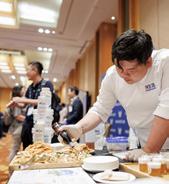
Jack James, CEO and Founder, and Nicola Pontefract, Research Scientist, during Aqua 2024, in Copenhagen, Denmark
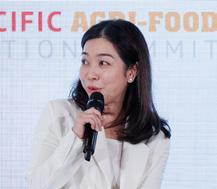



On August 27, TECHNA, organised a half day aqua seminar for its customers from the Mediterranean area (Greece, Türkiye, Tunisia etc). This was alongside Aqua 2024, the combined WAS and EAS conference and trade show, held from August 26-30 in Copenhagen, Denmark.
For more than 60 years, Techna has been focussing on its core expertise: precision nutrition - working hand in hand with livestock farmers in developing highly precise nutritional solutions encompassing predictive performance modelling, and production cost control. It leverages on a strong raw material database, analytical tools, and development of natural alternatives for animal health and performance improvement. Techna’s aquaculture team is bringing this expertise to the fish and shrimp sector, such as on feed formulation, protein utilisation and efficacy in feed based on the latest research (energy, digestibility coefficients, etc). In aquatic health, it is mitigation of white faeces disease, early mortality syndrome and EHP (Enterocytozoon hepatopenaei) in shrimp, and parasitic infections as well as liver health in fish.
The seminar program included two presentations by the team; Pierre Fortin, Aquaculture Manager, presented on phytase and on how they benefit the marine aquaculture industry, and Nicolas Tanrattana, Aquaculture Nutritionist, presented on unlocking the protein potential in aquafeeds to reduce feed costs. Additionally, there was a presentation on fish welfare, the current knowledge, and benefits for production by João L. Saraiva, Fish Ethology and Welfare Group, Centre of Marine Sciences, Portugal.
Screening for phytase for
In aquafeeds, the trend is to replace fish meal with plant proteins such as soybean meal or maize, rice and
November/December 2024
Issue focus: Health and Disease Management
Industry Review: Catfish and Freshwater Fish Feed Enzymes
Deadlines:Articles/Adverts – September 18
many other raw materials as cheaper and more sustainable alternatives to fish meal. However, these plant protein meals contain antinutritional factors such as phytate, a form of phosphorous that is poorly digestible for animals. As more plant protein meals are used in aquafeeds, information on how phytase works in fish is essential.
The target of exogenous phytase inclusion into the formulation is to increase plant phosphorus digestibility for fish growth and control diet-related environment pollution from aquaculture operations. Furthermore, it reduces the need for supplemental phosphorus. The latter is relevant as recently prices of sources of inorganic phosphorus have escalated.
Techna has embarked on a massive study to investigate the effectiveness of 11 phytase enzymes available commercially. The aim was to better understand the efficacy of these sources and apply the information to its formulation matrix when using plant raw materials.
The sequential screening, as explained by Fortin was done in three stages:
• Laboratory tests for 11 commercial phytases,
• In vitro tests for 6 commercial phytases,
• In vivo testing with 3 commercial phytases
The first tests were conducted at three temperatures, 37°C, 25°C and 15°C, to compare between livestock and fish body temperatures. “Every 10-degree difference, we roughly double the reaction time, and we saw that the efficacy of the different phytase enzymes changes with different temperatures,” said Fortin. “The second and third screenings were done with 6 and 3 phytase enzymes selected from the prior screening. To select them, we took into account the performances but we also considered regulatory issues and prices.
“In the in vivo trial, we can see an effect from the phytase on fish growth in diets having low phosphorous levels. But not all phytase reacted the same (as seen in the previous trials). These findings give more insight on the possible use of phytase in aquaculture and valorization you can expect from it,” added Fortin.
Issue focus: Nursery & Hatchery
Industry Review: Marine Shrimp Functional Feeds/Additives/ Controlled Systems
Deadlines: Articles/Adverts – November 22
Email: zuridah@aquaasiapac.com/enquiries@aquaasiapac.com
be

1. The decline in seabream and seabass prices (€/kg) in the Mediterranean in 2023. Graph extracted from the presentation by Nicolas Tanrattana.
respect to ethological challenges, these include spatial, reproduction, aggregation, and socialisation while physiological are pain, diseases, parasites, and stress.
The Techna aqua team, Pierre ForPn (lep), Sophie Reys, R&D Project Manager (second lep), Nicolas Tanra[ana (back row, second lep), speaker João L. Saraiva (fiph from lep) and parPcipants from Greece, Tunisia and Türkiye
Tanrattana said that with low market prices such as for the seabream and seabass in the Mediterranean (Figure 1), there is a need to address rising feed costs and sustainability issues when exploring alternative protein sources. In several trials, Techna has explored partial fish meal replacement with several alternative protein meals with the application of Economix, a blend of plant extracts and amino acids. This is Techna’s solution to decrease reliance on fish meal through enhanced protein digestibility, protein efficiency ratio (PER), feed efficiency and feed intake. In general, diets were reformulated with less fish meal (2%), less protein (1%), with a cost savings of 4%, with no adverse effects on growth performance.
The efficacy of Economix in enhancing digestibility was demonstrated during a trial done in 2020 in SPAROS, Portugal, showing a significant increase in amino acid digestibility when fed to European seabass. The treatment diet had 2% less fish meal than the control diet with more soybean meal and wheat. “While the crude protein level was reduced by 1% there was no difference in digestible protein. Cost of feed was reduced by 1.78%,” emphasised Tanrattana. In a commercial trial in Tunisia with gilthead bream farmed in cages, the feed was reformulated to reduce the protein level by 1% and feed cost by 3%. In an experimental trial with the rainbow trout in France, fish meal level was also reduced by 2% and protein by 1% with no adverse effects on growth and zootechnical performances.
Tanrattana also described some results from trials with the vannamei shrimp in Indonesia and India. The aim of these trials was not to improve zootechnical performances, but rather to reduce feed costs while maintaining the same performances. “In Indonesia we selected palm kernel meal or PKM, characterised by its fibrous nature and moderate protein content and in India, it was rice DDGS as fish meal replacement.” The inclusion of Economix together with alternative plant proteins gave cost reductions of up to 3.87% in Indonesia and 2.5% in India compared to the control diet.
The Fish Ethology and Welfare Group develops sciencebased solutions to improve the welfare of fish by applying ethology or study of animal behaviour. Saraiva said, “With domestication, we push the animal to fit into the environment, which can lead to poor welfare.” He explained that in captivity, the animal will adapt but it is considered poor welfare, when it cannot cope with environmental challenges.
There is a diversity of challenges as the fish develops from the day of hatching to harvest - from environmental, physiological, ethological, and human induced. With
A common question is whether fish can feel pain. The answer is yes, as they have receptors just like human beings. Does this matter? Saraiva said, “It does, since consumers focus on product quality. The demand is from the retailers, consumers, and competent authorities through certification. Greece has introduced a good welfare guide. Precision farming (including better feed and farm management), which is already well established in the livestock industry is coming to aquaculture. However, precision farming is already practised in the salmon industry based on welfare indicators developed by Nofima for the salmon and trout.”
Saraiva discussed the scientific way to make fish welfare measurable. One example is how stress can be measured by heart rate. Stunning is now accepted as the best way to kill fish with limited pain. Asphyxia on ice is not a recommended method as fish remain alive for 40 minutes, and fish quality is degraded with the accumulation of lactic acid in the flesh while electrical shocks are better as it stuns the fish. The Ikejime way of slaughtering is good too as it keeps the fish, such as tuna, in prime quality with limited pain. groupe-techna.com/en



Pierre Fortin said, “Phytase effects differ thus it is important to choose well which enzyme and what valorization could be applied.”
Nicolas Tanrattana showed the efficacy of Economix in enhancing digestibility in trials on the European seabass and reducing feed costs in many contexts.
João L. Saraiva said that fish feel pain and the demand on fish welfare is from retailers, consumers, and competent authorities through certification.

World Aquaculture 2025 China
Qingdao, China April 24-27, 2025
Qingdao, located in the east of Shandong Province, is an international port city known for its significant contributions to marine science, will serve as the venue. It is a major centre for marine research and education, with a strong marine economy and a rich cultural heritage. It has been awarded as one of the Most Ecologically Competitive Cities in China. The Qingdao International Convention Centre is the largest exhibition venue in Shandong Province.
The World Aquaculture Society (WAS) and the Steering Committee of World Aquaculture China 2025 (WA2025) has announced that China will host the WA2025 event from April 24 to 27, 2025, at the Qingdao International Convention Centre, in Qingdao city, China. This marks the return of WA2025 to China since its successful debut in 2002.
Qingdao, China April 24-27, 2025
The event is organized by WAS and the Yellow Sea Fisheries Research Institute (YSFRI) CAFS, hosted by the China Society of Fisheries (CFS), with the support from the National Fisheries Technology Extension Centre (NFTEC), the Chinese Academy of Fisheries Sciences (CAFS), and the State Key Laboratory of Mariculture Biobreeding and Sustainable Goods (BRESG).
The World Aquaculture Society (WAS) and the Steering Committee of World Aquaculture China 2025 (WA2025) has announced that China will host the WA2025 event from April 24 to 27, 2025, at the Qingdao International Convention Centre, in Qingdao city, China. This marks the return of WA2025 to China since its successful debut in 2002.
WA2025 invites aquaculture experts from organisations, institutes, companies, and universities to participate in this three-day international conference and exhibition. Attendees will engage in specialised sessions, explore the latest industry products and services, network with peers, and form valuable partnerships. The conference theme, “Aquaculture Transformation: Action Towards High Quality and Food Security,” will be explored through keynote presentations, panel discussions, interactive sessions, and an exhibition showcasing industry advancements.
Qingdao, located in the east of Shandong Province, is an international port city known for its significant contributions to marine science, will serve as the venue. It is a major cent re for marine research and education, with a strong marine economy and a rich cultural heritage. It has been awarded as one of the Most Ecologically Competitive Cities in China. The Qingdao International Convention Centre is the largest exhibition venue in Shandong Province.
The event is organised by WAS and the Yellow Sea Fisheries Research Institute (YSFRI) CAFS, hosted by the China Society of Fisheries (CFS), with the support from the National Fisheries Technology Extension Centre (NFTEC), the Chinese Academy of Fisheries Sciences (CAFS), and the State Key Laboratory of Mariculture Biobreeding and Sustainable Goods (BRESG).
Abstract submissions are due by January 31, 2025 Companies/organisations interested in organising or sponsoring the special sessions at WA2025, can contact the following. Exhibitors are encouraged to book their booths early, and early registration is recommended to take advantage of reduced rates.
WA2025 invites all aquaculture experts from organisations, institutes, companies, and universities to participate in this three-day international conference and exhibition. Attendees will engage in specialised sessions, explore the latest industry products and services, network with peers, and form valuable partnerships. The conference theme, "Aquaculture Transformation: Action Towards High Quality and Food Security," will be explored through keynote presentations, panel discussions, interactive sessions, a nd an exhibition showcasing industry advancements.
Participation, sponsorship, or exhibiting, www.was. org/email: apcsec@was.org. Conference management inquiries: John Cooksey at worldaqua@was.org. For booth and sponsorship details:Mario Stael at mario@ marevent.com.
Abstract submissions are due by January 31, 2025 Companies/organisations interested in organising or sponsoring the special sessions at WA2025, contact the following below. Exhibitors are encouraged to book their booths early, and early registration is recommended to take advantage of reduced rates.
Participation, sponsorship, or exhibiting, www.was.org/email apcsec@was.org Conference management inquiries: John Cooksey at worldaqua@was.org For booth and sponsorship details:Mario Stael at mario@marevent.com.
Look out for AAP’s annual report on trends in Asia’s production of marine shrimp and aquafeeds
Deadlines -Technical articles
Deadlines - Advert Bookings
Innovations/ Startups
and opinions
Interviews with industry leaders Focus in 2025 will be leaders pushing for sustainable aquaculture
& Hatchery
Marketing
Events
VIV Asia 2025, March 12-14 Bangkok, Thailand March 12-14
VietShrimp International Cantho City, March 26-28 World Aquaculture 2025 China Qingdao, April 24 – 27
Seafood Expo Global Barcelona, Spain May 6-8 Shrimp Aquaculture Conference, Bali, Indonesia, May 21-22
TARS 2025 Shrimp Aquaculture August 20-21
International Aquaculture & Fisheries Expo Taiwan, Taipei September 3-5 For advertising/article contributions and guidelines contact: zuridah@aquaasiapac.com
Global Shrimp Forum 2025, Utrecht, The Netherlands September (TBA)


























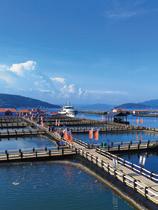








































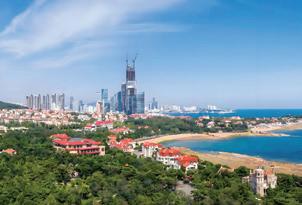

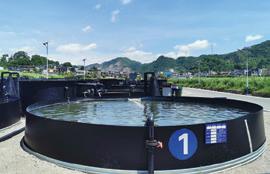































































By Jon Ratcliff
The market size for aquafeed in Asia Pacific region was over US$ 1 billion during 2021 and is forecast to record compound annual growth of 7% through 2022 to 2028.

November 12 – 15, 2024, Bangkok, Thailand
That is good news for the aquafeed industry. However there remain significant challenges in terms of raw material costs and supply, overhead costs such as labour and energy and overall operating efficiency. To remain in this industry it is essential that each plant operates to maximum efficiency in terms of kWh/tonne, manhours/tonne and the true optimisation of the rated capacity of each production line.
critical sections in the production line including; grinding, batching, conditioning and pelleting and extrusion and drying. New this year is greater focus on production management and the tools required for efficient plant production and maintenance.
Aspects of Asian aquafeed production
By Jon Ratcliff
The market size for aquafeed in Asia Pacific region was over US$ 1 billion during 2021 and is forecast to record compound annual growth of 7% through 2022 to 2028.
This includes the latest technologies and innovations for both plant and human resource optimisation together with data capture, display and integration with MES and ERP systems. The programme also includes a visit to one of the larger aquafeed mills in Thailand. The courses are independent and commercially neutral.
That is good news for the aquafeed industry. However there remain significant challenges in terms of raw material costs and supply, overhead costs such as labour and energy and overall operating efficiency. To remain in this industry it is essential that each plant operates to maximum efficiency in terms of kWh/tonne, manhours/tonne and the true optimization of the rated capacity of each production line.
It is not possible to achieve this without investment in automation systems and software that provides real time data capture and analytic displays. That is why the training of staff working within the aqua feed industry has never been so critical. We have seen many times companies that invest in state of the art technology and equipment but fail to utilise them because staff are not trained to understand and interpret the data that is produced.
It is not possible to achieve this without investment in automation systems and software that provides real time data capture and analytic displays. That is why the training of staff working within the aqua feed industry has never been so critical. We have seen many times companies that invest in state of the art technology and equipment but fail to utilise them because staff are not trained to understand and interpret the data that is produced.
They are facilitated by some of the most experienced professionals in the industry committed to sharing their extensive knowledge to a new generation of feed technologists. The presentation format is very interactive to encourage a high level of participant and information exchange as well as daily group workshops.
The Progressus Aqua Feed Milling Agrischool is a comprehensive course covering many aspects of Asian Aqua feed production. The course scheduled for November 12-15, Bangkok, Thailand, provides a complete overview of the feed mill process for both shrimp and fish feeds and the impact of different feed ingredients and formulations combined with a detailed look at the critical sections in the production line including; Grinding, batching, conditioning and pelleting and extrusion and drying. New this year is greater focus on production management and the tools required for efficient plant production and maintenance.
The Progressus Aqua Feed Milling Agrischool is a comprehensive course covering many aspects of Asia’s aquafeed production. The course scheduled for November 12-15, Bangkok, Thailand, provides a complete overview of the feed mill process for shrimp and fish feeds and the impact of different feed ingredients and formulations combined with a detailed look at the
September 24-27
Latin American & & Caribbean
Aquaculture 2024
Medellin, Colombia was.org
March 6-10
Aquaculture 2025 New Orleans, USA was.org
March 12-14
VIV Asia 2025, Bangkok, Thailand vivasia.nl
March 26-28
VietShrimp International Can Tho, Vietnam vietshrimp.net
The registration for Aqua feed milling 2024 is now open.
This includes the latest technologies and innovations for both plant and human resource optimisation together with data capture, display and integration with MES and ERP systems. The programme also includes a visit to one of the larger aquafeed mills in Thailand. The courses are independent and commercially neutral.
Follow this QR CODE to register or contact for more information at info@progressus.asia or www.progressus.asia
They are facilitated by some of the most experienced professionals in the industry committed to sharing their extensive knowledge to a new generation of feed technologists. The presentation format is very interactive to encourage a high level of participant involvement and information exchange as well as daily group workshops.
The registration for Aqua feed milling 2024 is now open.
October 21-24
AQUAEXPO 2024
Guayaquil, Ecuador aquaexpo.com.ec
November 12-15
Bangkok, Thailand, Aqua Feed Milling Agrischool progressus.asia
April 24-27
World Aquaculture 2025 China Qingdao was.org
May 6-8
Seafood Expo Global Barcelona, Spain seafoodexpo.com
May 21-22
Shrimp Aquaculture Conference 2025 Bali, Indonesia sac.pmindo.com
August 20-21
TARS 2025
Shrimp Aquaculture tarsaquaculture.com



November 20-23
AFRAQ24
Hammamet, Tunisia was.org
November 29-30
Conacua 2024
Los Mocchis, Mexico conacua.com
August 21-23
Vietfish 2025 Ho Chi Minh City, Vietnam vietfish.com.vn
September TBA
Global Shrimp Forum 2025 Utrecht, The Netherlands shrimp-forum.com
September 3-5
11th Aquaculture and Fisheries Expo Taiwan (IAFET) 2025
Taipei taiwanagriweek.com/en/
September 22-25
Aquaculture Europe 2025 Valencia, Spain aquaeas.eu

Aquaculture Transformation: Actions Towards High Quality and Food Security
April 24-27, 2025
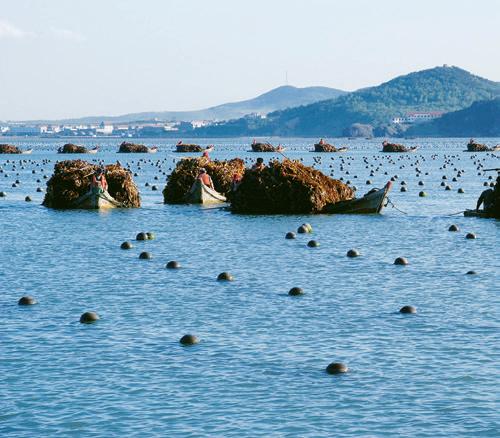
The Annual International Conference and Exposition Qingdao, China














Hosted by World Aquaculture Society (WAS) and China Society of Fisheries (CSF)
Co-hosted by
National Fisheries Technology Extension Center (NFTEC)
Chinese Academy of Fishery Sciences (CAFS) State Key Laboratory of Mariculture Biobreeding and Sustainable Goods (BRESG)

Organized by Yellow Sea Fisheries Research Institute (YSFRI) CAFS and World Aquaculture Society



Conference Sponsors To Be Announced WAS Premier Sponsors







WA25 China info – www.was.org or contact apcsec@was.org; worldaqua@was.org Exhibition, sponsors – mario@marevent.com

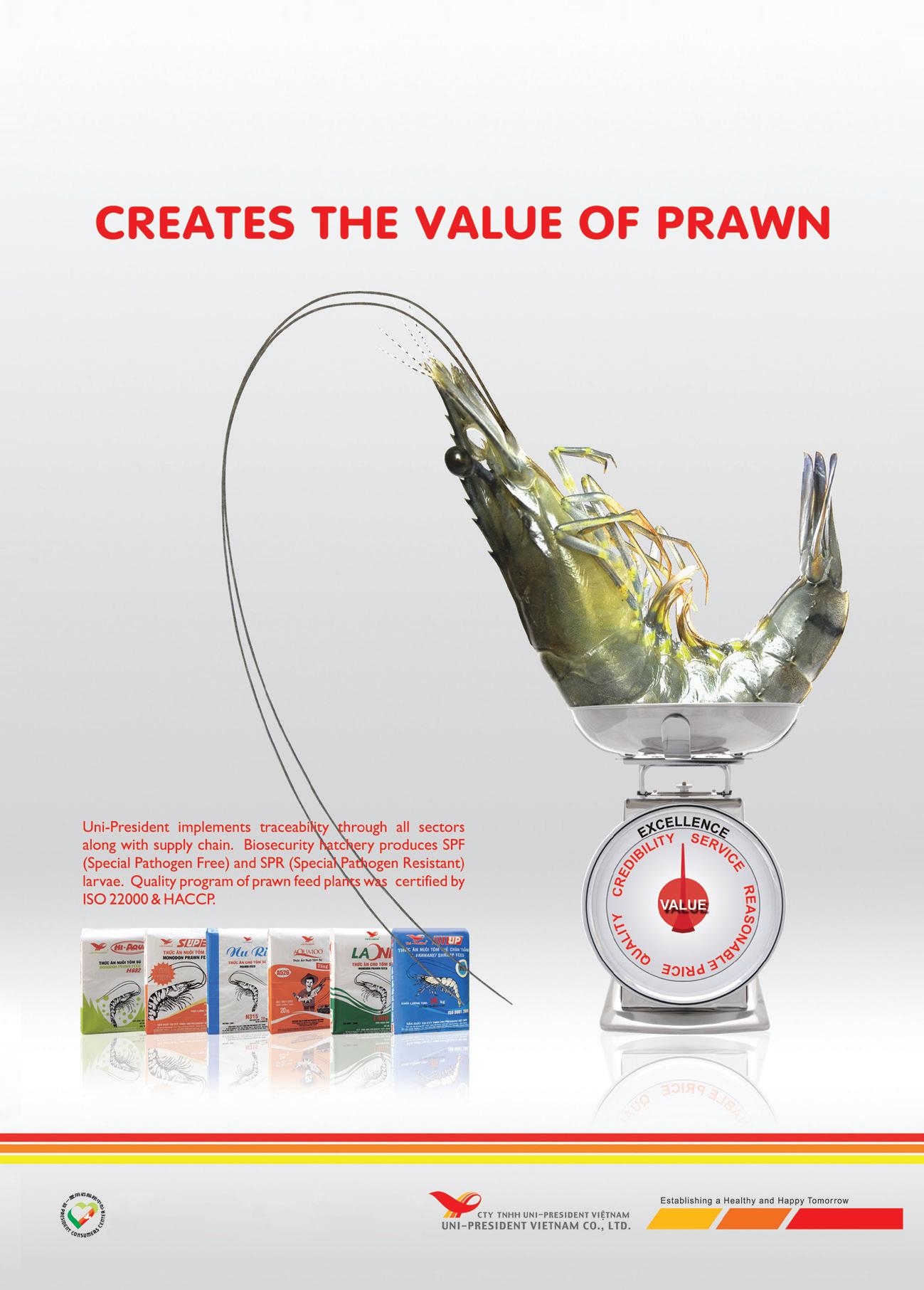
• No.16-18-20, DT743 Road, Song Than II Industrial Zone, Di An Ward, Di An City, Binh Duong Province, Vietnam
• Tel: +84-274-3790811 (Ext: 1711)
• Fax: +84-274-3790819
• Email: aquafeed@upvn.com.vn
